The Gardens of Versailles were designed by André Le Nôtre for King Louis XIV in the late 17th century as part of his Palace of Versailles vision. The gardens feature meticulously manicured lawns, geometric flower beds, grand fountains, and sculptures over 800 hectares in size, reflecting classical French garden style with symmetry and order.
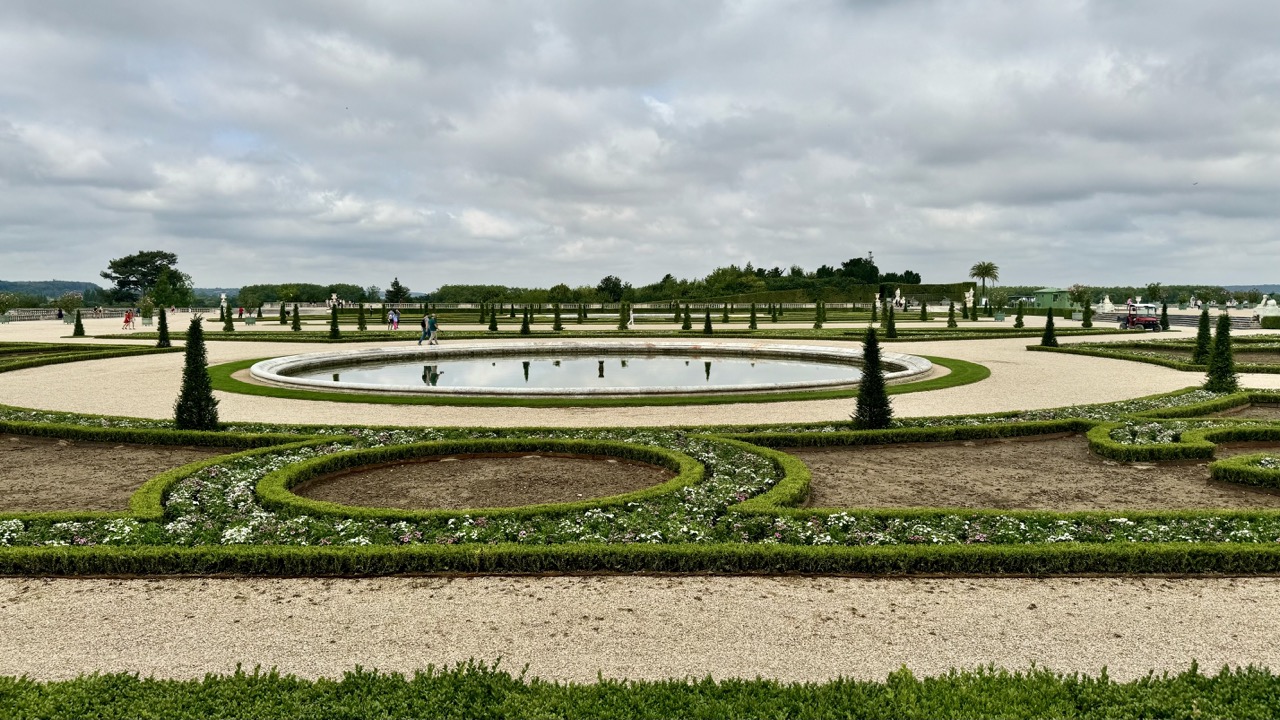
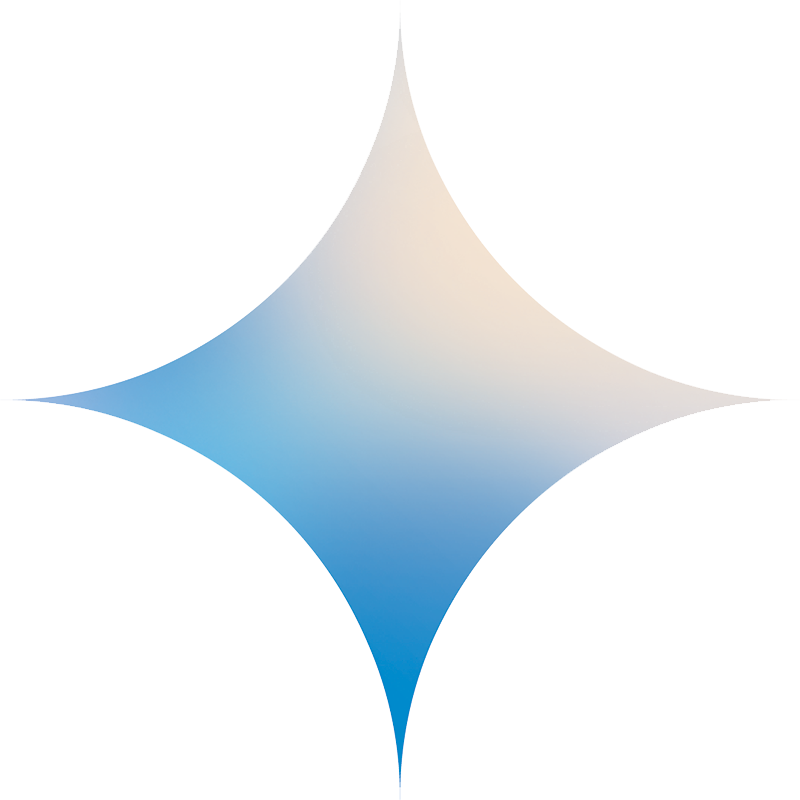
1. Overall Rating (0–10) — 7.0
This photograph captures the grandeur and meticulous symmetry of a formal French garden, evoking a sense of historical elegance and order. The wide perspective emphasizes the scale of the landscape, while the overcast sky lends a soft, contemplative mood. While the scene is visually rich, the lack of strong light or color contrast slightly diminishes its dramatic impact, leaving it more documentary than poetic.
2. Composition (0–10) — 8.0
The image is well-balanced, with the circular fountain anchoring the center and radiating lines of hedges and gravel paths guiding the eye toward the horizon. The layered arrangement of foreground, midground, and background creates depth, and the symmetry reinforces the garden’s classical design.
3. Lighting (0–10) — 6.0
Diffuse light from the overcast sky provides even illumination, minimizing harsh shadows and allowing details in the hedges and gravel to be clearly visible. However, the lack of directional light or dynamic contrast reduces the sense of drama and texture.
4. Color & Tone (0–10) — 6.5
The palette is dominated by soft greens, grays, and beige, which harmonize well with the formal garden aesthetic. While the colors are natural and cohesive, they lack vibrancy, contributing to a muted and somewhat somber tone.
5. Creativity (0–10) — 7.0
The photograph effectively conveys the architectural intent of the garden, emphasizing pattern, repetition, and symmetry. While not particularly innovative in approach, it succeeds in capturing the essence of the space with a respectful and observational eye.
6. Technical Quality (0–10) — 8.0
The image is sharp and well-focused across the frame, with clean details in the hedges, gravel, and water. The exposure is balanced, and there are no noticeable technical flaws such as noise or blur.
7. Emotional Impact (0–10) — 6.5
The scene evokes a sense of calm and timelessness, inviting quiet reflection on human design and nature in harmony. While the emotional resonance is restrained by the subdued lighting and color, the viewer is drawn into the ordered beauty of the space.
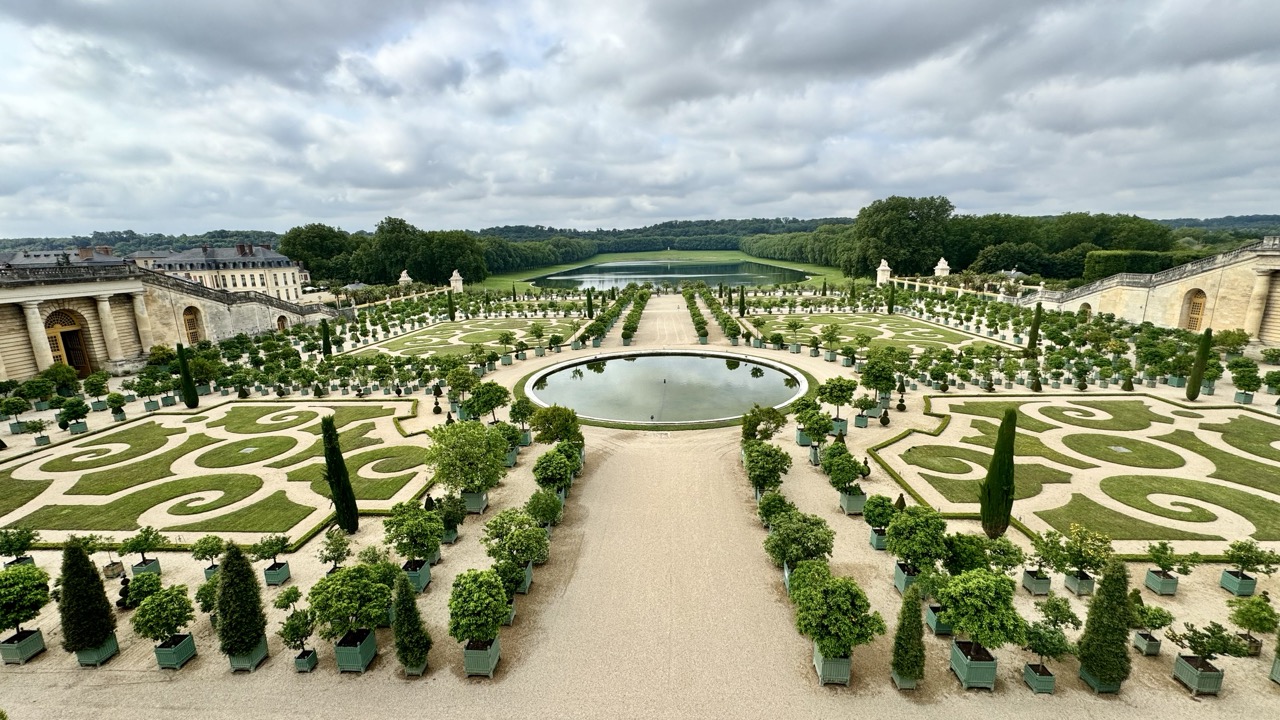

1. Overall Rating (0–10) — 8.0
This photograph captures the grandeur and meticulous order of a formal French garden, where symmetry and design echo centuries of aristocratic refinement. The sweeping vista, anchored by the central basin and flanked by geometric parterres, evokes both tranquility and human mastery over nature. While the overcast sky tempers the scene’s vibrancy, it also lends a contemplative mood, enhancing the timeless elegance of the composition.
2. Composition (0–10) — 9.0
The high vantage point and strong central axis create a powerful sense of symmetry and depth. The radial arrangement of pathways and plantings guides the eye toward the distant lake, while the framing by architectural elements on either side adds balance and scale.
3. Lighting (0–10) — 6.0
Diffused light from the overcast sky softens shadows and evenly illuminates the scene, preserving detail across the landscape. However, the lack of direct sunlight diminishes the texture and warmth of the greenery, resulting in a slightly muted atmosphere.
4. Color & Tone (0–10) — 7.0
The palette of lush greens, sandy gravel, and pale stone creates a harmonious and restrained tonal scheme. The muted tones, while natural, limit visual contrast, though the subtle variation in green hues adds depth to the intricate garden patterns.
5. Creativity (0–10) — 7.5
The image successfully captures the essence of classical garden design, emphasizing order and intentionality. The perspective choice elevates the scene beyond mere documentation, transforming it into a visual meditation on symmetry and control.
6. Technical Quality (0–10) — 8.5
Sharp focus and high resolution reveal fine details in the topiary, stone, and water. The wide-angle lens captures the full scope without significant distortion, maintaining structural integrity across the frame.
7. Emotional Impact (0–10) — 7.5
The image evokes a sense of awe and serenity, inviting reflection on human creativity and the passage of time. The stillness of the water and the quiet precision of the layout inspire a contemplative mood, resonating with viewers who appreciate historical beauty and design.
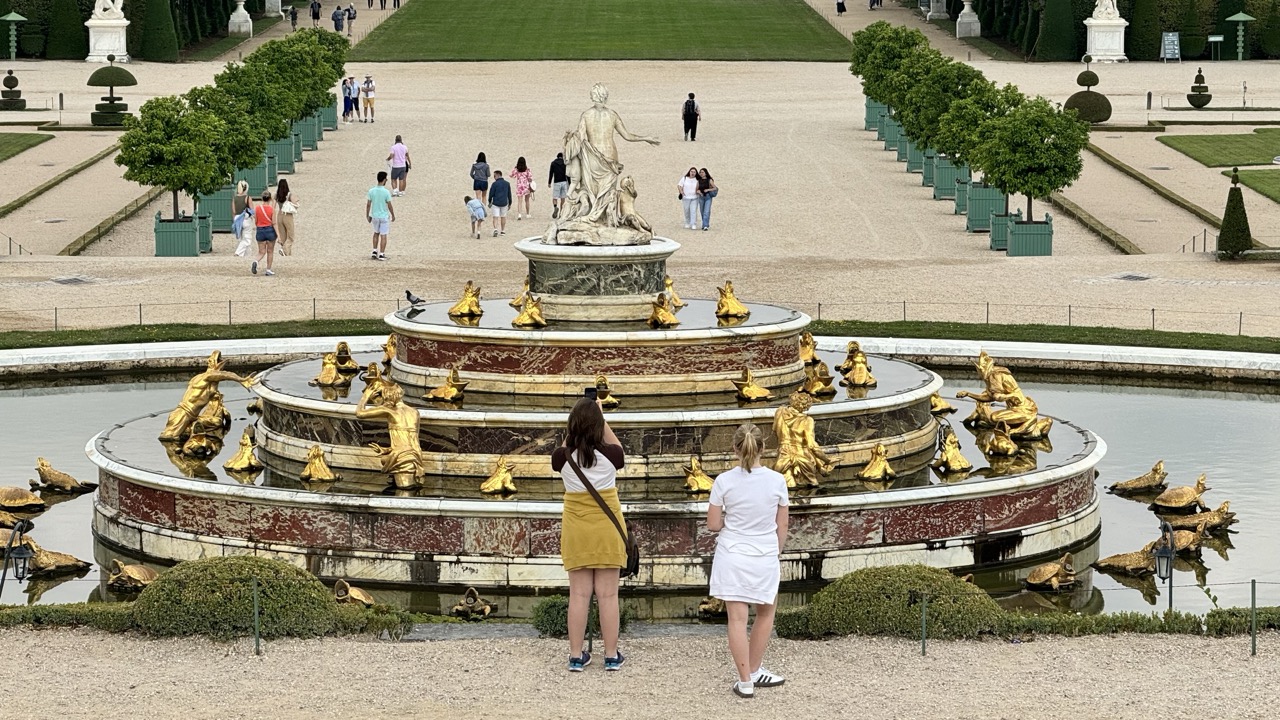

1. Overall Rating (0–10) — 7.0
This photograph captures the grandeur of the Versailles Gardens with a compelling blend of historical opulence and contemporary life. The central fountain, adorned with golden figures, serves as a striking focal point, while the presence of visitors grounds the scene in reality, creating a dialogue between past and present. The composition effectively conveys the scale and order of the landscape, though the overcast lighting slightly dampens the richness of the gold and marble, limiting the image’s visual dynamism.
2. Composition (0–10) — 7.5
The layered tiers of the fountain create a strong sense of depth, drawing the eye from the foreground figures to the distant statue and manicured grounds. The symmetry of the garden paths enhances balance, though the slightly off-center placement of the fountain introduces a subtle tension that keeps the image from feeling overly rigid.
3. Lighting (0–10) — 6.0
The diffuse, overcast light softens shadows and evenly illuminates the scene, preserving detail across the entire frame. While this prevents harsh contrasts and highlights the intricate textures of the fountain, it also tempers the vibrancy of the golden sculptures, diminishing their luminous quality.
4. Color & Tone (0–10) — 6.5
The muted greens of the hedges and the pale gray of the sky create a restrained palette, allowing the golden figures to stand out as visual anchors. The warm tones of the marble and bronze provide a subtle contrast to the cooler background, though the overall tonality leans toward neutrality.
5. Creativity (0–10) — 7.0
The juxtaposition of modern tourists with the grand classical architecture offers a fresh narrative lens, transforming a familiar landmark into a living, breathing space. The framing from a slightly elevated vantage point adds depth and perspective, emphasizing both human scale and architectural monumentality.
6. Technical Quality (0–10) — 8.0
The image is sharp and well-focused, with clean detail visible in the fountain’s sculptures and the surrounding foliage. The exposure is balanced, avoiding blown highlights or lost shadows, and the resolution captures the intricacies of the scene without digital noise.
7. Emotional Impact (0–10) — 6.5
The photograph evokes a sense of awe and quiet contemplation, inviting the viewer to reflect on the enduring legacy of human artistry and the passage of time. The presence of people adds a layer of relatability, grounding the grandeur in everyday experience and fostering a connection between viewer and place.
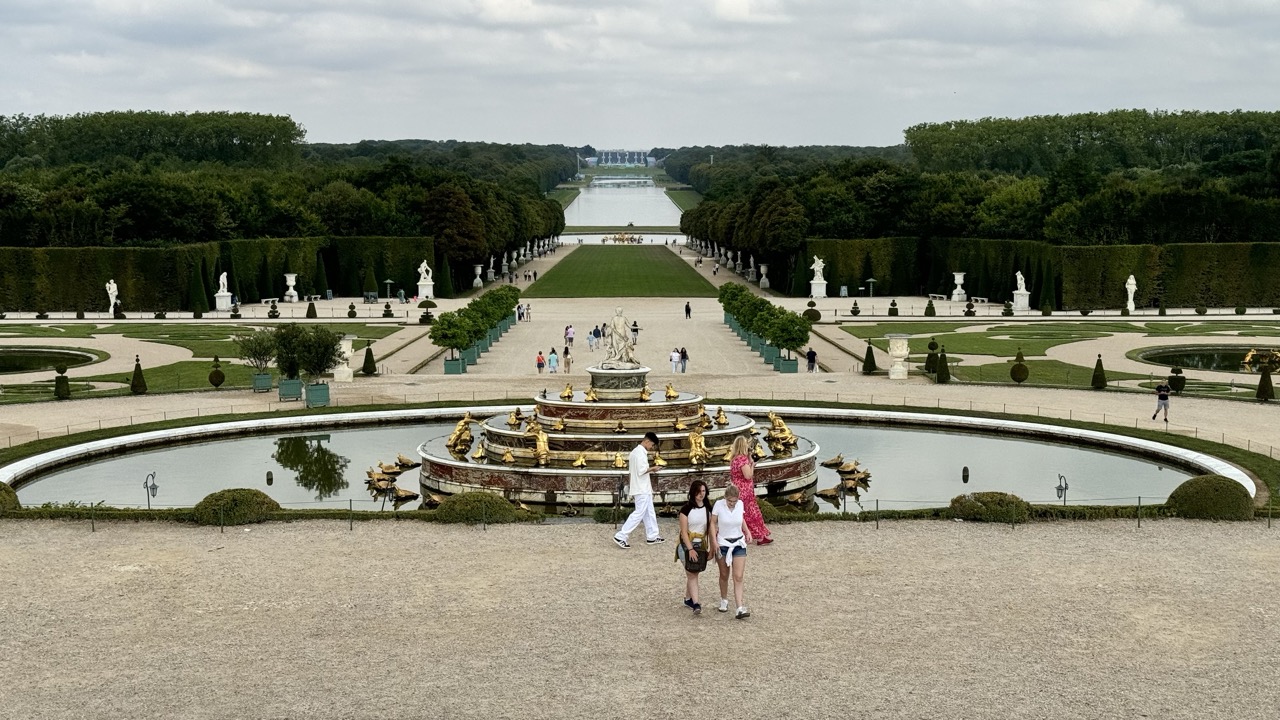

1. Overall Rating (0–10) — 7.5
This photograph captures the grandeur and symmetry of the Gardens of Versailles with striking clarity, emphasizing both the architectural precision and the human scale within the monumental landscape. The wide perspective allows the viewer to appreciate the vastness of the formal gardens, while the presence of visitors grounds the scene in lived experience. While the overcast sky tempers the visual drama, the composition's strength lies in its ability to balance historical elegance with the quiet presence of modern life.
2. Composition (0–10) — 8.0
The image is masterfully composed with strong leading lines from the central axis of the garden, drawing the eye toward the distant canal and the horizon. The fountain in the foreground anchors the frame, while the symmetrical arrangement of hedges, statues, and pathways creates a sense of order and harmony. The placement of the people adds rhythm and scale without disrupting the balance.
3. Lighting (0–10) — 6.0
The soft, diffused light of an overcast day minimizes harsh shadows and allows for even exposure across the scene. While this creates a calm, neutral mood, it also reduces the richness of textures and depth, giving the image a slightly flat quality. The lack of strong sunlight prevents the golden elements of the fountain from truly shining.
4. Color & Tone (0–10) — 6.5
The palette is dominated by the muted greens of the hedges and the gray of the overcast sky, creating a subdued atmosphere. The gold accents on the fountain provide a striking contrast, though they are somewhat muted by the lighting. The overall tonal range is limited, with a lack of deep shadows or bright highlights to add visual interest.
5. Creativity (0–10) — 7.0
The image successfully captures the iconic symmetry and scale of Versailles, presenting a familiar view in a fresh way through the inclusion of visitors. The perspective emphasizes the garden’s grand design while subtly reminding viewers of its function as a public space. While not radically original, the composition reflects a thoughtful interpretation of a classic subject.
6. Technical Quality (0–10) — 8.0
The photograph is sharp and well-focused throughout, with clean details in the fountain, statues, and surrounding hedges. The exposure is balanced, and there are no visible technical flaws such as motion blur or noise. The wide-angle perspective is handled effectively, capturing the expansive layout without excessive distortion.
7. Emotional Impact (0–10) — 7.0
The image evokes a sense of awe and reverence for the beauty and ambition of the gardens, while also conveying a quiet contemplation of history and time. The presence of people adds a human element, inviting viewers to imagine themselves within the scene. The mood is reflective and serene, though slightly restrained by the lack of dramatic lighting.
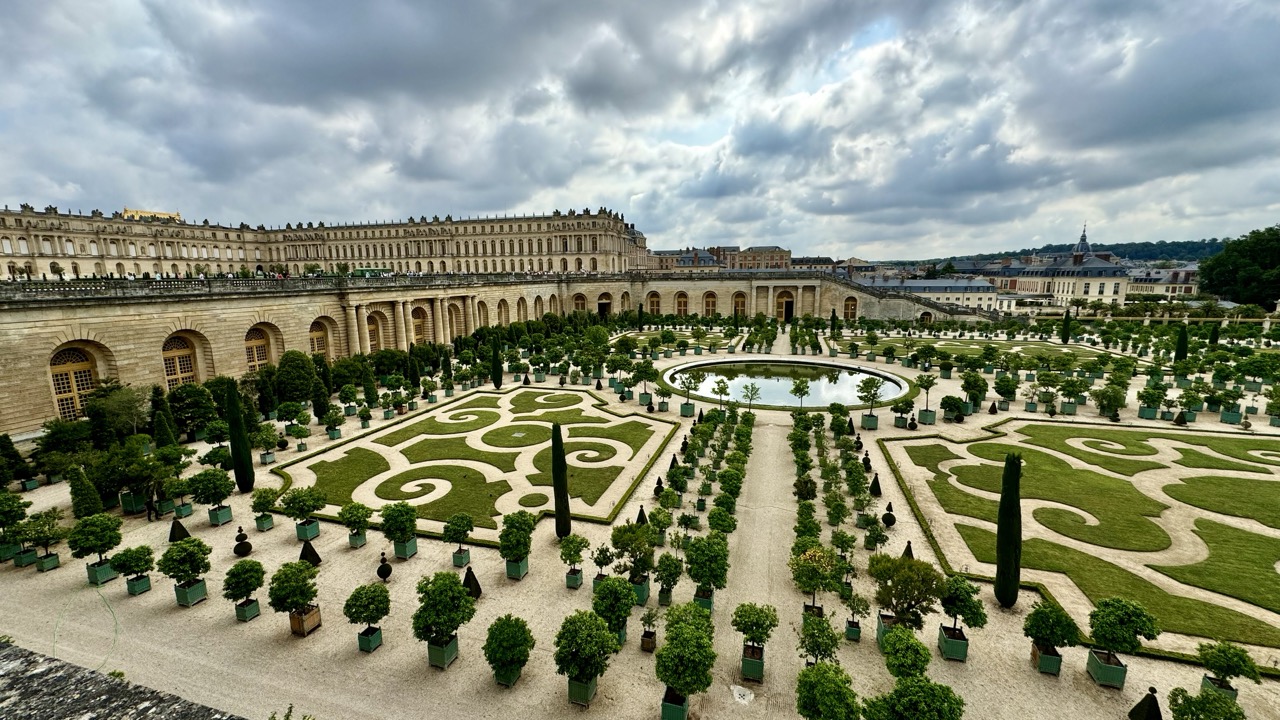

1. Overall Rating (0–10) — 8.0
This photograph captures the grandeur and meticulous order of the Versailles Gardens under a brooding sky, where the tension between human design and natural atmosphere creates a compelling visual narrative. The sweeping composition and the interplay of symmetry, texture, and scale evoke both the opulence of the palace and the quiet melancholy of an overcast day. While the image is rich in detail and narrative weight, a slightly more dynamic lighting moment might elevate its emotional resonance.
2. Composition (0–10) — 9.0
The wide-angle perspective effectively captures the expansive layout of the gardens, with the central pathways and parterres leading the eye toward the palace. The diagonal lines of the gravel paths and the circular pool create a strong sense of depth and rhythm, while the placement of the palace along the horizon grounds the composition with architectural authority.
3. Lighting (0–10) — 7.0
The diffused light from the cloudy sky softens shadows and evenly illuminates the scene, allowing the intricate patterns of the gardens to be clearly visible. While the lighting lacks the dramatic contrast of direct sunlight, it enhances the moodiness of the overcast sky and complements the formal, stately nature of the setting.
4. Color & Tone (0–10) — 7.5
The palette is dominated by rich greens and earthy beige tones, with the cool gray of the sky providing a subtle contrast. The color harmony is strong, with the repetition of green and stone creating a cohesive visual rhythm. A slight increase in saturation could enhance the vibrancy of the foliage, but the current tone supports the image’s contemplative mood.
5. Creativity (0–10) — 8.0
The photographer’s choice to capture the gardens from a high vantage point emphasizes the geometric precision and scale of the landscape, transforming a well-known landmark into a study of symmetry and order. The juxtaposition of the manicured grounds against the turbulent sky introduces a layer of poetic tension, suggesting both control and the inevitability of nature.
6. Technical Quality (0–10) — 8.5
The image is sharp and detailed, with excellent clarity throughout the frame. The focus is consistent from foreground to background, and the exposure is well-balanced, capturing the nuances of both the light and shadow areas without harsh clipping.
7. Emotional Impact (0–10) — 8.0
The image evokes a sense of awe and quiet introspection, inviting the viewer to reflect on the legacy of human ambition and the passage of time. The combination of architectural grandeur and atmospheric tension creates a powerful emotional resonance, making the scene feel both majestic and contemplative.
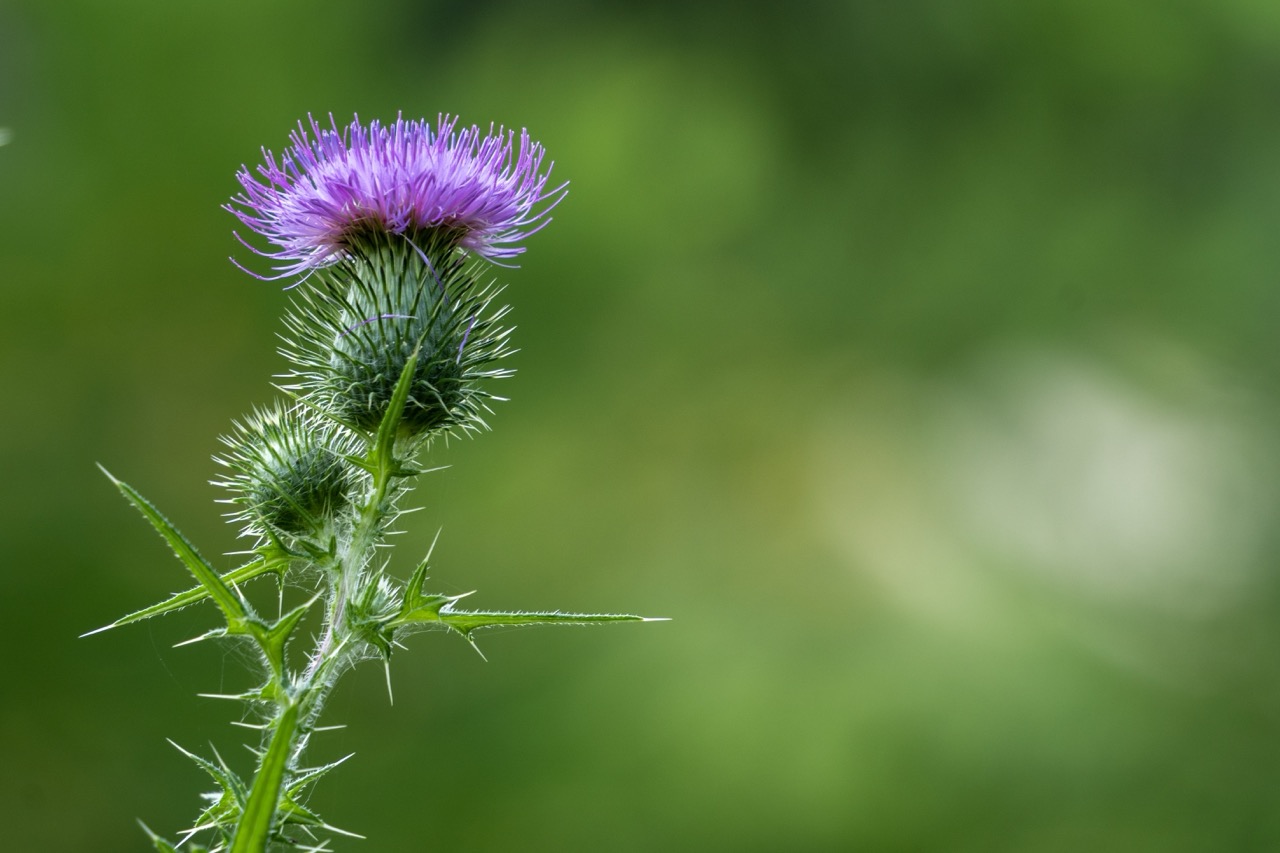

1. Overall Rating (0–10) — 8.0
This image captures the delicate yet defiant beauty of a thistle in full bloom, where nature’s resilience is rendered with striking clarity. The soft focus background and sharp subject placement create a serene, almost painterly quality, emphasizing the flower’s intricate textures. While the composition is strong and emotionally resonant, the simplicity of the palette slightly limits its visual dynamism.
2. Composition (0–10) — 8.5
The thistle is positioned along the left third of the frame, creating a balanced and visually engaging asymmetry. The negative space on the right enhances the sense of stillness and allows the viewer’s eye to rest on the subject’s detailed form.
3. Lighting (0–10) — 8.0
Natural, diffused light softly illuminates the thistle, highlighting the fine hairs and spines without harsh shadows. The gentle glow enhances the flower’s purple hues and gives the image a calm, organic feel.
4. Color & Tone (0–10) — 7.5
The vibrant purple of the thistle contrasts beautifully with the lush green background, creating a harmonious and natural palette. While the colors are true to life, a touch more saturation could heighten the emotional impact.
5. Creativity (0–10) — 8.0
The choice to focus on a thistle—a symbol of both beauty and defiance—adds narrative depth. The macro perspective transforms an ordinary plant into a subject of quiet elegance, demonstrating thoughtful artistic intent.
6. Technical Quality (0–10) — 9.0
Exceptional sharpness on the thistle, with precise focus and clean depth of field. The image is technically flawless, with no visible noise or blur.
7. Emotional Impact (0–10) — 7.5
The image evokes a sense of quiet strength and natural grace, inviting reflection on the beauty found in overlooked elements of the wild. It feels intimate and meditative, though not overtly dramatic.
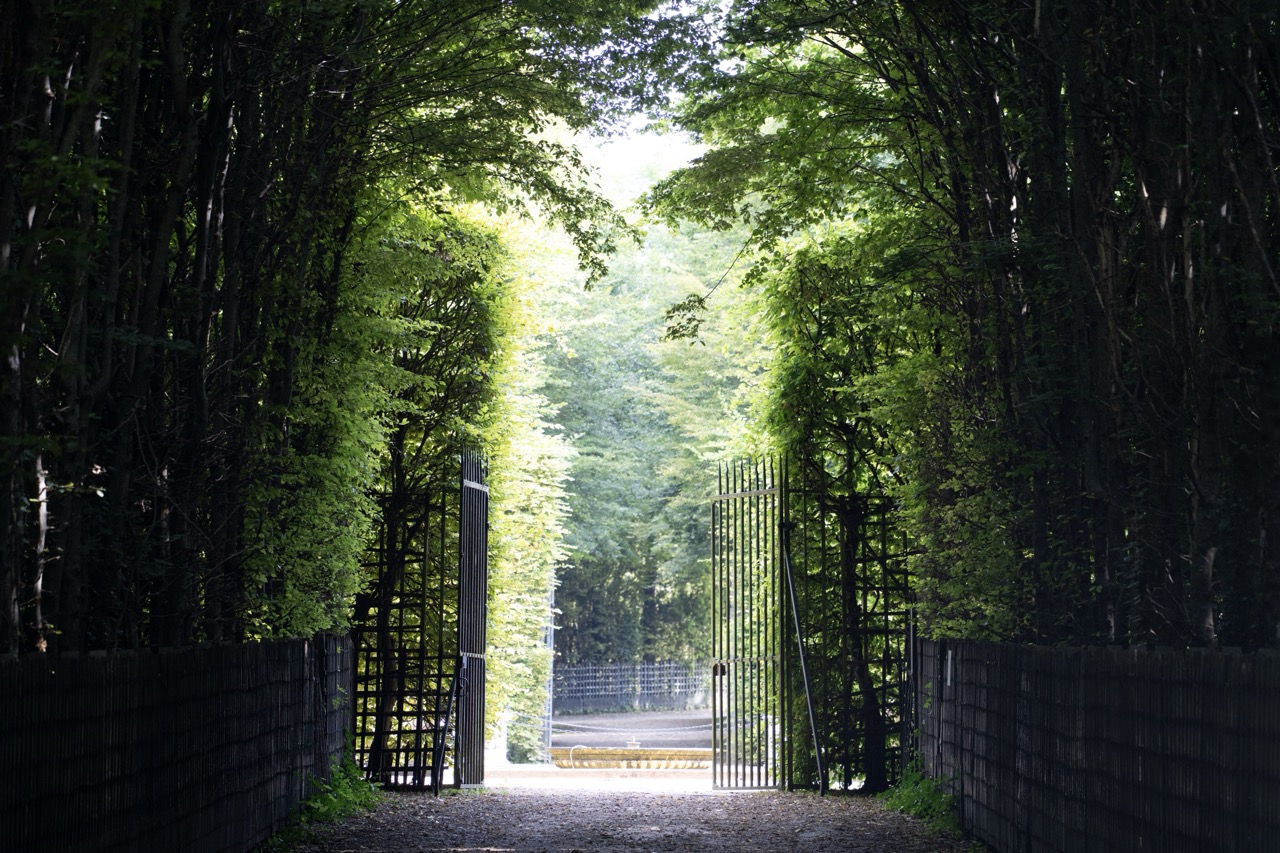

1. Overall Rating (0–10) — 7.5
This photograph captures a serene and inviting passage through a lush, sun-dappled grove, where nature and structure converge in quiet harmony. The interplay of light and shadow, along with the symmetrical framing, evokes a sense of mystery and anticipation, as if leading the viewer toward an undiscovered realm. While the image is visually compelling and rich in atmosphere, it slightly lacks tonal depth in the darkest areas, which softens its overall impact.
2. Composition (0–10) — 8.0
The strong central alignment of the gate and path creates a powerful sense of depth and direction. The symmetrical framing of the trees enhances the composition’s balance and guides the eye naturally toward the bright opening in the distance.
3. Lighting (0–10) — 7.5
The backlighting from the opening creates a dramatic contrast between the dark, shaded foreground and the bright, sunlit clearing beyond. The light filters gently through the canopy, adding texture and depth, though some highlights appear slightly overexposed.
4. Color & Tone (0–10) — 7.0
The palette is dominated by rich, verdant greens and deep shadows, creating a natural and immersive tone. While the colors are fresh and vibrant, the lack of warm tones and subtle gradation in the darker regions slightly reduces the image’s atmospheric richness.
5. Creativity (0–10) — 8.0
The photograph’s strength lies in its evocative narrative—suggesting a journey, transition, or hidden sanctuary. The juxtaposition of the man-made gate within a natural archway adds a layer of poetic symbolism, enhancing the image’s conceptual depth.
6. Technical Quality (0–10) — 7.5
The image is sharp and well-focused, with clean detail in the foliage and gate. However, the dynamic range is slightly limited, with some loss of detail in the shadows and blown-out highlights in the bright background.
7. Emotional Impact (0–10) — 8.0
The photograph conveys a quiet sense of wonder and peaceful contemplation, inviting the viewer to imagine what lies beyond the gate. The interplay of light and shadow, combined with the stillness of the scene, evokes a meditative and almost sacred atmosphere.
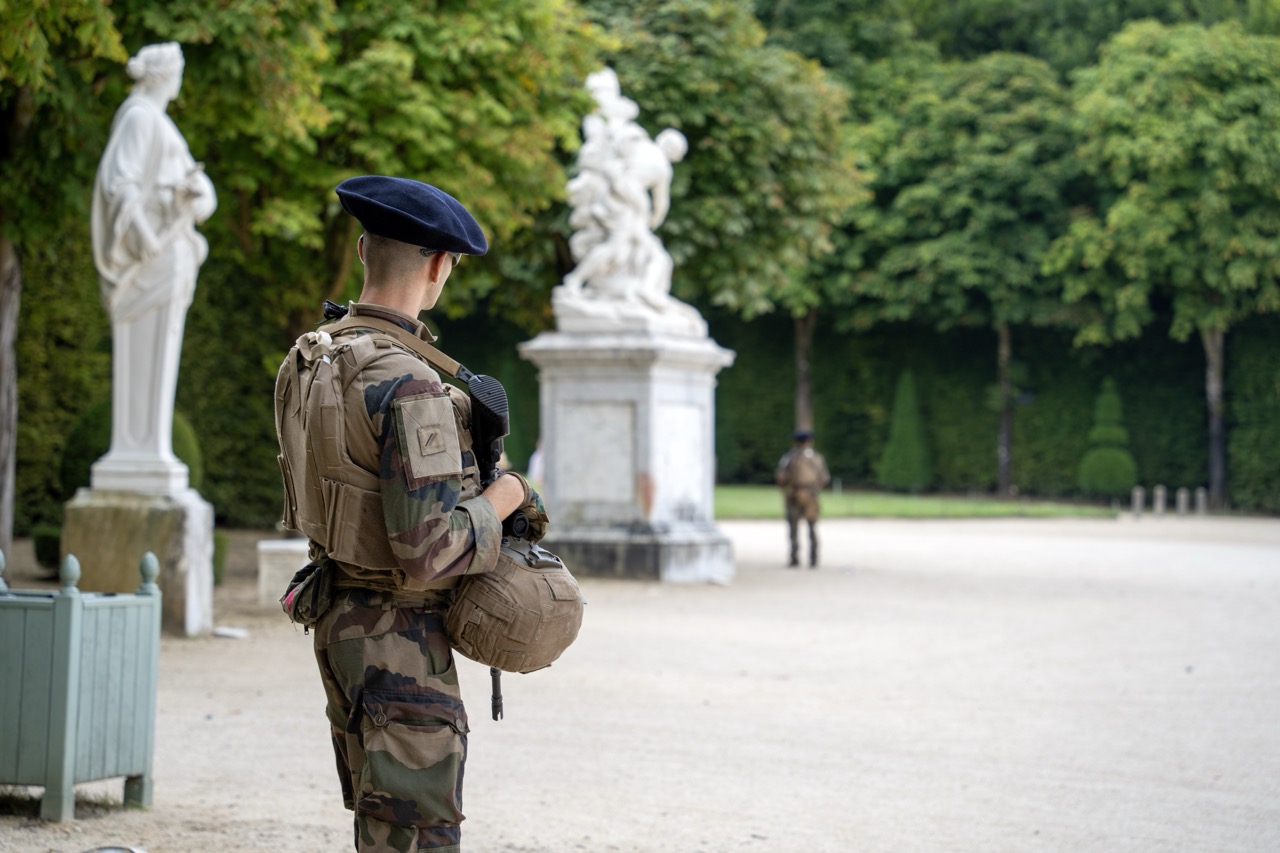

1. Overall Rating (0–10) — 7.5
This photograph captures a striking juxtaposition between modern military presence and classical European grandeur, creating a contemplative tension between duty and history. The soldier’s posture and gear contrast sharply with the ornate statues and manicured gardens, evoking a sense of solemn vigilance. While the image succeeds in conveying narrative depth, the muted lighting and soft focus slightly diminish its visual impact.
2. Composition (0–10) — 7.0
The soldier is framed off-center, drawing the eye toward the depth of the scene, while the statues create a visual rhythm leading into the background. The use of shallow depth of field emphasizes the foreground subject while blurring the distant figure, enhancing focus and narrative layering.
3. Lighting (0–10) — 6.5
Natural, diffused daylight provides even illumination, preserving detail in both the soldier’s uniform and the surrounding foliage. However, the lack of strong directional light results in a somewhat flat and subdued atmosphere, reducing the dramatic potential of the scene.
4. Color & Tone (0–10) — 7.0
The palette balances earthy greens and browns of the military gear with the crisp white of the statues and the soft greens of the trees. The tonal harmony is effective, though the overall coolness and desaturation lend a restrained, almost melancholic tone.
5. Creativity (0–10) — 8.0
The conceptual contrast between soldier and sculpture is compelling and thoughtfully executed. The image transcends mere documentation, suggesting themes of protection, legacy, and the weight of history—offering a layered narrative that invites interpretation.
6. Technical Quality (0–10) — 7.5
Sharp focus on the foreground soldier ensures clarity in texture and detail, while the background remains softly blurred, demonstrating good control over depth of field. The image is well-exposed and free of technical flaws.
7. Emotional Impact (0–10) — 7.0
The image evokes a quiet solemnity and a sense of duty in a place of cultural significance. The viewer is left to reflect on the intersection of power, tradition, and protection, creating a subtle but lasting emotional resonance.
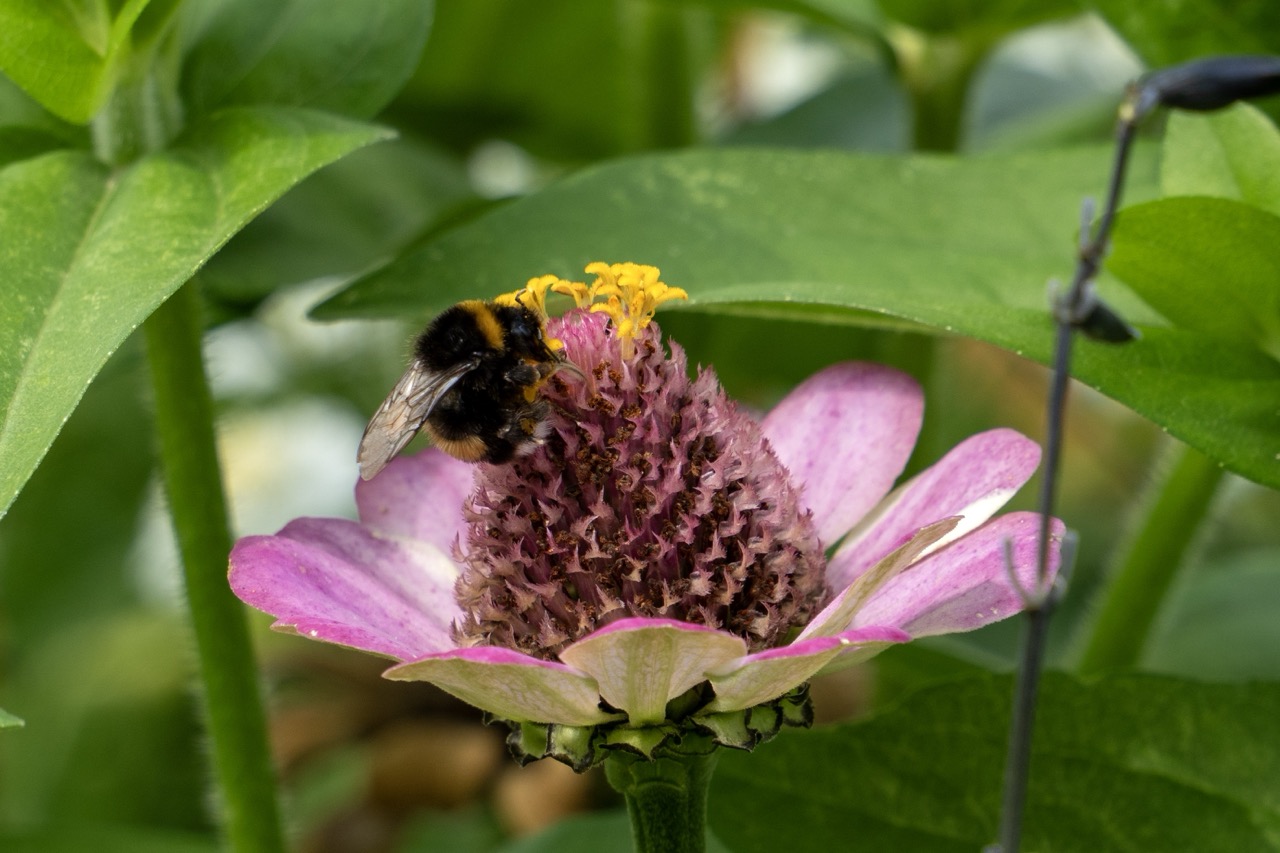

1. Overall Rating (0–10) — 8.0
This photograph captures a moment of quiet intimacy between a bumblebee and a zinnia, where nature’s intricate details unfold in vivid clarity. The shallow depth of field beautifully isolates the subject, drawing the eye to the bee’s delicate interaction with the flower’s textured center. While the composition is strong and the moment compelling, a slightly more dynamic angle or tighter crop might elevate the image from documentary to evocative.
2. Composition (0–10) — 7.5
The bee is positioned slightly off-center, creating a natural flow that guides the viewer’s gaze across the flower. The surrounding greenery provides a soft, blurred backdrop that enhances focus on the subject, though the right-side stem introduces a minor visual distraction.
3. Lighting (0–10) — 8.0
Natural, diffused daylight softly illuminates the scene, highlighting the fine hairs on the bee and the delicate texture of the flower without harsh shadows. The even lighting enhances detail and contributes to the image’s calm, organic mood.
4. Color & Tone (0–10) — 8.5
The vibrant pink of the zinnia contrasts beautifully with the bright yellow center and the deep green foliage. The rich, saturated tones feel natural yet lively, creating a visually harmonious palette that underscores the vitality of the moment.
5. Creativity (0–10) — 7.0
The image is a strong example of macro nature photography, capturing a familiar scene with clarity and care. While the subject matter is common, the attention to detail and composition elevate it beyond a simple snapshot into something more contemplative.
6. Technical Quality (0–10) — 9.0
Exceptionally sharp focus on the bee and flower center, with smooth background bokeh and precise depth control. The image is free of noise and artifacts, demonstrating strong technical execution.
7. Emotional Impact (0–10) — 7.5
The photograph evokes a sense of stillness and connection with the natural world, inviting the viewer to pause and appreciate the quiet beauty of a fleeting interaction. The intimacy of the moment resonates emotionally, fostering a quiet awe for the unseen lives of pollinators.
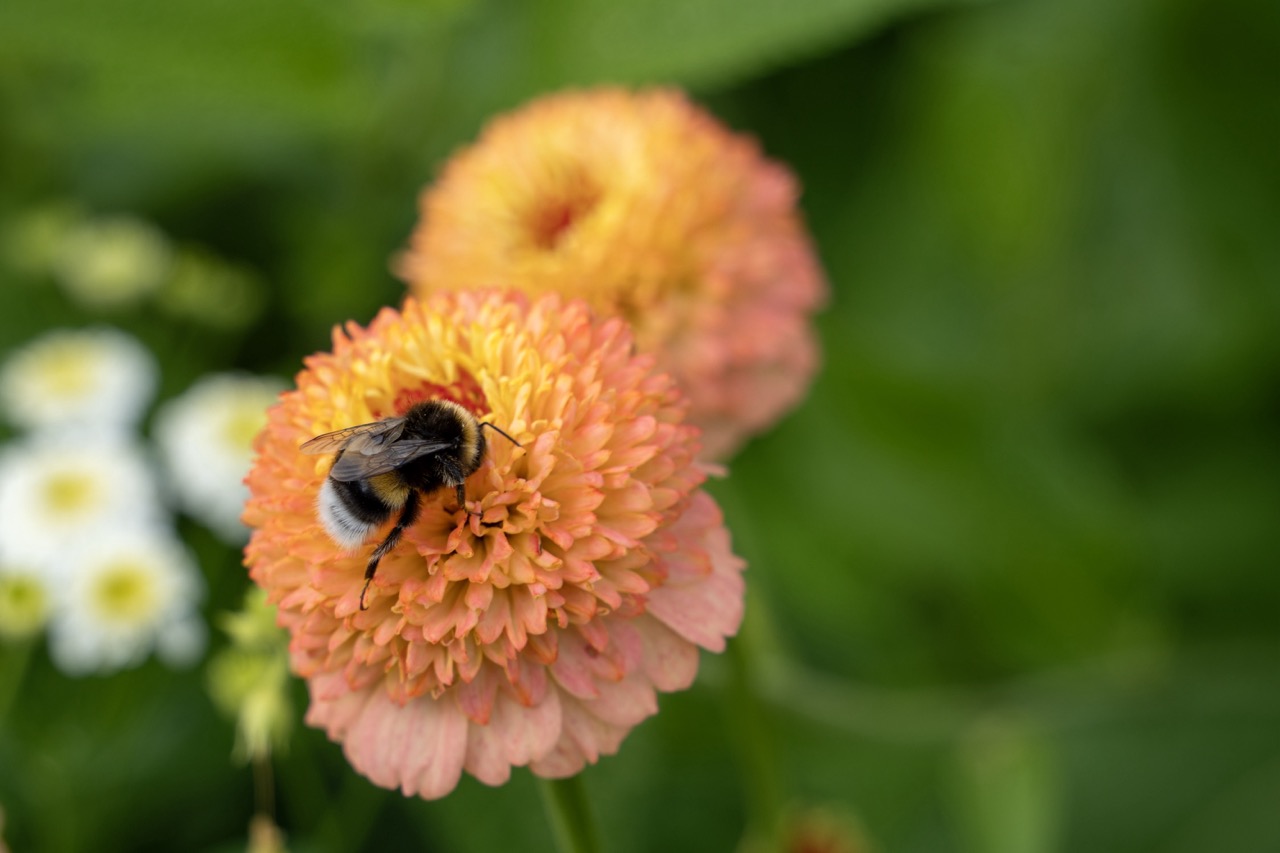

1. Overall Rating (0–10) — 8.0
This photograph captures a serene moment of natural interaction, where the bumblebee’s delicate engagement with the flower radiates quiet vitality. The shallow depth of field isolates the subject with painterly precision, while the warm, soft tones evoke a sense of gentle stillness. The image excels in intimacy and detail, though its simplicity slightly limits narrative complexity.
2. Composition (0–10) — 8.0
The bee and flower are placed slightly off-center, creating a dynamic yet balanced composition. The use of leading lines from the petals guides the eye naturally toward the subject, while the blurred background enhances focus without distraction.
3. Lighting (0–10) — 8.5
Soft, diffused natural light illuminates the scene evenly, highlighting the texture of the bee’s fur and the delicate layers of the flower. The gentle glow enhances the organic feel and avoids harsh shadows, contributing to a calm, inviting mood.
4. Color & Tone (0–10) — 8.0
The warm peach and yellow tones of the flower contrast beautifully with the cool green background, creating a harmonious and visually pleasing palette. The subtle color transitions and natural saturation lend depth and richness to the image.
5. Creativity (0–10) — 7.5
The photographer captures a familiar subject with fresh sensitivity, emphasizing the quiet poetry of a fleeting moment. The choice to focus tightly on the interaction elevates a simple scene into a meditative study of nature.
6. Technical Quality (0–10) — 9.0
The image is sharply focused on the bee and foreground flower, with smooth bokeh that enhances depth. The camera’s handling of detail and focus is precise, showcasing technical mastery in macro photography.
7. Emotional Impact (0–10) — 8.5
The image evokes a sense of peace and wonder, inviting the viewer to pause and appreciate the quiet beauty of small life. The intimacy of the moment fosters a deep connection to nature and the subtle rhythms of the natural world.
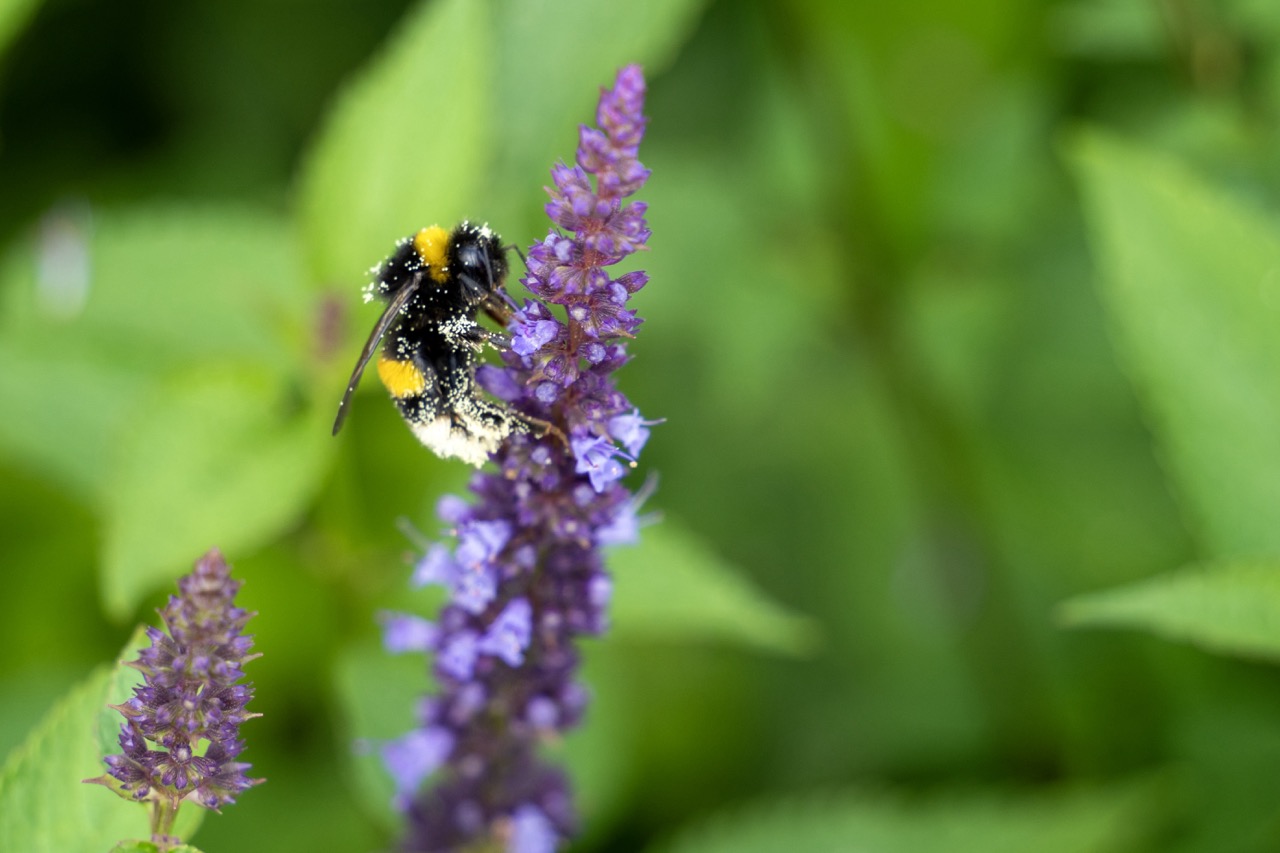

1. Overall Rating (0–10) — 8.0
This photograph captures a delicate moment of natural interaction, where the vibrant purple flower and the pollen-dusted bumblebee form a striking focal point against a softly blurred green backdrop. The shallow depth of field beautifully isolates the subject, enhancing the sense of intimacy and quiet motion. While the composition is strong and the subject matter inherently engaging, the image’s emotional resonance could be deepened with a slightly more dynamic angle or a stronger contrast between the bee’s coloration and the floral tones.
2. Composition (0–10) — 8.0
The bee is placed slightly off-center along the vertical axis, following the rule of thirds and drawing the eye naturally through the frame. The diagonal line of the flower stem adds movement, while the blurred background ensures the subject remains dominant without distraction.
3. Lighting (0–10) — 8.0
Soft, diffused natural light illuminates the scene evenly, preserving fine details on the bee’s fuzzy body and the delicate texture of the flower. The light enhances the natural colors without creating harsh shadows or overexposed highlights.
4. Color & Tone (0–10) — 8.0
The rich purple of the flower contrasts beautifully with the black and yellow of the bumblebee and the lush green foliage. The color palette is harmonious and vibrant, with a natural balance that feels both fresh and inviting.
5. Creativity (0–10) — 7.5
The image captures a common nature scene with a sense of quiet elegance, but its strength lies in its execution rather than originality. The choice to focus on the pollen-laden bee introduces a subtle narrative of pollination and life, elevating the photograph beyond a simple snapshot.
6. Technical Quality (0–10) — 8.5
The focus is precise on the bee and flower, with excellent sharpness in the foreground while the background dissolves into a smooth bokeh. The exposure is well-balanced, and there is minimal noise, indicating a high level of technical control.
7. Emotional Impact (0–10) — 7.0
The image evokes a sense of wonder and tranquility, inviting the viewer to pause and appreciate the small, intricate moments of the natural world. While it doesn’t provoke intense emotion, it offers a peaceful and contemplative experience.
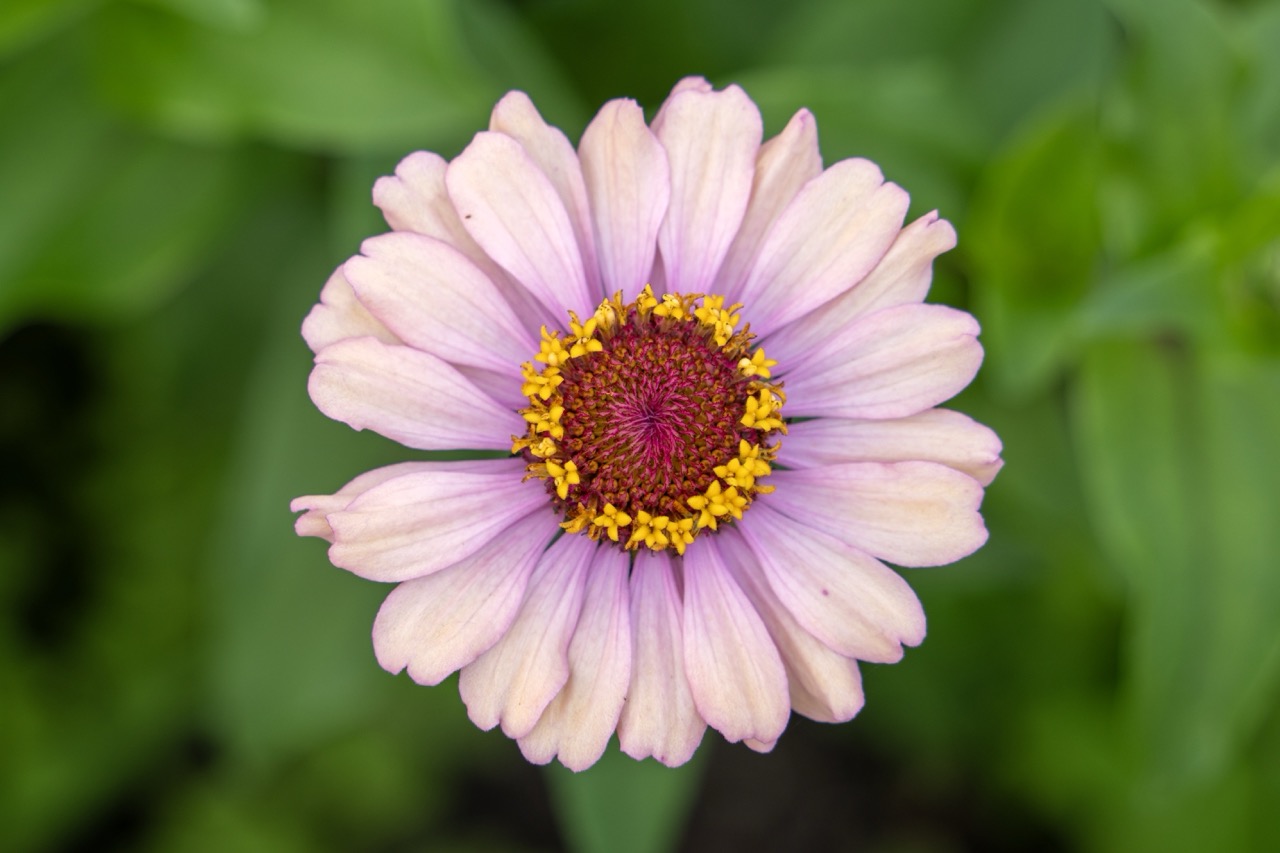

1. Overall Rating (0–10) — 8.0
This photograph captures the delicate elegance of a zinnia in full bloom, its soft pink petals radiating outward like a natural mandala. The shallow depth of field isolates the flower beautifully, drawing the eye to its intricate center while the lush green backdrop enhances its organic grace. While the image is visually pleasing and technically sound, it holds a restrained emotional weight—more a study in form than in feeling.
2. Composition (0–10) — 8.0
The flower is centered with precision, creating a balanced and harmonious focal point. The soft blur of the surrounding foliage enhances the subject’s prominence without distracting from the natural symmetry of the bloom.
3. Lighting (0–10) — 8.5
Natural, diffused light illuminates the flower evenly, highlighting the subtle gradients in the petals and the texture of the yellow stamens. The absence of harsh shadows lends a soft, serene quality to the image.
4. Color & Tone (0–10) — 8.0
The pastel pink of the petals contrasts gently with the vibrant yellow center and deep green background, creating a rich, natural palette. The tones are well-balanced and harmonious, with a slight warmth that enhances the organic feel.
5. Creativity (0–10) — 7.0
While the image is technically strong and aesthetically pleasing, it follows a classic floral photography trope—familiar and beautifully executed, but lacking in conceptual surprise or narrative depth.
6. Technical Quality (0–10) — 9.0
The focus is sharp on the flower’s center, with smooth bokeh in the background. The image is clear, noise-free, and well-exposed, showcasing a high level of photographic control.
7. Emotional Impact (0–10) — 7.5
The photograph evokes a sense of calm and quiet beauty, inviting the viewer to pause and appreciate the delicate complexity of nature. It feels intimate and meditative, though not overwhelmingly stirring.
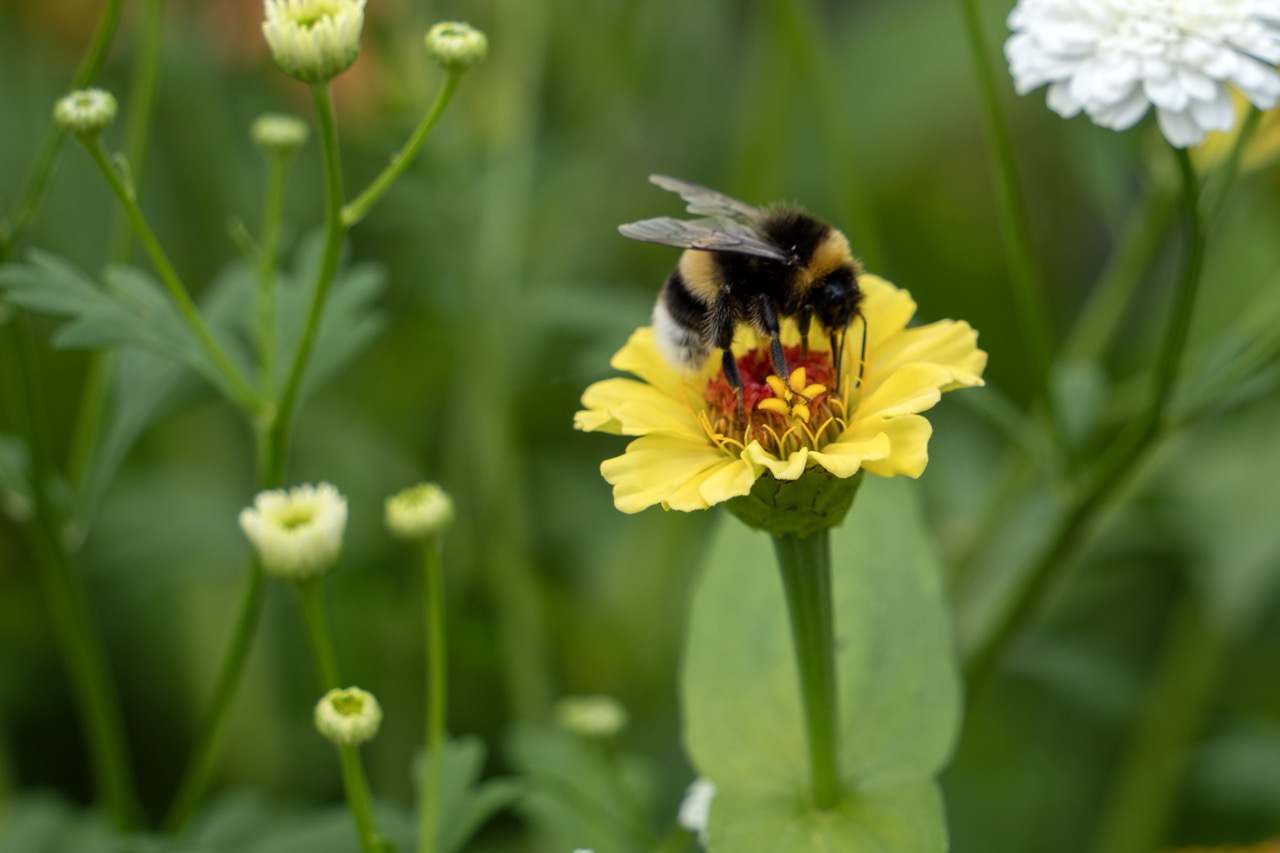

1. Overall Rating (0–10) — 7.5
This photograph captures a quiet, intimate moment of a bumblebee gathering nectar, rendered with a soft, natural elegance. The shallow depth of field beautifully isolates the subject, drawing the viewer into the delicate interaction between insect and flower. While the composition is strong and the color harmony pleasing, the image’s emotional resonance is slightly tempered by a lack of dramatic lighting, keeping it grounded in observation rather than poetic interpretation.
2. Composition (0–10) — 7.0
The bumblebee is well-placed along the diagonal axis, creating a sense of movement toward the flower’s center. The soft background of green stems and out-of-focus buds adds depth without distraction, though the right side of the frame feels slightly more open than necessary.
3. Lighting (0–10) — 7.5
Natural, diffused daylight evenly illuminates the subject, enhancing texture without harsh shadows. The soft light complements the organic subject matter and supports the image’s calm, observational tone.
4. Color & Tone (0–10) — 8.0
The warm yellow of the zinnia contrasts beautifully with the deep green foliage and the bee’s black-and-yellow stripes. The palette is balanced and natural, with a subtle warmth that enhances the feeling of a sunlit garden.
5. Creativity (0–10) — 7.0
The image excels in capturing a common natural moment with aesthetic care. While not groundbreaking in concept, the thoughtful use of focus and color elevates it beyond simple documentation into the realm of gentle storytelling.
6. Technical Quality (0–10) — 8.5
Sharp focus on the bee and flower, with a smooth and intentional bokeh background, demonstrates strong technical control. The depth of field is precisely managed, and the image is free of noise or artifacts.
7. Emotional Impact (0–10) — 7.5
There is a quiet sense of peace and connection to nature in the image. The viewer is invited to pause and appreciate the small, essential act of pollination, evoking a feeling of wonder and tranquility.
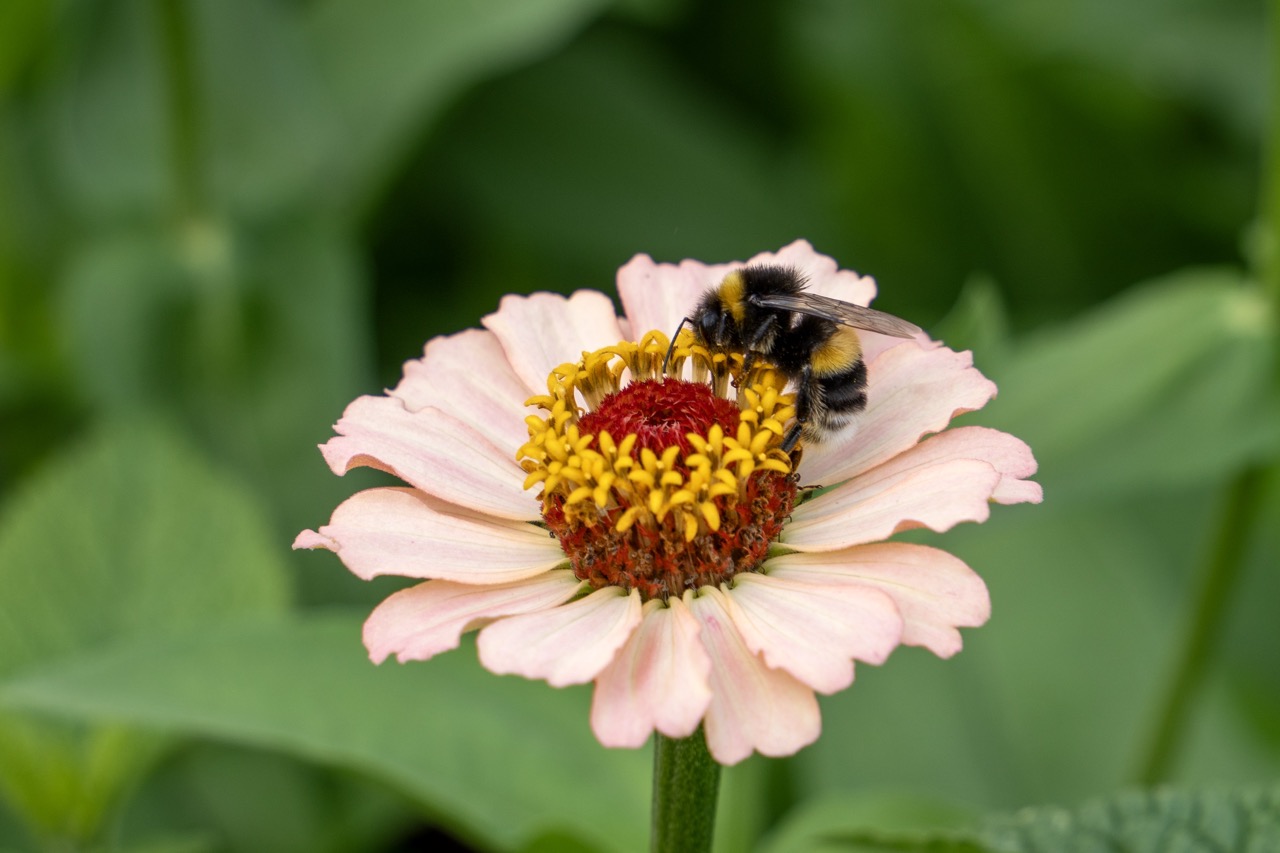

1. Overall Rating (0–10) — 8.0
This photograph captures a quiet, intimate moment in nature, where the delicate interaction between a bumblebee and a zinnia flower radiates life and purpose. The soft focus on the lush green background enhances the subject’s clarity, drawing the viewer into the micro-world of pollination. While the image is technically sound and emotionally resonant, it leans slightly toward conventional nature photography, lacking a bold stylistic twist to distinguish it from the countless similar shots.
2. Composition (0–10) — 7.5
The bee and flower are well-centered, with the insect positioned to lead the eye toward the vibrant yellow center. The use of shallow depth of field effectively isolates the subject, though the composition feels slightly static, with the flower’s stem running directly through the lower third, creating a subtle visual interruption.
3. Lighting (0–10) — 8.0
Natural, diffused daylight illuminates the scene evenly, highlighting the fine textures of the bee’s fur and the flower’s petals without harsh shadows. The soft light enhances the organic quality of the moment and supports the calm, serene mood.
4. Color & Tone (0–10) — 8.5
The pastel pink petals contrast beautifully with the bright yellow stamens and the deep green backdrop, creating a harmonious and visually pleasing palette. The tones are rich yet natural, with a subtle warmth that enhances the springtime feel.
5. Creativity (0–10) — 7.0
While the subject matter is inherently poetic, the approach is traditional and observational. The image succeeds in capturing a familiar scene with clarity and sensitivity, but it doesn’t push beyond the expected to offer a unique perspective or narrative twist.
6. Technical Quality (0–10) — 9.0
The focus is precise on the bee and the flower’s center, with sharp detail in the fine hairs and pollen. The depth of field is expertly managed, and there are no visible technical flaws such as noise or blur.
7. Emotional Impact (0–10) — 8.0
The image evokes a sense of wonder and tranquility, inviting the viewer to pause and appreciate the delicate balance of nature. The close-up intimacy fosters a connection to the small, often overlooked moments of life, creating a quiet but meaningful emotional resonance.
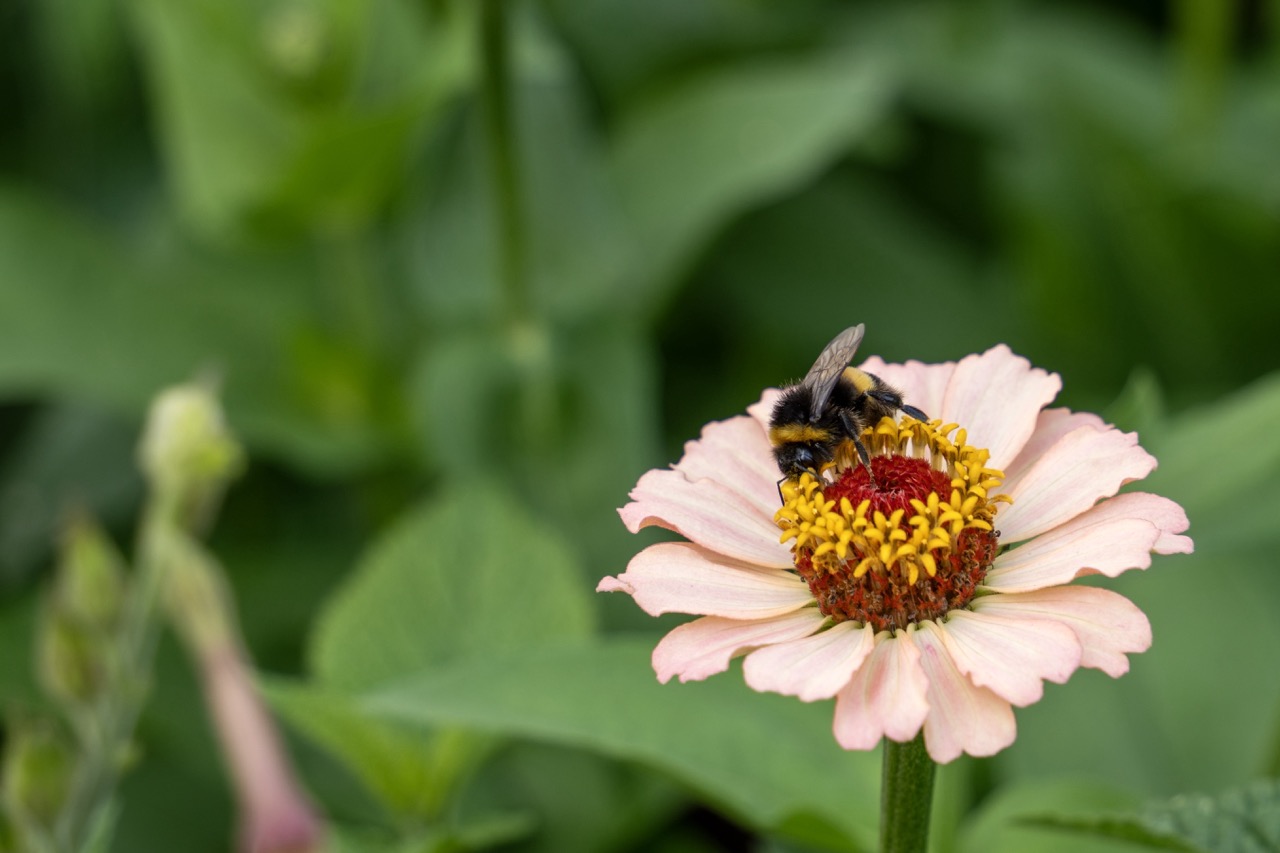

1. Overall Rating (0–10) — 8.0
This photograph captures a quiet, intimate moment in nature, where the delicate interaction between a bumblebee and a zinnia flower feels both tender and alive. The soft focus on the background enhances the sense of stillness, drawing the eye to the fine details of the bee’s fuzzy body and the vibrant center of the bloom. While the image is beautifully composed and emotionally resonant, it could benefit from slightly more contrast to elevate the visual punch of the flower’s pale pink petals.
2. Composition (0–10) — 8.5
The subject is placed slightly off-center, following the rule of thirds, which creates a natural and balanced visual flow. The shallow depth of field isolates the bee and flower effectively, while the blurred greenery provides a harmonious backdrop without distraction.
3. Lighting (0–10) — 8.0
Soft, diffused daylight illuminates the scene evenly, highlighting the textures of the bee’s fur and the flower’s petals without harsh shadows. The light enhances the natural vibrancy of the colors and supports the calm, serene mood.
4. Color & Tone (0–10) — 8.5
The palette is rich yet restrained, with the warm yellow and red of the flower’s center contrasting beautifully against the soft pink petals and the deep green background. The tonal harmony creates a visually pleasing and unified image.
5. Creativity (0–10) — 7.5
The image captures a common subject—bee on a flower—with a fresh and contemplative perspective. The choice of shallow focus and natural lighting elevates it beyond mere documentation into a moment of quiet storytelling.
6. Technical Quality (0–10) — 9.0
The focus is sharp on the bee and flower, with excellent clarity and detail. The exposure is well-balanced, and the depth of field is controlled precisely, showcasing strong technical execution.
7. Emotional Impact (0–10) — 8.5
There’s a quiet intimacy in the scene that invites reflection on the small, fleeting moments of life. The viewer is drawn into the bee’s world, evoking a sense of wonder and connection to the natural world.
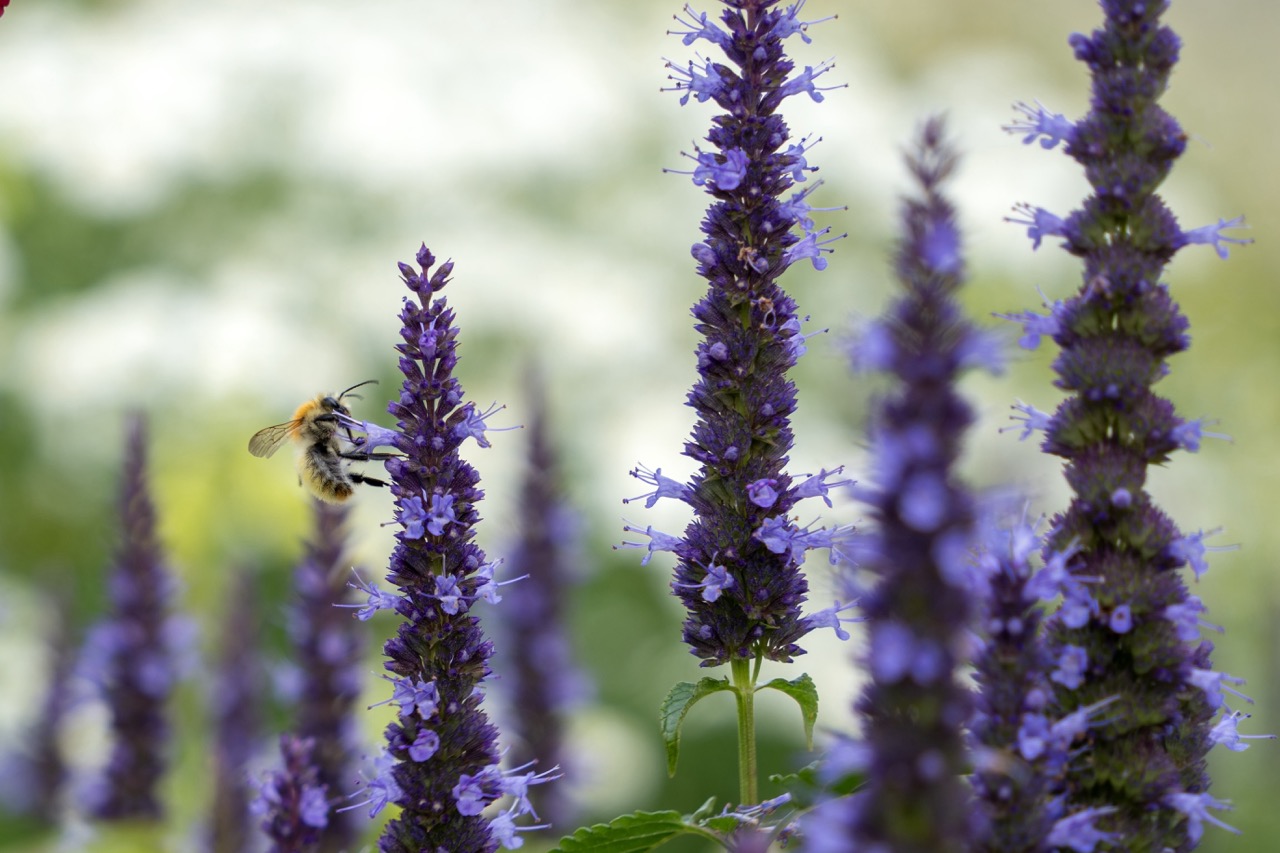

1. Overall Rating (0–10) — 8.0
This photograph captures a delicate moment of natural harmony, where a bumblebee interacts with vibrant purple blossoms in a softly lit garden. The shallow depth of field beautifully isolates the subject, emphasizing the intricate textures of the flower and the bee’s fuzzy body. While the image is visually rich and well-composed, its emotional resonance could be deepened with a more dynamic light source or a stronger sense of motion.
2. Composition (0–10) — 8.0
The bumblebee is placed slightly off-center, following the rule of thirds, which draws the eye naturally across the frame. The vertical lines of the flower spikes create a sense of rhythm and structure, while the blurred background enhances focus on the main subject.
3. Lighting (0–10) — 7.5
Soft, diffused natural light illuminates the scene evenly, enhancing the delicate details of the bee and flowers without harsh shadows. The gentle lighting contributes to a calm, serene mood.
4. Color & Tone (0–10) — 8.5
The rich purples of the flowers contrast beautifully with the warm yellow and black of the bee, while the soft green and white background creates a harmonious, natural palette. The color balance is clean and pleasing, enhancing the image’s organic feel.
5. Creativity (0–10) — 8.0
The photographer captures a fleeting, intimate moment in nature with a keen eye for detail and composition. The use of shallow depth of field adds a painterly quality, transforming a simple scene into a contemplative visual narrative.
6. Technical Quality (0–10) — 9.0
Sharp focus on the bee and foreground flower, with a smooth, controlled bokeh in the background, demonstrates excellent technical execution. The image is crisp, well-exposed, and free from distracting artifacts.
7. Emotional Impact (0–10) — 8.0
There is a quiet sense of wonder and tranquility in the image, inviting the viewer to pause and appreciate the small miracles of nature. The intimacy of the moment evokes a feeling of connection to the natural world.
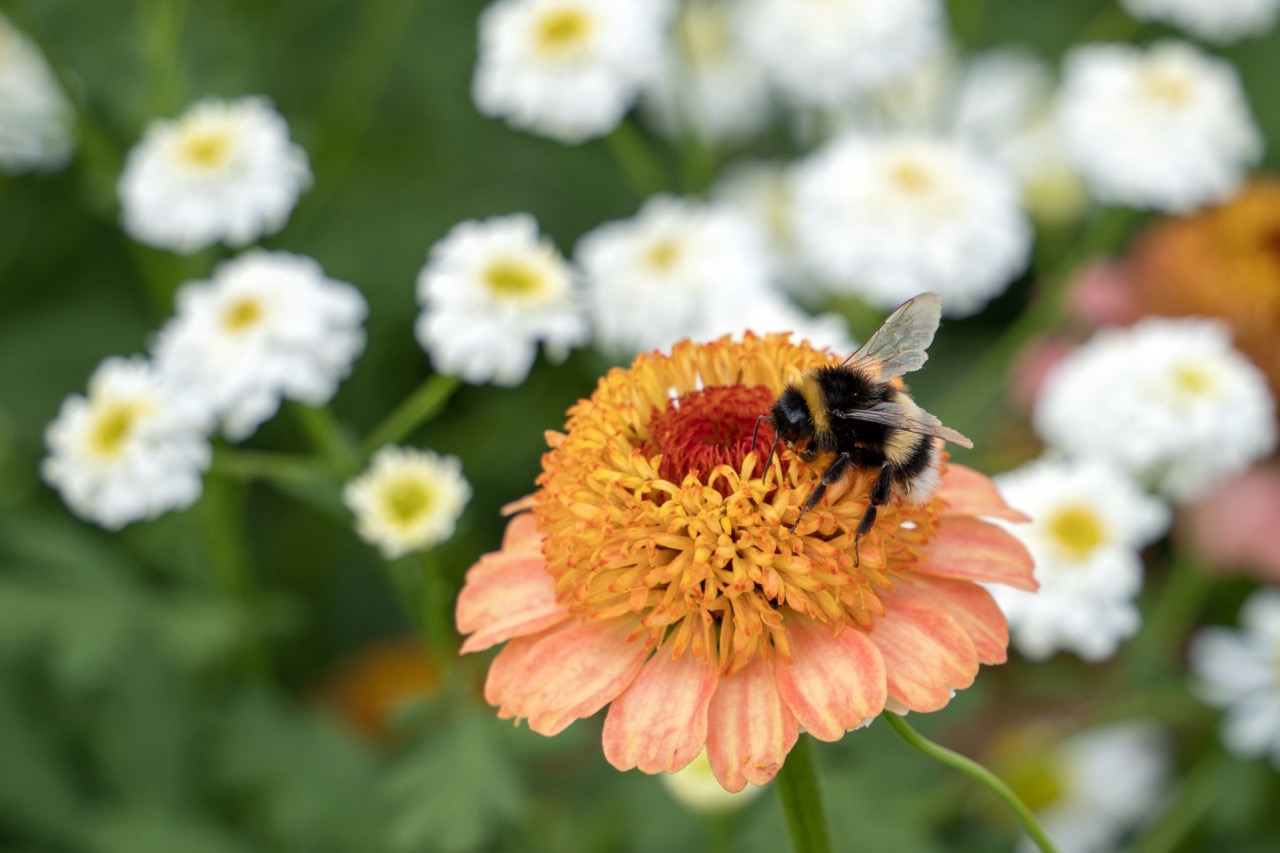

1. Overall Rating (0–10) — 8.0
This photograph captures a delicate moment of natural harmony, where a bumblebee pauses on a vibrant zinnia, its fuzzy form contrasting beautifully with the flower’s intricate petals. The shallow depth of field isolates the subject with painterly precision, while the soft, sunlit glow enhances the scene’s quiet vitality. Though the composition is strong, a slightly more dynamic angle could elevate the sense of movement and engagement.
2. Composition (0–10) — 7.5
The bee and flower are well-centered, drawing immediate attention, though the slight tilt in the flower’s orientation introduces a subtle imbalance. The background of white daisies provides a soft, textured contrast without distracting from the main subject.
3. Lighting (0–10) — 8.5
Natural, diffused sunlight highlights the textures of the bee’s fur and the flower’s petals, casting gentle shadows that add dimension. The even exposure preserves detail in both the subject and the softly blurred background.
4. Color & Tone (0–10) — 8.0
The warm orange and pink hues of the zinnia pop against the cool greens and whites, creating a balanced, inviting palette. The colors feel natural and vibrant without appearing oversaturated.
5. Creativity (0–10) — 7.5
The image leverages macro techniques to transform a common garden scene into an intimate portrait of pollination. While the concept is familiar, the execution feels fresh and attentive to detail.
6. Technical Quality (0–10) — 8.5
Sharp focus on the bee and flower, with a smooth bokeh effect, demonstrates strong technical control. The depth of field is precisely managed, enhancing the subject’s prominence.
7. Emotional Impact (0–10) — 8.0
The photograph evokes a sense of peace and wonder, inviting the viewer to pause and appreciate the quiet beauty of small life. The close-up perspective fosters a connection to the natural world.
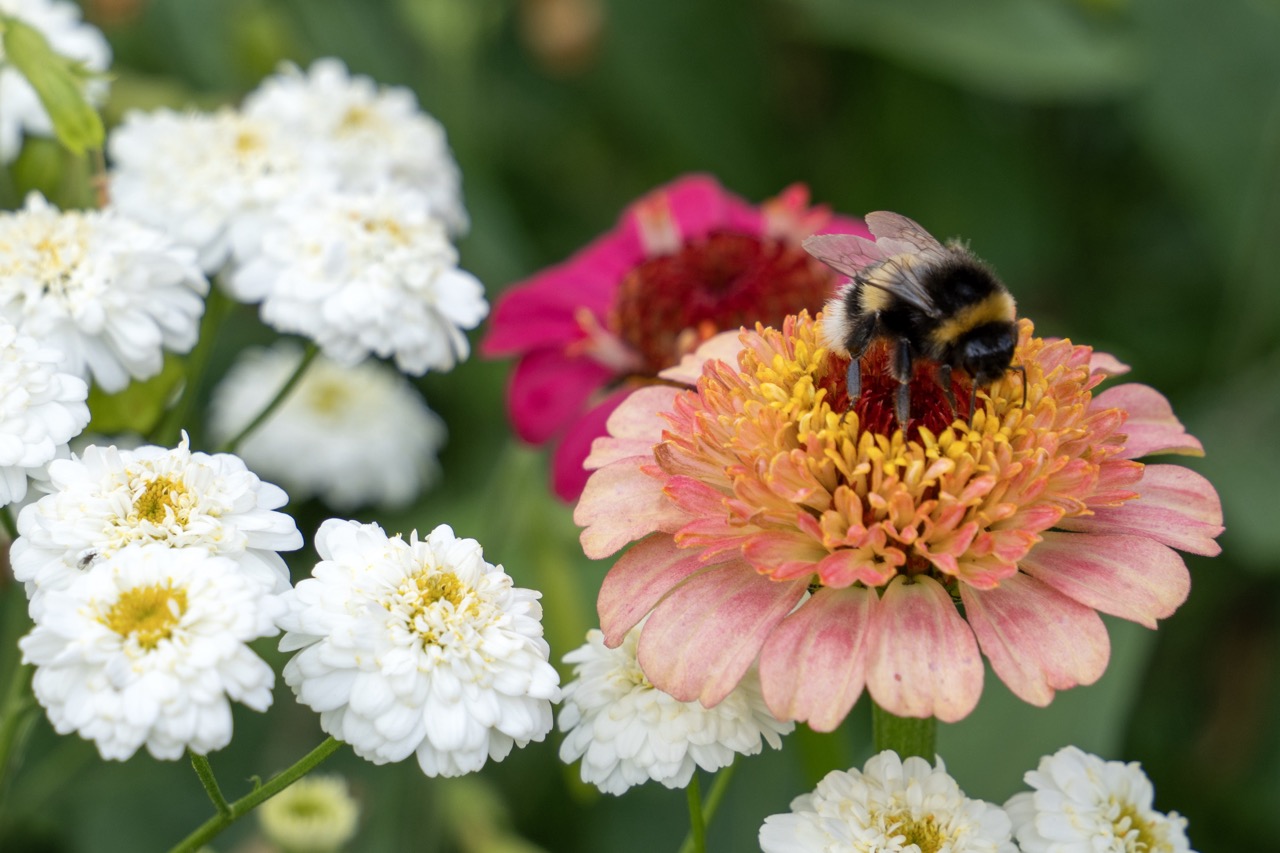

1. Overall Rating (0–10) — 8.0
This photograph captures a delicate moment of nature in motion, where the bustling life of a bumblebee on a zinnia flower is framed by a soft, dreamy backdrop of white blossoms. The shallow depth of field isolates the main subject with elegance, while the interplay of warm and cool tones adds visual richness. The image succeeds in conveying both tranquility and vitality, though the composition’s slight asymmetry keeps it from feeling perfectly balanced.
2. Composition (0–10) — 7.5
The bee and the pink zinnia are placed slightly off-center, creating a dynamic focal point that draws the eye. The cluster of white flowers on the left provides visual counterweight, though their overexposure slightly disrupts the harmony.
3. Lighting (0–10) — 8.0
Natural, diffused light softly illuminates the scene, enhancing texture and detail without harsh shadows. The light complements the organic subject matter, lending a gentle, airy quality to the image.
4. Color & Tone (0–10) — 8.5
The warm pink and yellow of the zinnia contrast beautifully with the crisp white blooms and muted greens, creating a balanced and inviting palette. The tones are rich yet restrained, emphasizing natural vibrancy.
5. Creativity (0–10) — 8.0
The choice to capture the bee mid-action infuses the image with narrative energy. The selective focus and color juxtaposition elevate a simple garden scene into a moment of quiet storytelling.
6. Technical Quality (0–10) — 8.5
Sharp focus on the bee and flower center, with a smooth bokeh transition in the background, demonstrates strong technical control. The exposure and focus are precise, highlighting key details without overprocessing.
7. Emotional Impact (0–10) — 8.5
The image evokes a sense of calm wonder and connection to the natural world. The intimate scale and delicate subject matter invite quiet contemplation, resonating with viewers on a sensory and emotional level.
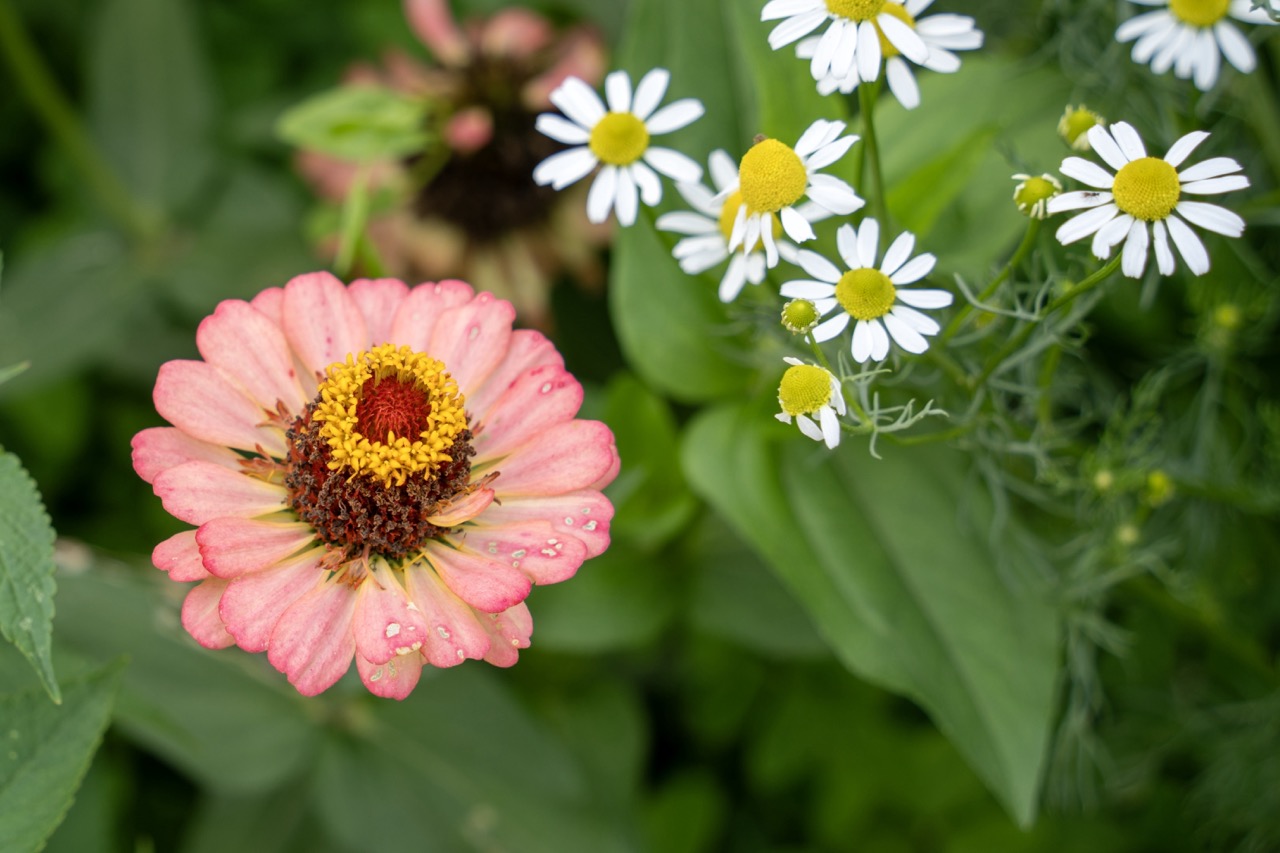

1. Overall Rating (0–10) — 7.5
This photograph captures a vibrant, sun-dappled garden scene with a delicate balance between a bold pink zinnia and the softer white daisies surrounding it. The shallow depth of field beautifully isolates the main flower while allowing the background to blur into a lush, organic tapestry. While the image is rich in natural detail and color, a slightly more dynamic lighting moment or stronger compositional tension could elevate it from a lovely snapshot to a compelling work of art.
2. Composition (0–10) — 7.0
The zinnia is placed slightly off-center, drawing the eye naturally while the scattered daisies create a sense of movement and balance. The diagonal flow of stems adds subtle direction, though a tighter crop might enhance the intimacy of the moment.
3. Lighting (0–10) — 8.0
Soft, diffused natural light enhances the texture and color of the petals without harsh shadows, creating a gentle glow that highlights the flower’s intricate details and dewy surface.
4. Color & Tone (0–10) — 8.0
The contrast between the warm pink and yellow of the zinnia and the cool green and white of the surrounding flora creates a harmonious and lively palette. The tones are rich but not oversaturated, lending a natural and refreshing feel.
5. Creativity (0–10) — 7.0
The choice to focus on a single zinnia amidst a field of daisies offers a quiet narrative of individuality within a community. The image feels personal and observational, with a subtle story of contrast and coexistence.
6. Technical Quality (0–10) — 8.5
Sharp focus on the zinnia’s center, clean depth of field, and excellent detail in the petals and stamens demonstrate strong technical control and a keen eye for detail.
7. Emotional Impact (0–10) — 7.5
There’s a quiet joy and serenity in the image—evoking a peaceful moment in nature that feels both familiar and quietly profound. The viewer is invited to pause and appreciate the delicate beauty of a single bloom.
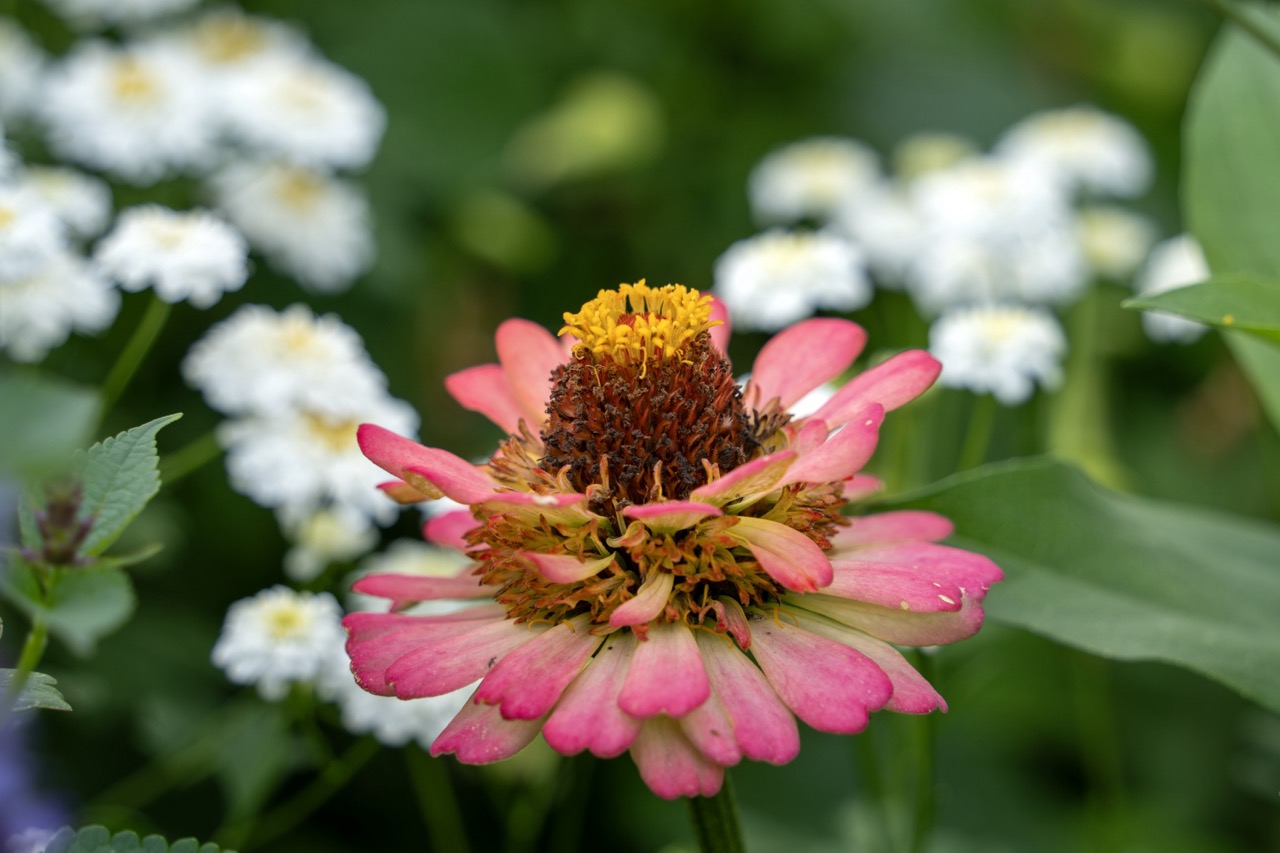

1. Overall Rating (0–10) — 7.5
This photograph captures the quiet beauty of a zinnia in full bloom, its soft pink petals and textured center drawing the eye with natural elegance. The shallow depth of field isolates the flower from the surrounding greenery and white blossoms, creating a serene, garden-like atmosphere. While the image is visually pleasing and well-executed, it leans toward the observational rather than the transformative, offering a gentle moment in nature rather than a bold artistic statement.
2. Composition (0–10) — 7.0
The zinnia is placed slightly off-center, creating a balanced and natural feel. The soft bokeh of the white flowers in the background adds depth without distracting from the main subject.
3. Lighting (0–10) — 8.0
Diffused, natural light enhances the delicate textures of the petals and the intricate center of the flower. The even exposure preserves detail while avoiding harsh shadows.
4. Color & Tone (0–10) — 8.0
The contrast between the vibrant pink petals, golden-yellow center, and soft white background creates a harmonious and pleasing palette. The greens are rich but not overpowering, supporting the floral subject.
5. Creativity (0–10) — 7.0
The image celebrates natural beauty with a clear focus on detail and composition. While not radically innovative, the selection of a slightly weathered bloom adds a subtle narrative of life and decay.
6. Technical Quality (0–10) — 8.5
Sharp focus on the zinnia’s center, clean background blur, and well-handled exposure demonstrate strong technical control and attention to detail.
7. Emotional Impact (0–10) — 7.5
The photograph evokes calm and appreciation for the small, fleeting moments of beauty in nature, inviting the viewer to pause and reflect.
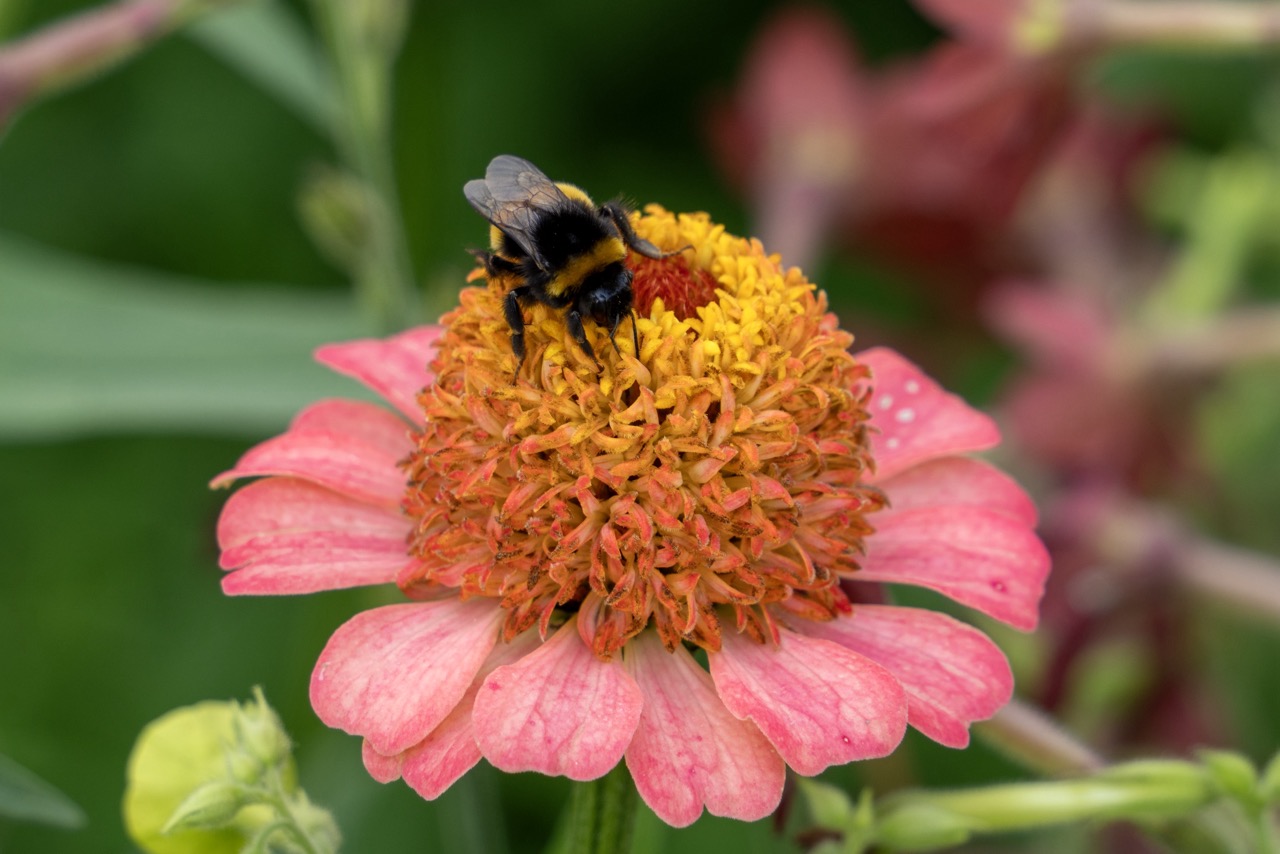

1. Overall Rating (0–10) — 8.0
This photograph captures a moment of quiet intimacy between a bumblebee and a zinnia, where nature’s rhythm is rendered with clarity and grace. The bee’s delicate interaction with the flower’s vibrant center creates a compelling focal point, while the soft, blurred background enhances the sense of stillness and focus. Though the image is technically strong, it could benefit from a slightly more dynamic color temperature to heighten the natural warmth of the scene.
2. Composition (0–10) — 8.5
The bee is well-placed near the center of the frame, drawing the eye immediately to the interaction with the flower. The use of shallow depth of field effectively isolates the subject, while the soft framing of the pink petals adds balance and visual harmony.
3. Lighting (0–10) — 8.0
Natural, diffused light softly illuminates the scene, highlighting the texture of the bee’s fur and the delicate filaments of the flower without harsh shadows. The even lighting enhances detail and contributes to the image’s calm, observational mood.
4. Color & Tone (0–10) — 8.5
The warm yellow of the flower’s center contrasts beautifully with the soft pink petals and the deep green background, creating a rich, natural palette. The colors are vibrant yet harmonious, with a subtle warmth that enhances the organic feel of the moment.
5. Creativity (0–10) — 7.5
The image successfully captures a familiar scene with a fresh, intimate perspective. While the subject is common in macro photography, the composition and timing elevate it beyond mere documentation into a quiet celebration of nature’s small wonders.
6. Technical Quality (0–10) — 9.0
The focus is sharp on the bee and the flower’s center, with excellent detail in the fine textures of both. The depth of field is precisely controlled, and there are no visible technical flaws in exposure or noise.
7. Emotional Impact (0–10) — 8.0
The image evokes a sense of peace and connection to the natural world, inviting the viewer to pause and appreciate the delicate dance of pollination. The quiet energy of the bee’s labor resonates with a gentle, almost meditative emotion.
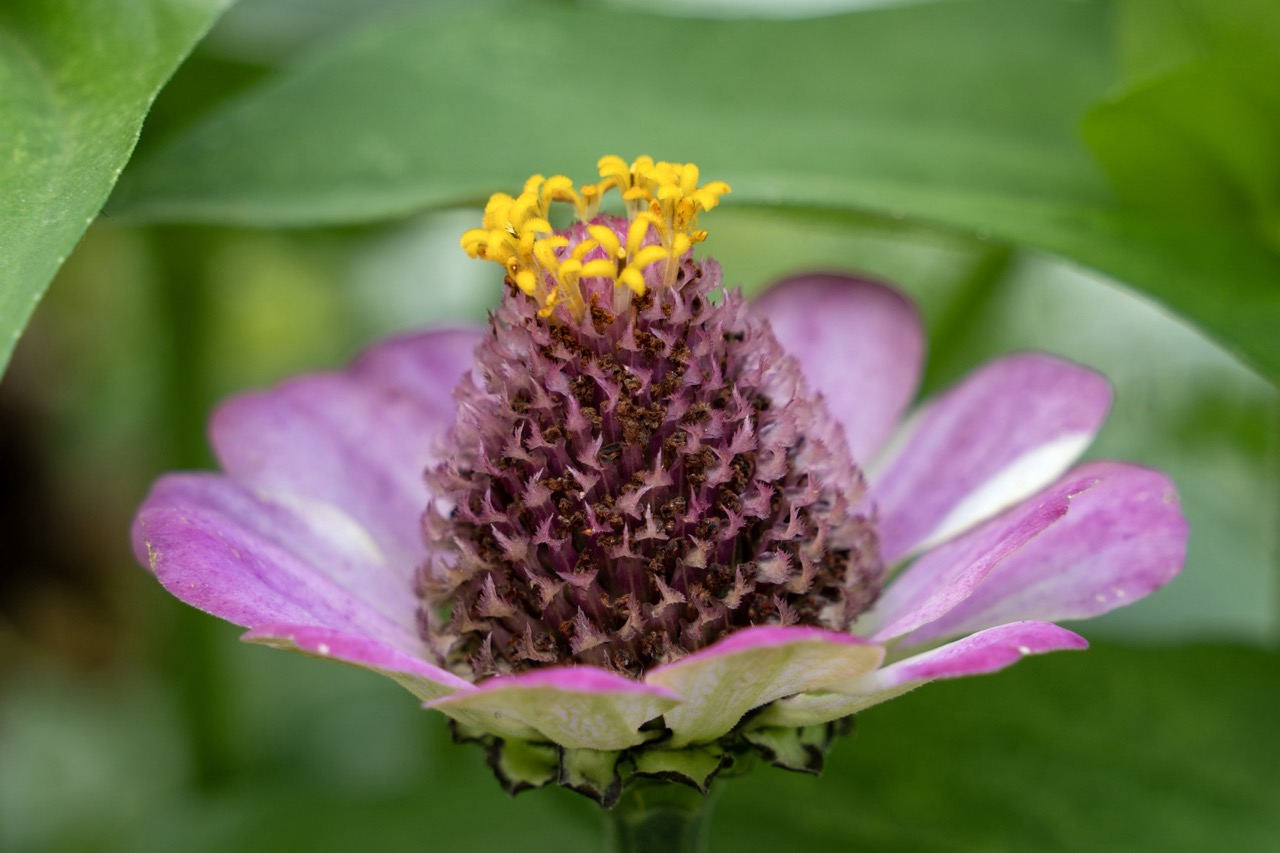

1. Overall Rating (0–10) — 8.0
This close-up of a zinnia captures the intricate beauty of nature with striking clarity and a soft, natural elegance. The vivid contrast between the purple petals and the bright yellow stamens draws the eye inward, while the blurred green background enhances the flower’s delicate structure. While the composition is technically strong, it slightly lacks a dynamic sense of movement or narrative, holding the viewer in a moment of stillness rather than evoking deeper emotion.
2. Composition (0–10) — 8.0
The flower is centered with a shallow depth of field, drawing focus to the detailed center. The surrounding green leaves frame the subject naturally, creating a balanced and harmonious visual flow.
3. Lighting (0–10) — 8.5
Soft, diffused light illuminates the flower evenly, highlighting texture without harsh shadows. The gentle highlights on the petals and stamens enhance the natural vibrancy of the colors.
4. Color & Tone (0–10) — 9.0
The palette is rich and harmonious, with a strong contrast between the magenta petals, golden yellow center, and deep green backdrop. The tones are vivid yet natural, conveying the freshness of a blooming flower.
5. Creativity (0–10) — 7.5
The image presents a familiar subject with a fresh, detailed perspective. While not radically original, the emphasis on texture and color creates a visually compelling interpretation of a common flower.
6. Technical Quality (0–10) — 9.0
The focus is sharp on the central part of the flower, with excellent detail in the stamens and petals. The shallow depth of field is well-executed, and the image is free of noise or distortion.
7. Emotional Impact (0–10) — 7.0
The photograph evokes a sense of calm and appreciation for natural beauty, inviting quiet contemplation. Its intimacy and clarity foster a connection with the subject, though it remains more observational than emotionally charged.
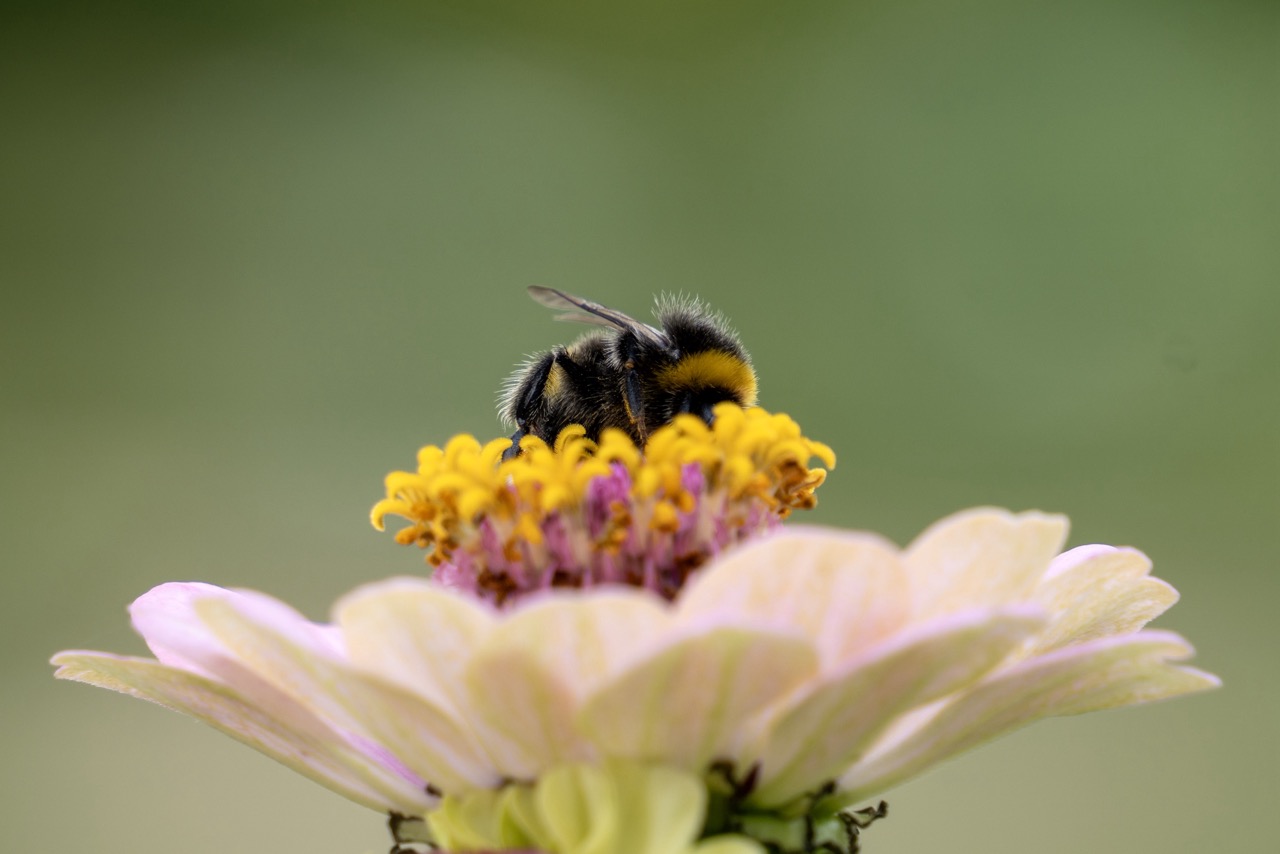

1. Overall Rating (0–10) — 8.0
This photograph captures a tender moment of natural intimacy, where the fuzzy texture of the bumblebee contrasts beautifully with the delicate petals of the zinnia. The shallow depth of field isolates the subject with cinematic precision, drawing the viewer into the quiet world of pollination. While the composition is strong and the focus is sharp, the muted color palette slightly tempers the image’s emotional punch, leaving room for a more vibrant atmosphere.
2. Composition (0–10) — 8.0
The bee is positioned slightly off-center, creating a dynamic balance that guides the eye across the frame. The low angle and tight framing emphasize the interaction between insect and flower, while the soft, blurred background eliminates distractions.
3. Lighting (0–10) — 7.5
Natural, diffused light enhances the fine textures of the bee’s fur and the flower’s center without harsh shadows. The soft illumination contributes to the image’s calm, meditative tone.
4. Color & Tone (0–10) — 7.0
The palette blends soft pinks, yellows, and muted greens into a harmonious, nature-inspired scheme. While cohesive, the colors lack vibrancy, giving the image a slightly subdued quality.
5. Creativity (0–10) — 8.0
The photographer captures a fleeting, intimate moment with a clear artistic vision. The choice to focus on the micro-interaction between bee and flower elevates the image beyond simple documentation into a quiet celebration of life.
6. Technical Quality (0–10) — 8.5
Exceptional sharpness on the bee and flower center, with smooth bokeh in the background. The focus is precise, and the depth of field is expertly managed.
7. Emotional Impact (0–10) — 7.5
The image evokes a sense of peace and wonder, inviting the viewer to pause and appreciate the quiet beauty of the natural world. Its emotional resonance lies in its stillness and attention to detail.
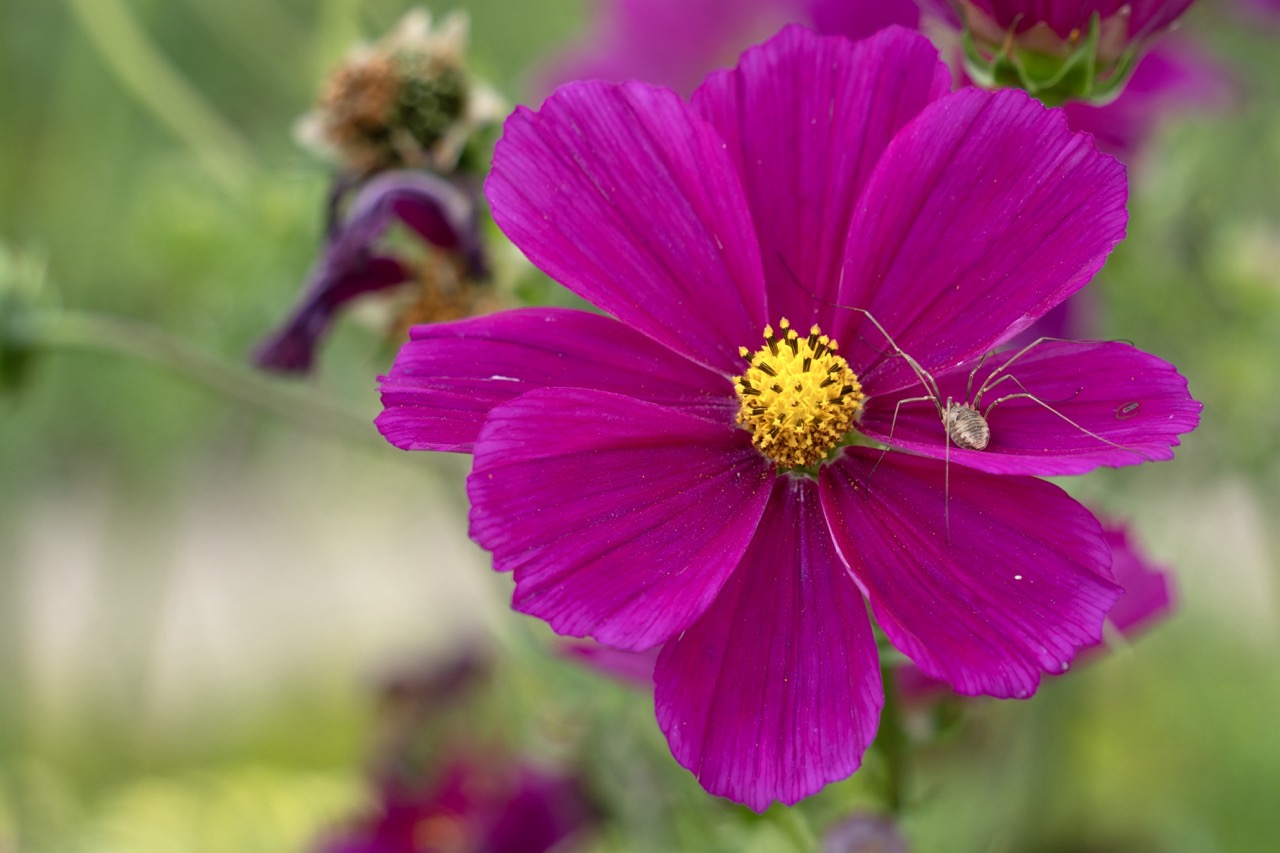

1. Overall Rating (0–10) — 8.0
This image captures a delicate moment in nature with vivid clarity and emotional resonance, where the bold magenta of the cosmos flower contrasts beautifully with the soft presence of the spider. The shallow depth of field isolates the subject with grace, creating a sense of intimacy and stillness. While the composition is strong, the slightly overexposed highlights on the petals and the spider’s legs slightly diminish the subtlety of the scene.
2. Composition (0–10) — 8.0
The flower is well-centered with a strong focal point, and the use of a shallow depth of field effectively blurs the background to draw attention to the subject. The spider’s placement on the right adds visual interest without disrupting balance, creating a natural and harmonious arrangement.
3. Lighting (0–10) — 7.5
Soft, diffused natural light enhances the texture and saturation of the petals while casting gentle shadows that add dimension. The highlights on the flower’s surface are slightly blown out, suggesting a touch of overexposure, but overall the lighting supports a serene and lifelike mood.
4. Color & Tone (0–10) — 8.5
The vibrant magenta of the cosmos is rich and saturated, contrasting beautifully with the yellow center and the muted green backdrop. The tonal range is balanced, with natural warmth that enhances the organic feel of the scene.
5. Creativity (0–10) — 7.5
The inclusion of the spider adds an unexpected narrative layer, transforming a simple floral portrait into a story of coexistence in the natural world. The choice to capture this quiet interaction feels both thoughtful and unobtrusive.
6. Technical Quality (0–10) — 8.0
The focus is sharp on the flower and spider, with fine detail visible in the petals and the creature’s legs. The image is clean and free of noise, though the highlights on the upper petals show minor overexposure.
7. Emotional Impact (0–10) — 8.0
The image evokes a sense of tranquility and wonder, inviting the viewer to pause and appreciate the small, often overlooked moments in nature. The delicate balance between life and stillness creates a quiet emotional resonance.
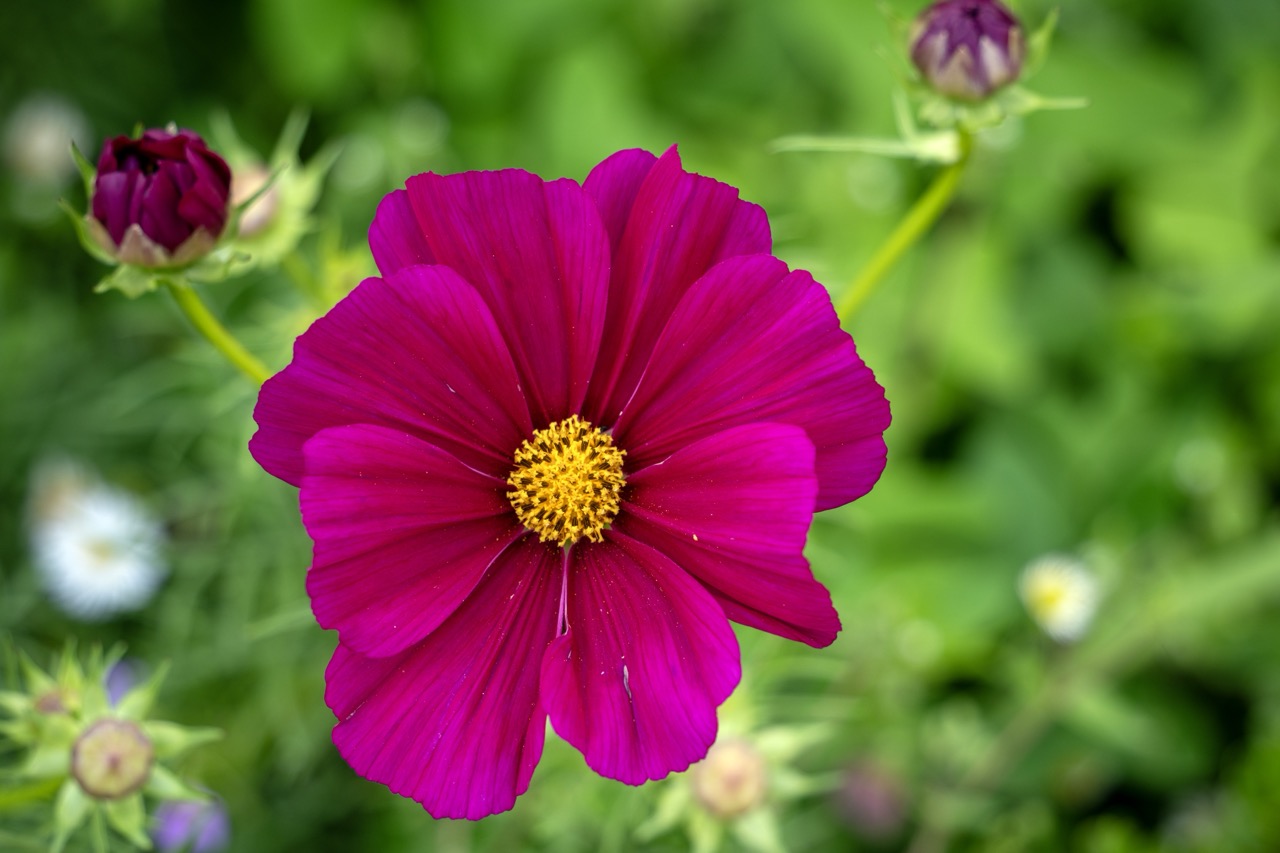

1. Overall Rating (0–10) — 8.5
This image captures the vibrant essence of a cosmos flower in full bloom, its rich magenta petals radiating with life against a soft, green backdrop. The shallow depth of field isolates the subject with elegance, while the natural lighting enhances the flower’s vivid color and delicate texture. A slight improvement in color balance could further elevate the warmth of the scene, but as it stands, the photograph is both visually striking and emotionally soothing.
2. Composition (0–10) — 8.0
The flower is centered slightly off-center, creating a dynamic yet balanced focal point. The inclusion of surrounding buds and soft background elements adds depth and context without distracting from the main subject.
3. Lighting (0–10) — 9.0
Natural, diffused light highlights the flower’s texture and color without harsh shadows, creating a soft, luminous quality that enhances the image’s organic feel.
4. Color & Tone (0–10) — 9.0
The contrast between the deep magenta petals and the bright yellow center is visually arresting, while the lush green background provides a harmonious complementary tone. The colors are rich and saturated without appearing unnatural.
5. Creativity (0–10) — 8.0
The photographer captures a simple floral subject with a sense of intimacy and precision, transforming a common garden scene into a moment of quiet beauty through thoughtful composition and focus.
6. Technical Quality (0–10) — 9.0
The image is sharp and well-focused on the flower, with a smooth bokeh effect in the background that demonstrates excellent lens control and depth of field management.
7. Emotional Impact (0–10) — 8.5
The photograph evokes a sense of calm and wonder, inviting the viewer to pause and appreciate the delicate beauty of nature. The vivid colors and soft focus create a meditative, almost dreamlike atmosphere.
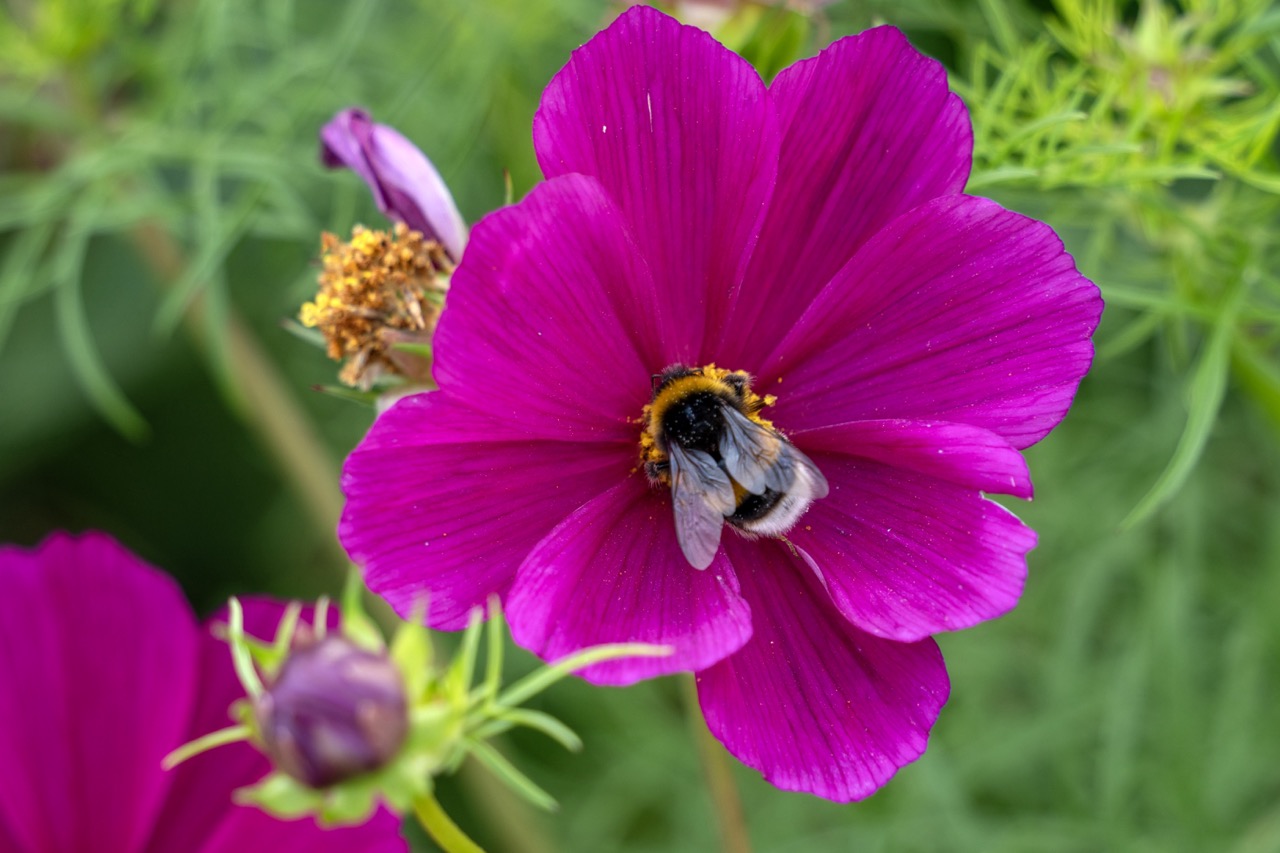

1. Overall Rating (0–10) — 8.0
This photograph captures a vibrant moment of natural harmony, where the bold magenta of the cosmos flower contrasts beautifully with the soft green backdrop. The bumblebee, caught mid-pollination, adds life and narrative to the frame, creating a sense of quiet activity. While the composition is strong and the colors are rich, the image’s appeal lies in its simplicity—celebrating the small, fleeting interactions of the natural world.
2. Composition (0–10) — 8.0
The bee is centered within the flower, drawing immediate focus, while the diagonal placement of the bud and background elements adds dynamic balance. The shallow depth of field isolates the subject effectively, enhancing the intimate feel of the moment.
3. Lighting (0–10) — 8.5
Natural, diffused light highlights the texture of the petals and the fine hairs on the bee, creating a soft glow without harsh shadows. The even illumination enhances color saturation and gives the scene a gentle, serene quality.
4. Color & Tone (0–10) — 9.0
The vivid magenta of the flower pops against the soft greens, creating a striking complementary contrast. The warm yellow of the pollen adds a subtle accent, enhancing the image’s natural vibrancy and visual harmony.
5. Creativity (0–10) — 8.0
The image captures a familiar scene—pollination—but elevates it through thoughtful framing and timing. The choice to focus on the interaction between insect and flower turns a simple moment into a compelling story of coexistence.
6. Technical Quality (0–10) — 9.0
Sharp focus on the bee and flower center, with smooth bokeh in the background, demonstrates excellent control of depth of field. The image is clean, well-exposed, and free of distracting artifacts.
7. Emotional Impact (0–10) — 8.5
There’s a quiet warmth and wonder in the scene—evoking a sense of peace and connection to nature. The viewer is invited to pause and appreciate the delicate, essential role of pollinators, making the image both visually and emotionally resonant.
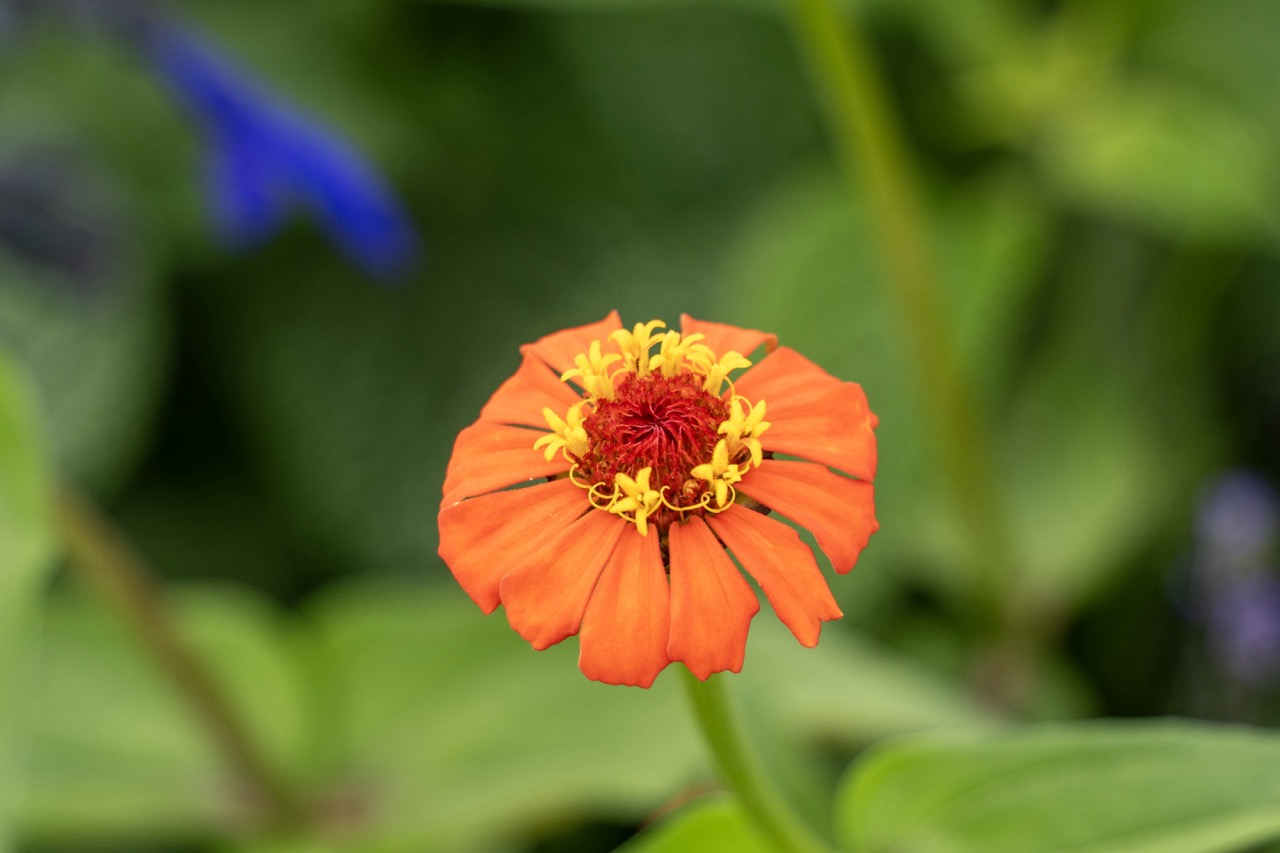

1. Overall Rating (0–10) — 7.5
This photograph captures the vibrant energy of a zinnia in full bloom, where the flower’s bold color contrasts beautifully with the soft, blurred greenery surrounding it. The shallow depth of field isolates the subject with elegance, drawing the eye to the intricate details of the petals and stamen. While the image is visually striking and well-executed, its simplicity—though effective—leaves room for deeper narrative or emotional layering.
2. Composition (0–10) — 7.0
The flower is centered with a balanced framing that emphasizes its symmetry, while the soft background provides a natural, uncluttered canvas. The slight tilt of the stem adds a touch of organic movement, preventing the composition from feeling too static.
3. Lighting (0–10) — 8.0
Natural, diffused light enhances the flower’s vivid hues without harsh shadows, creating a soft glow that accentuates texture and depth. The lighting feels serene and evenly distributed, perfectly suited to the subject’s delicate nature.
4. Color & Tone (0–10) — 8.5
The rich orange of the petals contrasts beautifully with the yellow stamen and the cool green backdrop, while a hint of blue in the background adds a subtle complementary tone. The palette is lively yet harmonious, with natural saturation that feels both vivid and authentic.
5. Creativity (0–10) — 7.0
The image is a strong example of floral photography, using shallow depth of field and color contrast to create visual impact. While the approach is conventional, the attention to detail and color harmony gives it a fresh, contemplative quality.
6. Technical Quality (0–10) — 8.0
Sharp focus on the flower’s center ensures clarity in the fine details, while the smooth bokeh in the background demonstrates excellent lens control. The image is clean, well-exposed, and free of technical flaws.
7. Emotional Impact (0–10) — 7.5
The photograph evokes a sense of calm and natural beauty, inviting the viewer to pause and appreciate the intricate life of a single flower. Its warmth and vibrancy create a quiet joy, resonating with the simple elegance of nature.
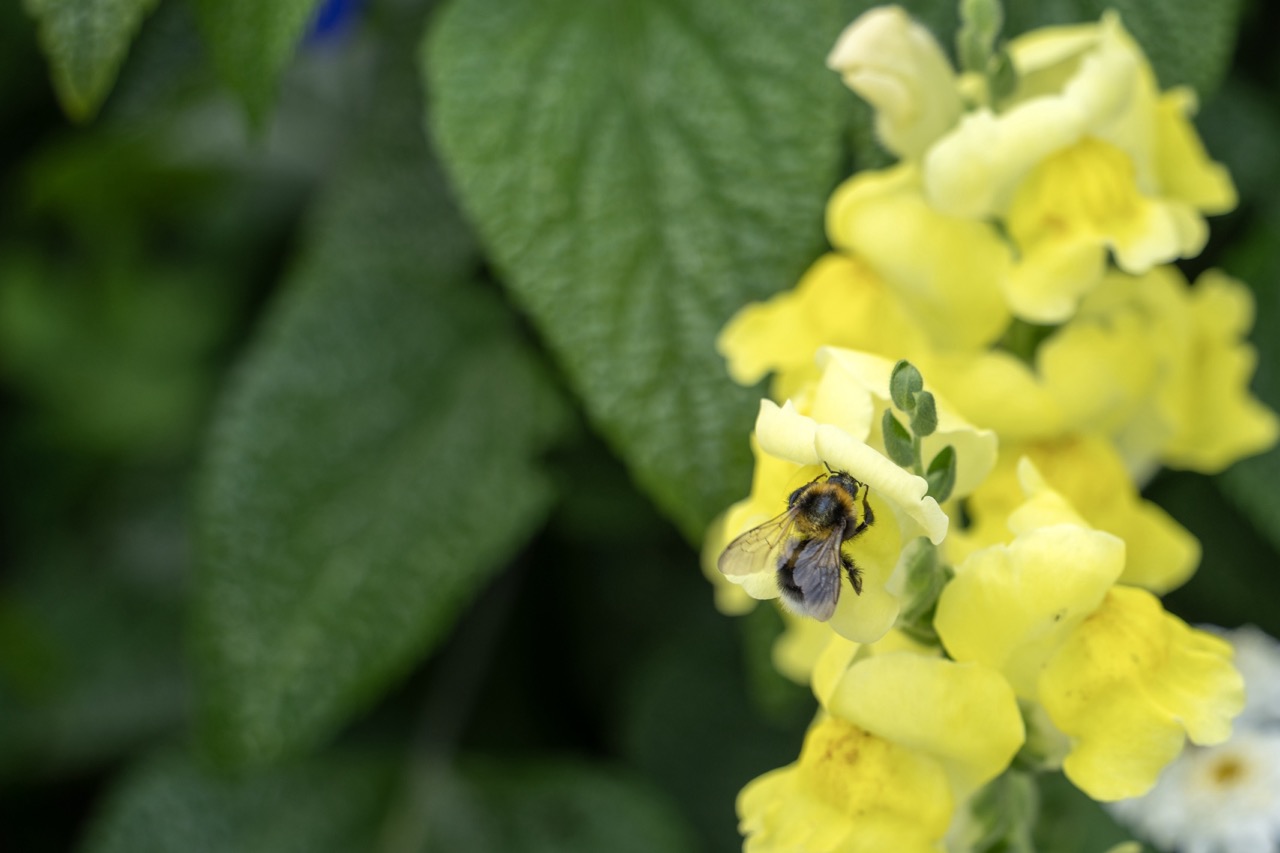

1. Overall Rating (0–10) — 7.5
This photograph captures a delicate moment of natural interaction, where a bumblebee pauses on a cluster of yellow snapdragon flowers. The shallow depth of field isolates the subject with a soft, dreamlike background, enhancing the intimacy of the scene. While the image is beautifully composed and rich in texture, the lighting lacks a certain warmth that might elevate its emotional resonance.
2. Composition (0–10) — 8.0
The bee is placed slightly off-center, following the rule of thirds, drawing the eye naturally through the frame. The diagonal line of the flower stem adds movement, while the blurred green foliage provides a strong contrast, enhancing the subject’s prominence.
3. Lighting (0–10) — 6.5
The light is soft and diffused, likely from an overcast sky, which minimizes harsh shadows and allows for even illumination. However, the overall tone leans slightly cool, muting the warmth of the yellow flowers and reducing the scene’s natural vibrancy.
4. Color & Tone (0–10) — 7.0
The complementary contrast between the yellow blossoms and deep green leaves creates a visually pleasing palette. The colors are rich but restrained, with a slightly muted saturation that gives the image a calm, understated quality.
5. Creativity (0–10) — 7.5
The choice to focus on a fleeting moment of pollination imbues the image with quiet storytelling. The use of shallow depth of field transforms a common scene into an intimate portrait of nature, demonstrating both technical control and artistic sensitivity.
6. Technical Quality (0–10) — 8.5
The focus is sharp on the bee and the nearest flower, with a smooth transition into the background blur. The image is clean, with no visible noise or distortion, showcasing strong macro capabilities and precise control over depth of field.
7. Emotional Impact (0–10) — 7.0
There’s a sense of tranquility and wonder in the stillness of the moment, inviting the viewer to pause and appreciate the quiet beauty of small life. The connection between bee and flower evokes a gentle, almost meditative emotion, though it remains subtly restrained.
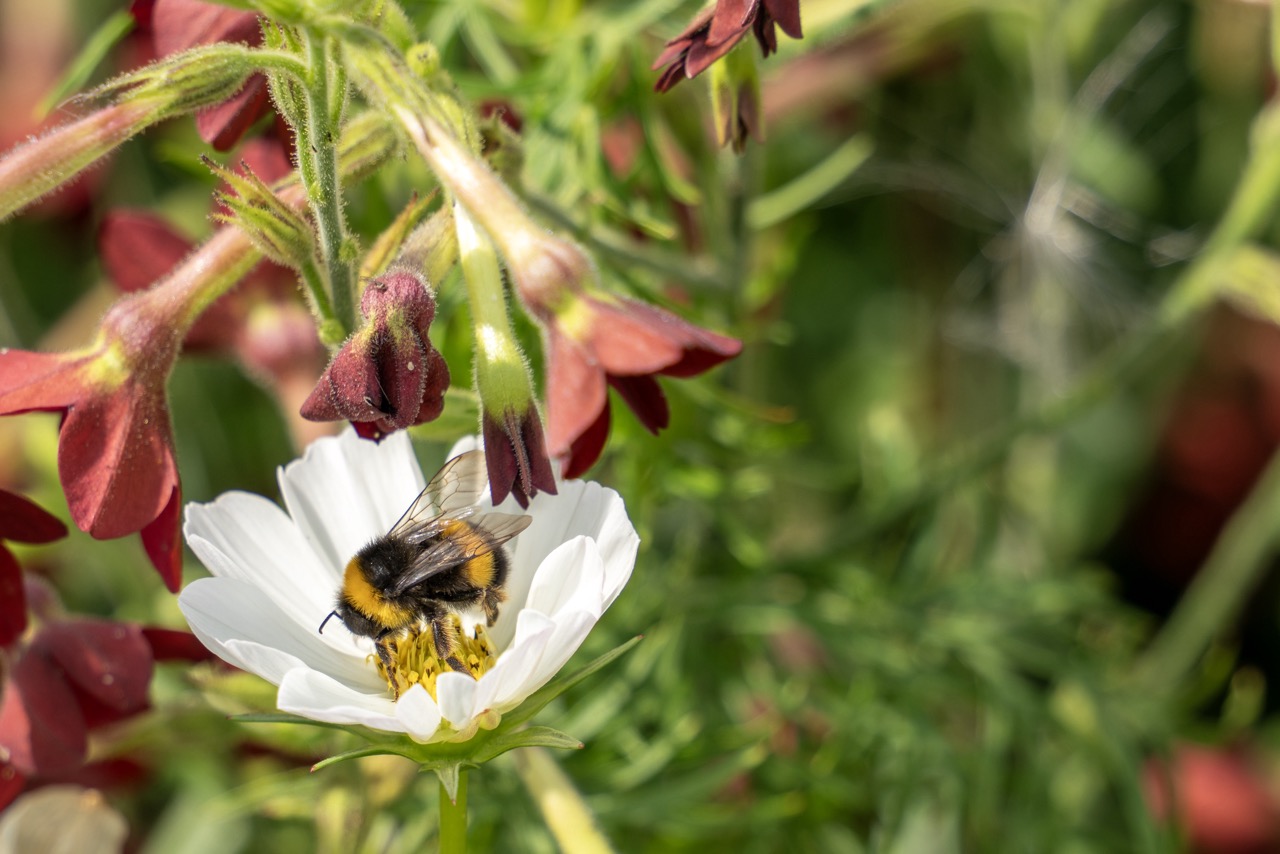

1. Overall Rating (0–10) — 8.0
This photograph captures a delicate moment of natural interaction, where the vibrant life of a bumblebee at work is framed by the soft elegance of a white flower. The shallow depth of field isolates the subject with a painterly quality, drawing the eye to the intricate textures of the bee and bloom. While the composition is strong and the moment is beautifully preserved, the background’s slight green cast and muted reds temper the image’s overall visual punch, keeping it from reaching full luminous potential.
2. Composition (0–10) — 8.0
The bee and white flower are placed slightly off-center, following the rule of thirds and creating a dynamic, natural flow. The diagonal lines of the stems and the blurred background foliage guide the eye toward the focal point, enhancing depth and visual interest.
3. Lighting (0–10) — 8.5
Natural sunlight illuminates the scene from the upper left, casting soft highlights on the bee’s fuzzy body and the flower’s petals. The light enhances texture and detail without creating harsh shadows, giving the image a warm, inviting glow that feels both candid and refined.
4. Color & Tone (0–10) — 7.5
The contrast between the crisp white flower and the deep burgundy of the surrounding blooms creates a striking palette. The greens in the background are rich but slightly muted, contributing to a natural, earthy tone. The overall color harmony is pleasing, though the slightly cool green cast in the shadows slightly dulls the vibrancy.
5. Creativity (0–10) — 8.0
The choice to focus on a micro moment of pollination transforms a common scene into a story of life and connection. The use of shallow depth of field and selective focus adds an artistic layer, elevating the image beyond simple documentation into a contemplative nature study.
6. Technical Quality (0–10) — 9.0
The image is sharp and clear on the bee and flower, with precise focus and excellent detail in the textures of the bee’s fur and the flower’s stamen. The background blur is smooth and intentional, indicating strong technical control.
7. Emotional Impact (0–10) — 8.0
There is a quiet sense of wonder and tranquility in this image, evoking appreciation for the small, often overlooked interactions in nature. The intimacy of the shot invites the viewer to pause and reflect on the beauty of simple, fleeting moments.
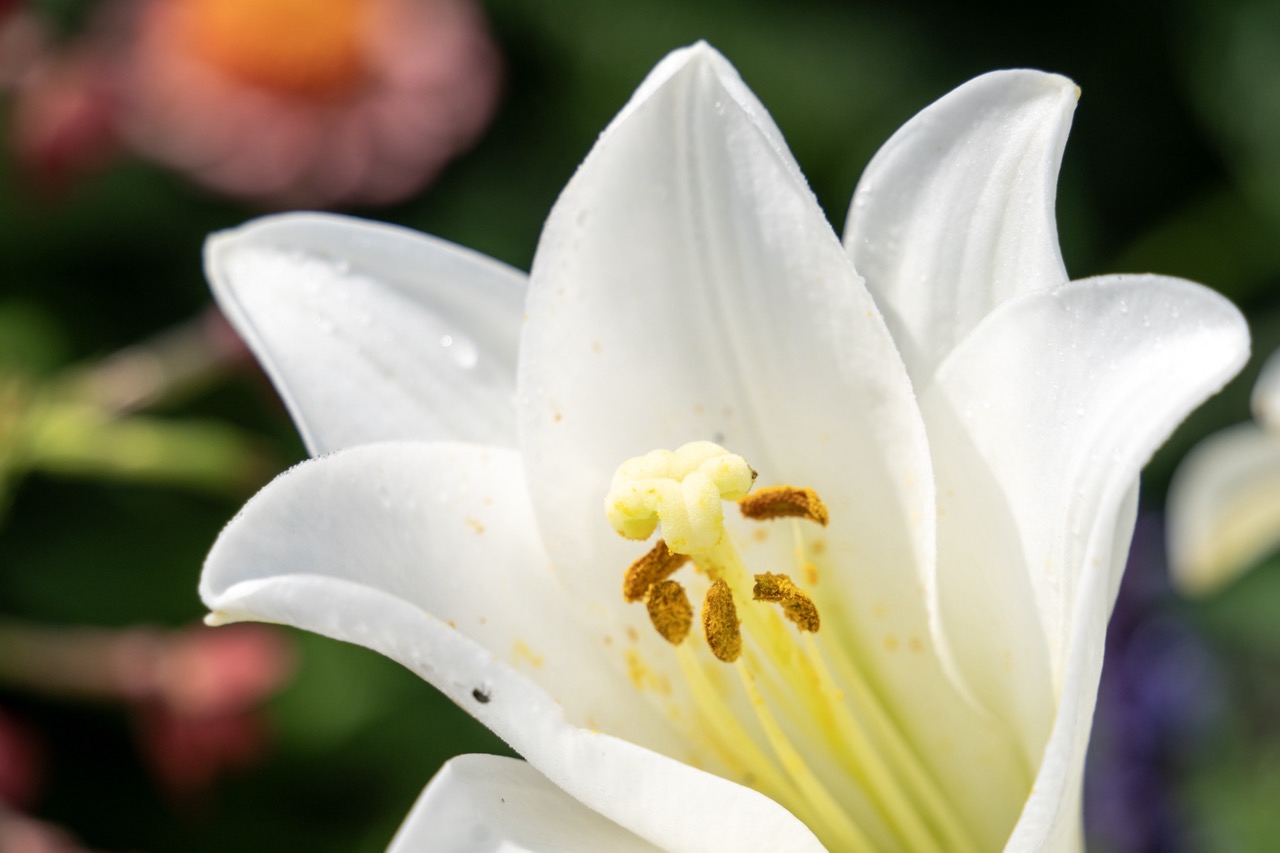

1. Overall Rating (0–10) — 8.0
This image captures the delicate elegance of a white lily in exquisite detail, where the soft curves of the petals and the vibrant yellow stamen create a striking focal point. The shallow depth of field beautifully isolates the flower from the softly blurred background, enhancing its natural grace. While the composition is strong and the subject compelling, a touch more color contrast in the background could further elevate the visual drama.
2. Composition (0–10) — 8.0
The lily is centered with a slightly off-center perspective, creating a dynamic balance. The blurred background draws attention to the flower’s form without distraction, and the framing emphasizes the bloom’s natural symmetry and texture.
3. Lighting (0–10) — 8.5
Natural light illuminates the flower evenly, highlighting the subtle textures and dewy surface of the petals. The soft, diffused lighting enhances the flower’s purity while casting gentle shadows that add dimension.
4. Color & Tone (0–10) — 7.5
The clean white of the lily contrasts with the warm yellow of the stamen and the soft hints of green and muted pink in the background. While the palette is harmonious, it leans toward a subdued tonal range, slightly limiting vibrancy.
5. Creativity (0–10) — 8.0
The photographer emphasizes the intimate beauty of a single bloom, transforming a common subject into a moment of quiet wonder. The choice of shallow depth of field and tight framing adds a poetic, almost meditative quality.
6. Technical Quality (0–10) — 9.0
The focus is sharp on the stamen and center of the flower, with excellent clarity in the fine details of the petals and pollen. The sensor resolution and focus accuracy are strong, capturing the image with precision.
7. Emotional Impact (0–10) — 8.5
The photograph evokes a sense of serenity and purity, inviting the viewer to pause and appreciate the quiet beauty of nature. The intimacy of the close-up fosters a personal connection, making the image feel both delicate and profound.
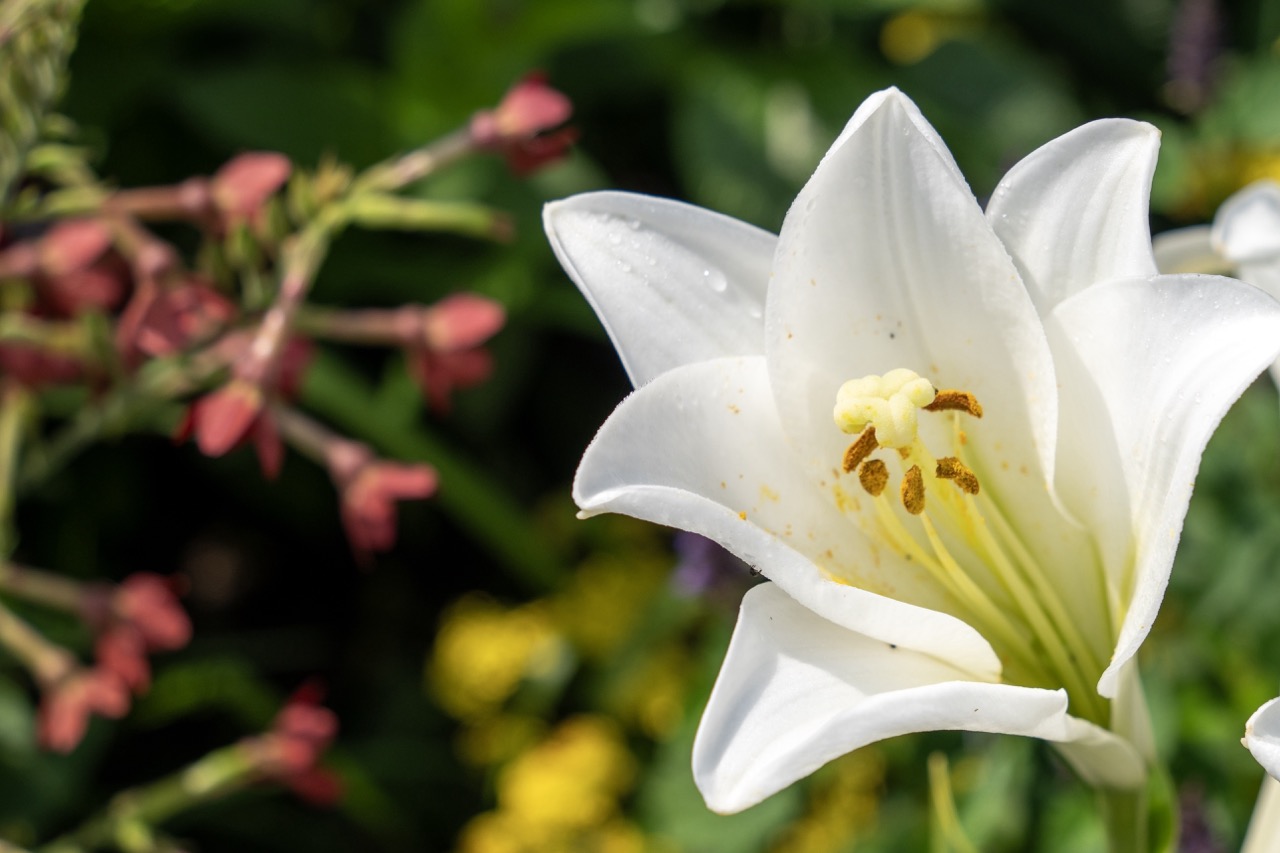

1. Overall Rating (0–10) — 8.0
This photograph captures the delicate elegance of a white lily in full bloom, its pristine petals glistening with dew and drawing the eye with quiet grace. The soft, out-of-focus background enhances the flower’s purity while the subtle interplay of light and color adds a sense of serene natural beauty. While the composition is strong, a slightly more intentional framing could elevate its artistic impact.
2. Composition (0–10) — 8.0
The lily is placed slightly off-center, following the rule of thirds, which creates a balanced and visually engaging composition. The blurred background flowers provide depth and context without distracting from the main subject.
3. Lighting (0–10) — 9.0
Natural sunlight softly illuminates the lily, highlighting the texture of the petals and the fine details of the stamen. The light is even and flattering, enhancing the flower’s luminous quality without harsh shadows.
4. Color & Tone (0–10) — 8.0
The crisp white of the lily contrasts beautifully with the muted greens and soft pinks in the background. The color palette is harmonious and natural, with a gentle warmth that enhances the organic feel of the scene.
5. Creativity (0–10) — 7.5
The image is a classic floral portrait, executed with technical precision and an eye for detail. While not groundbreaking in concept, the thoughtful composition and lighting elevate it beyond a simple snapshot into a contemplative study of nature.
6. Technical Quality (0–10) — 9.0
The focus is sharp on the lily’s center, with a smooth depth of field that beautifully blurs the background. The image is clear, well-exposed, and free of noticeable technical flaws.
7. Emotional Impact (0–10) — 8.5
The photograph evokes a sense of tranquility and purity, inviting the viewer to pause and appreciate the quiet beauty of a single moment in nature. The delicate details and soft light create a contemplative, almost meditative mood.
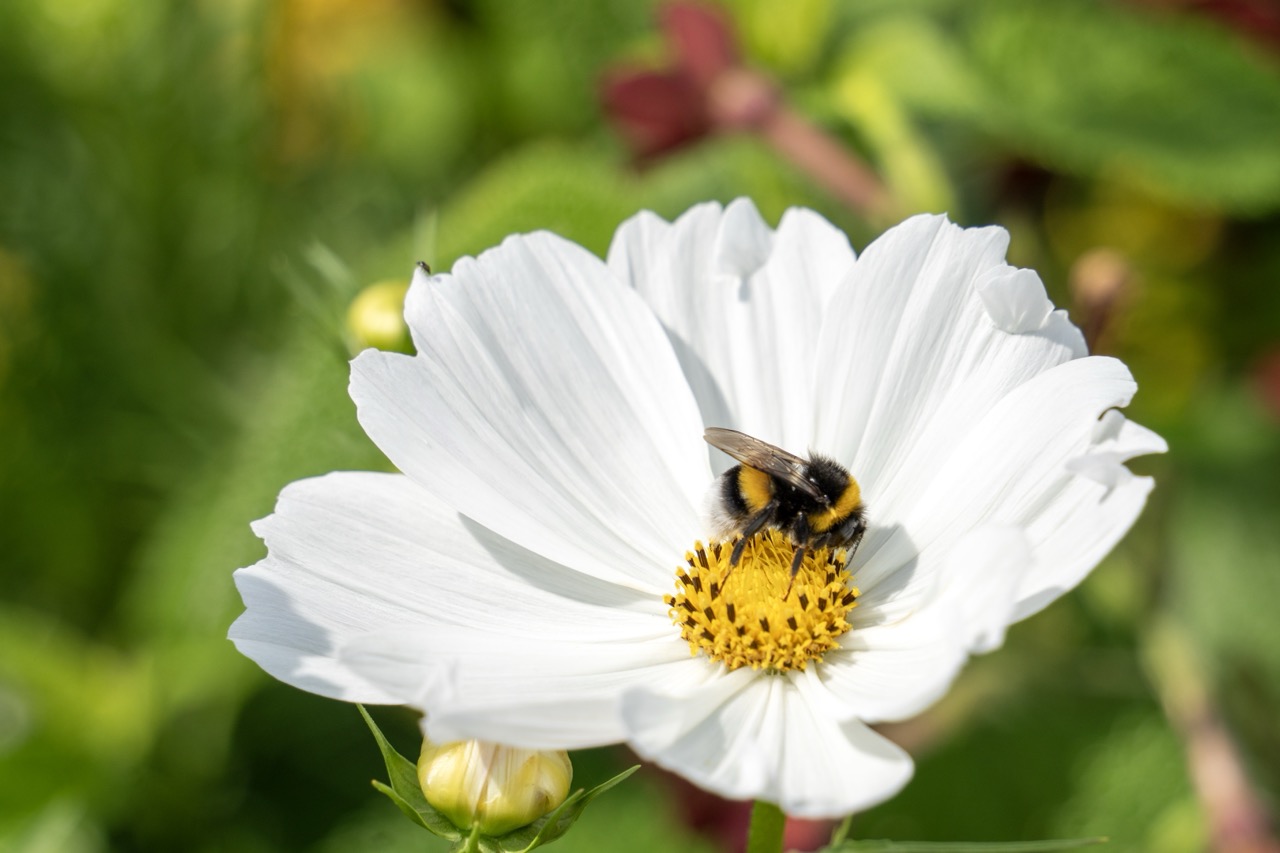

1. Overall Rating (0–10) — 8.0
This photograph captures a serene moment of natural harmony, where a bumblebee interacts with a pristine white cosmos flower in soft, golden light. The shallow depth of field isolates the subject beautifully, emphasizing the delicate textures of the petals and the bee’s fuzzy body. While the composition is strong and the moment is compelling, the scene feels slightly predictable in its subject matter, though it remains visually arresting and emotionally soothing.
2. Composition (0–10) — 8.5
The bumblebee is placed slightly off-center, drawing the eye naturally toward the flower’s vibrant yellow center. The soft blur of the green background enhances focus on the main subject, creating a balanced and harmonious frame with a clear focal point.
3. Lighting (0–10) — 9.0
Natural sunlight bathes the scene in warm, diffused light, highlighting the fine details of the bee’s fur and the delicate structure of the petals. The light enhances the flower’s purity while casting soft shadows that add dimension and depth.
4. Color & Tone (0–10) — 8.5
The contrast between the crisp white petals, the bright yellow center, and the rich green background creates a vibrant yet balanced palette. The colors are naturally saturated, conveying the freshness and vitality of a summer garden.
5. Creativity (0–10) — 7.5
While the subject—a bee on a flower—is a classic macro motif, the execution elevates it through thoughtful composition and lighting. The image tells a quiet story of pollination and interdependence, offering a fresh perspective on a familiar scene.
6. Technical Quality (0–10) — 9.0
The image is sharp where it matters—on the bee and the flower’s center—with excellent focus and clarity. The depth of field is precisely managed, and there are no visible technical flaws such as noise or distortion.
7. Emotional Impact (0–10) — 8.0
The photograph evokes a sense of calm and wonder, inviting the viewer to pause and appreciate the small, intricate moments of life. The intimacy of the moment and the gentle beauty of the scene create a deeply resonant and peaceful connection.
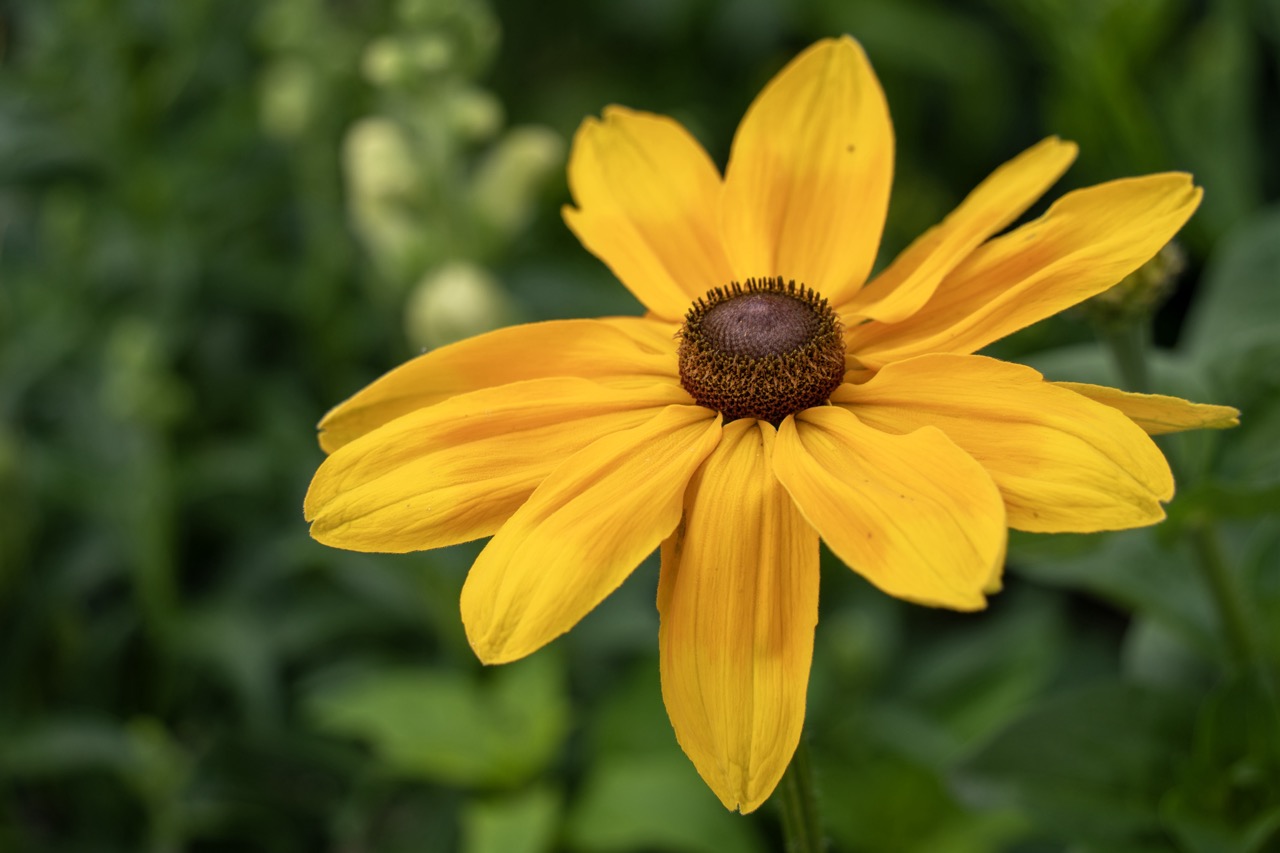

1. Overall Rating (0–10) — 8.0
This photograph captures the vibrant energy of a black-eyed Susan in full bloom, its golden petals radiating warmth against a softly blurred green backdrop. The composition draws the eye directly to the flower’s intricate center, creating a sense of delicate focus and natural elegance. While the image is technically strong and emotionally uplifting, it leans slightly toward conventional floral photography, lacking a deeper narrative or unexpected visual twist.
2. Composition (0–10) — 8.5
The flower is centered with a balanced, symmetrical arrangement, creating a harmonious focal point. The shallow depth of field effectively isolates the subject, emphasizing its form while allowing the background to dissolve into a soft, painterly blur.
3. Lighting (0–10) — 8.0
Natural, diffused light softly illuminates the petals, enhancing their warm yellow tones without harsh shadows. The even lighting highlights texture and detail, particularly in the flower’s central disk, contributing to a serene and inviting mood.
4. Color & Tone (0–10) — 9.0
The vivid yellow of the petals contrasts beautifully with the deep, muted greens of the background, creating a visually striking and harmonious palette. The color temperature feels warm and natural, enhancing the organic, sunlit feel of the scene.
5. Creativity (0–10) — 7.0
While the subject and composition are classic, the image succeeds through its attention to detail and emotional resonance. It captures a moment of quiet beauty, but the approach remains familiar rather than groundbreaking.
6. Technical Quality (0–10) — 9.0
The image is sharp and clear, with precise focus on the flower’s center. The depth of field is expertly controlled, and the lack of noise or artifacts indicates strong technical execution.
7. Emotional Impact (0–10) — 8.5
The photograph evokes a sense of peace, renewal, and natural joy. The simplicity of the subject, combined with its vivid color and soft focus, creates an intimate, uplifting experience that resonates with viewers on a quiet, reflective level.
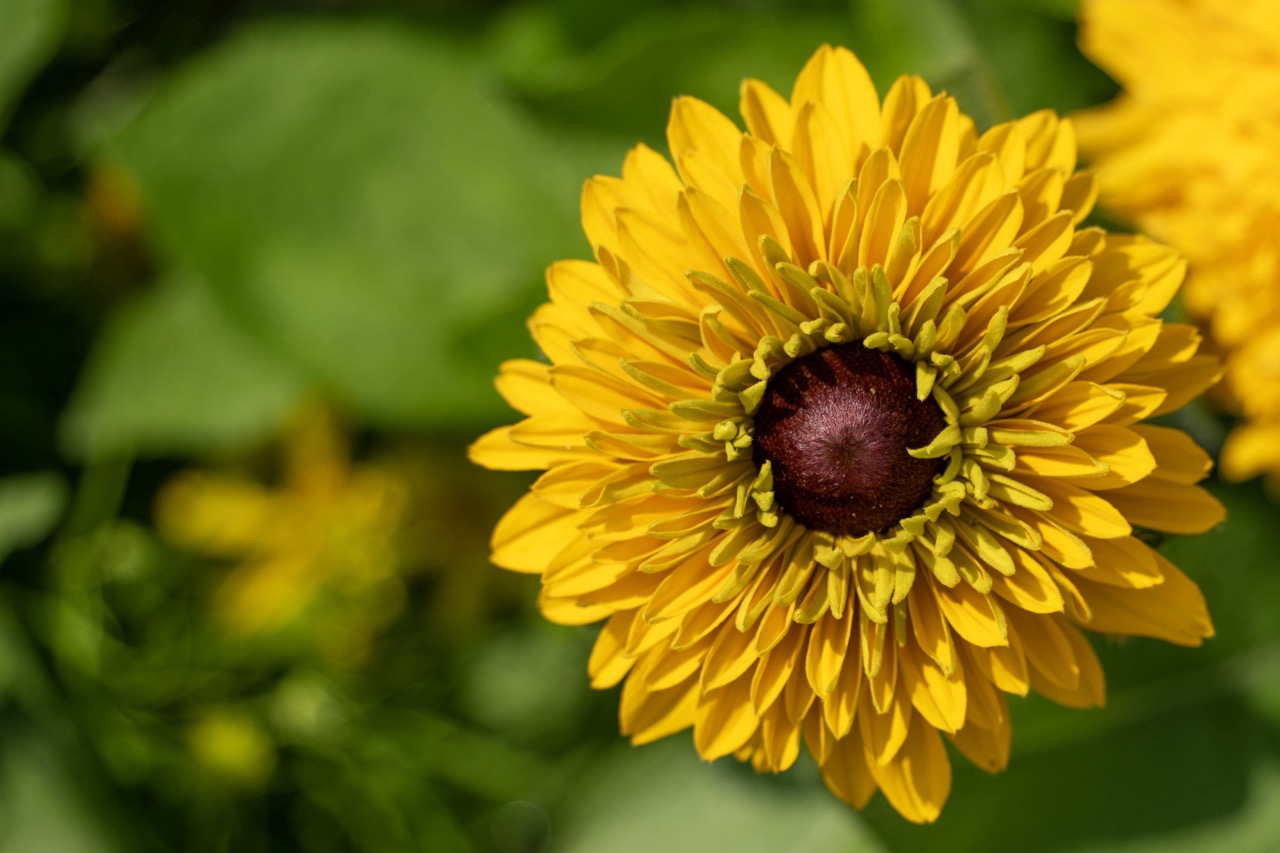

1. Overall Rating (0–10) — 8.0
This image captures the vibrant essence of a sunflower in full bloom, radiating warmth and vitality through its rich, saturated colors and delicate textures. The shallow depth of field isolates the flower with striking clarity, drawing the viewer into its intricate center. While the composition is strong and the lighting is natural, a more dynamic angle or tighter framing could elevate its emotional resonance beyond mere botanical beauty.
2. Composition (0–10) — 7.5
The flower is positioned slightly off-center, creating a natural, organic feel, though the diagonal tilt of the bloom introduces a subtle tension. The soft, out-of-focus background enhances the subject’s prominence, with the surrounding greenery and hints of other blooms adding depth without distraction.
3. Lighting (0–10) — 9.0
Natural sunlight bathes the flower in a warm, even glow, accentuating the golden petals and casting gentle shadows that add dimension. The light highlights the texture of the center and the delicate edges of the petals, enhancing the image’s organic feel.
4. Color & Tone (0–10) — 8.5
The vivid yellow of the petals contrasts beautifully with the deep brown center and lush green backdrop, creating a harmonious, natural palette. The warm tones evoke a sense of summer and growth, while the tonal range remains balanced and pleasing to the eye.
5. Creativity (0–10) — 7.0
While the image is technically sound and visually appealing, its approach is conventional—focusing on natural beauty rather than conceptual or narrative innovation. The choice to emphasize texture and color over symbolism keeps it grounded in realism.
6. Technical Quality (0–10) — 9.0
The photograph is sharp and well-focused on the flower’s center, with excellent detail in the petals and stamen. The depth of field is precisely managed, and there are no visible technical flaws such as noise or lens distortion.
7. Emotional Impact (0–10) — 8.0
The image evokes a sense of joy and tranquility, capturing the simple beauty of nature in a way that feels both intimate and uplifting. The warm tones and soft focus create a moment of stillness that resonates with viewers, inviting a quiet appreciation of the natural world.
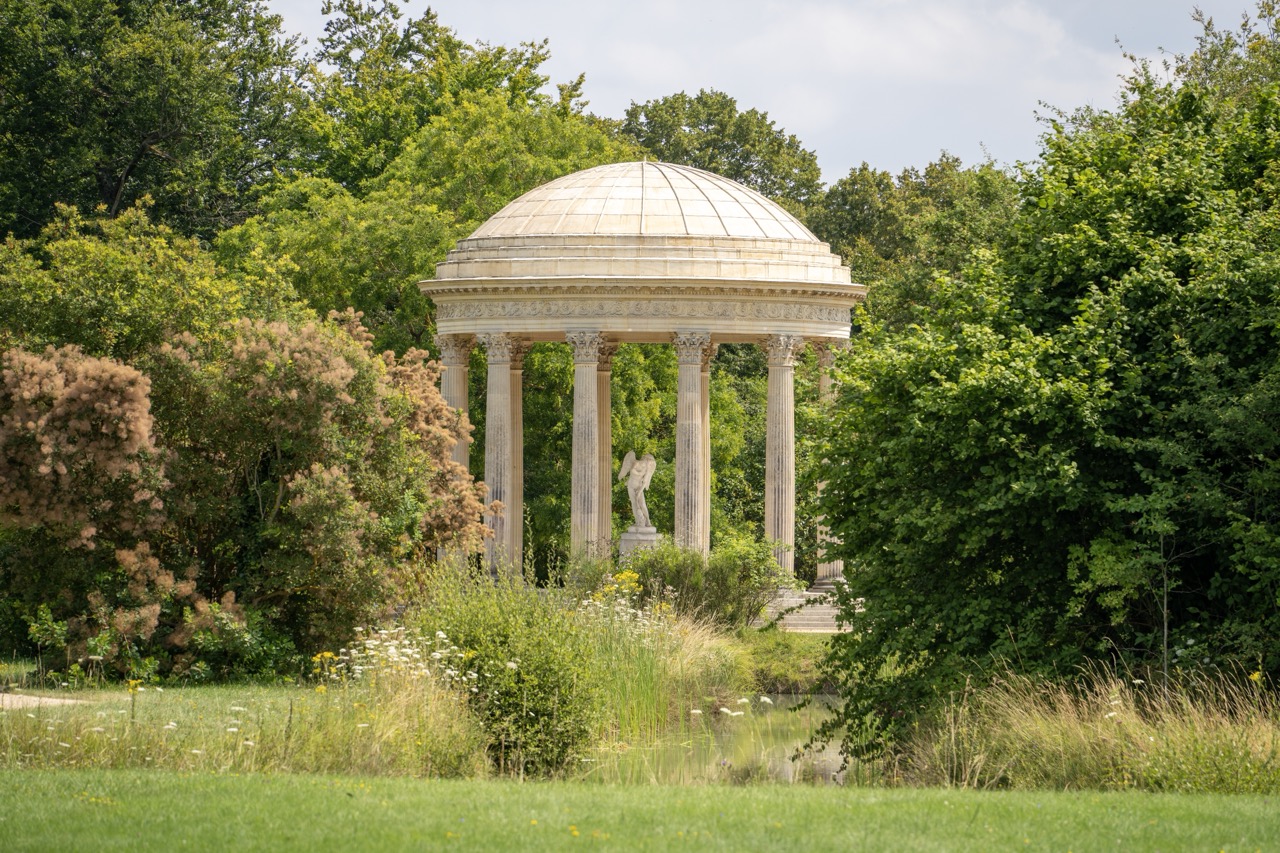

1. Overall Rating (0–10) — 7.5
This photograph captures a serene classical pavilion nestled within a lush, overgrown garden, evoking a sense of timelessness and quiet decay. The interplay between the man-made structure and the encroaching natural world creates a poetic tension, suggesting nature’s slow reclamation of human artifice. While the image is visually rich and conceptually layered, its slightly muted tonality and soft focus temper its emotional punch, leaving the viewer with a contemplative but not overwhelming impression.
2. Composition (0–10) — 8.0
The pavilion is centered within a natural frame of trees and foliage, creating a balanced and harmonious composition. The foreground grasses and wildflowers add depth and lead the eye toward the structure, while the statue within the colonnade provides a focal point that enhances the narrative quality.
3. Lighting (0–10) — 7.0
Soft, diffused daylight evenly illuminates the scene, minimizing harsh shadows and allowing the textures of stone and foliage to emerge with clarity. The overcast sky lends a gentle, contemplative mood, though a touch more directional light might have enhanced the sculptural form of the columns and dome.
4. Color & Tone (0–10) — 7.5
The palette is rich with natural greens and the pale cream of the stone, creating a harmonious and calming visual rhythm. The subtle contrast between the warm-toned foliage and the cool, neutral architecture adds depth, while the overall tone remains restrained and understated.
5. Creativity (0–10) — 8.0
The image succeeds in blending classical architecture with organic, untamed nature, suggesting themes of impermanence and the passage of time. The inclusion of the statue within the pavilion adds a layer of storytelling, inviting interpretation beyond the mere documentation of a place.
6. Technical Quality (0–10) — 8.5
The image is sharp and detailed, particularly in the midground and background, with a deep depth of field that keeps both the pavilion and surrounding flora in focus. The exposure is well-managed, with no obvious over- or underexposed areas, and the camera’s resolution captures fine textures in stone and plant life.
7. Emotional Impact (0–10) — 7.0
The photograph evokes a quiet melancholy and reverence for the past, with the pavilion standing as a silent witness to time’s erosion. The lush, almost wild setting enhances a sense of solitude and introspection, making the viewer feel like a quiet observer of a forgotten moment.
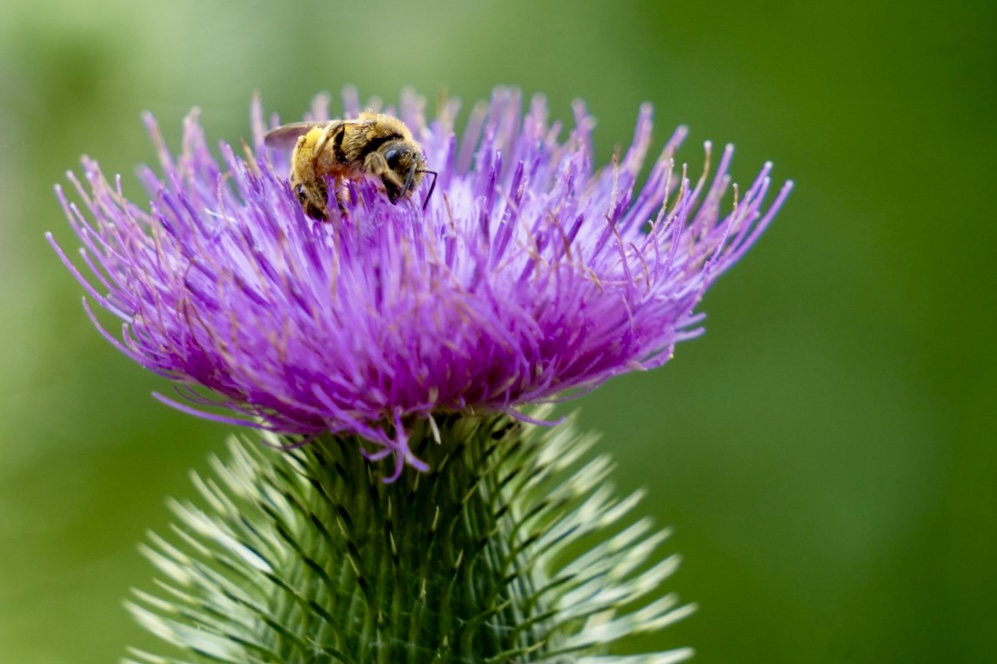

1. Overall Rating (0–10) — 8.0
This photograph captures a moment of delicate interaction between a bee and a thistle, where natural detail and vibrant color converge to create a visually arresting scene. The shallow depth of field isolates the subject with painterly precision, emphasizing the intricate textures of the flower and the insect’s fine hairs. While the composition is strong and the focus is sharp, the image’s quiet stillness, though beautiful, lacks a sense of motion or narrative tension that could elevate it further.
2. Composition (0–10) — 8.5
The bee is positioned slightly off-center, drawing the eye naturally across the frame while maintaining balance. The tight framing emphasizes the subject, and the diagonal tilt of the thistle adds subtle dynamism without disrupting harmony.
3. Lighting (0–10) — 8.0
Soft, diffused natural light enhances the flower’s rich purple without harsh shadows, allowing the textures of the petals and the bee’s body to emerge with clarity. The even illumination supports the image’s intimate, observational tone.
4. Color & Tone (0–10) — 9.0
The vivid purple of the thistle contrasts beautifully with the lush green background, creating a striking complementary palette. The colors are rich yet natural, with a warm, organic tone that enhances the scene’s vitality.
5. Creativity (0–10) — 7.5
While the subject is familiar, the photographer’s choice of tight framing and shallow depth of field transforms a common natural moment into something more contemplative and artistic. The image invites close inspection, rewarding the viewer with detail and nuance.
6. Technical Quality (0–10) — 9.0
The focus is precise on the bee and flower head, with sharp detail throughout the subject. The background is smoothly blurred, demonstrating excellent control of aperture and focus, and the image is free of noise or artifacts.
7. Emotional Impact (0–10) — 7.0
The image evokes a sense of quiet wonder and connection to the natural world, capturing the delicate beauty of a fleeting moment. While it doesn’t elicit strong emotion, it lingers in the mind as a serene, meditative portrait of life in miniature.
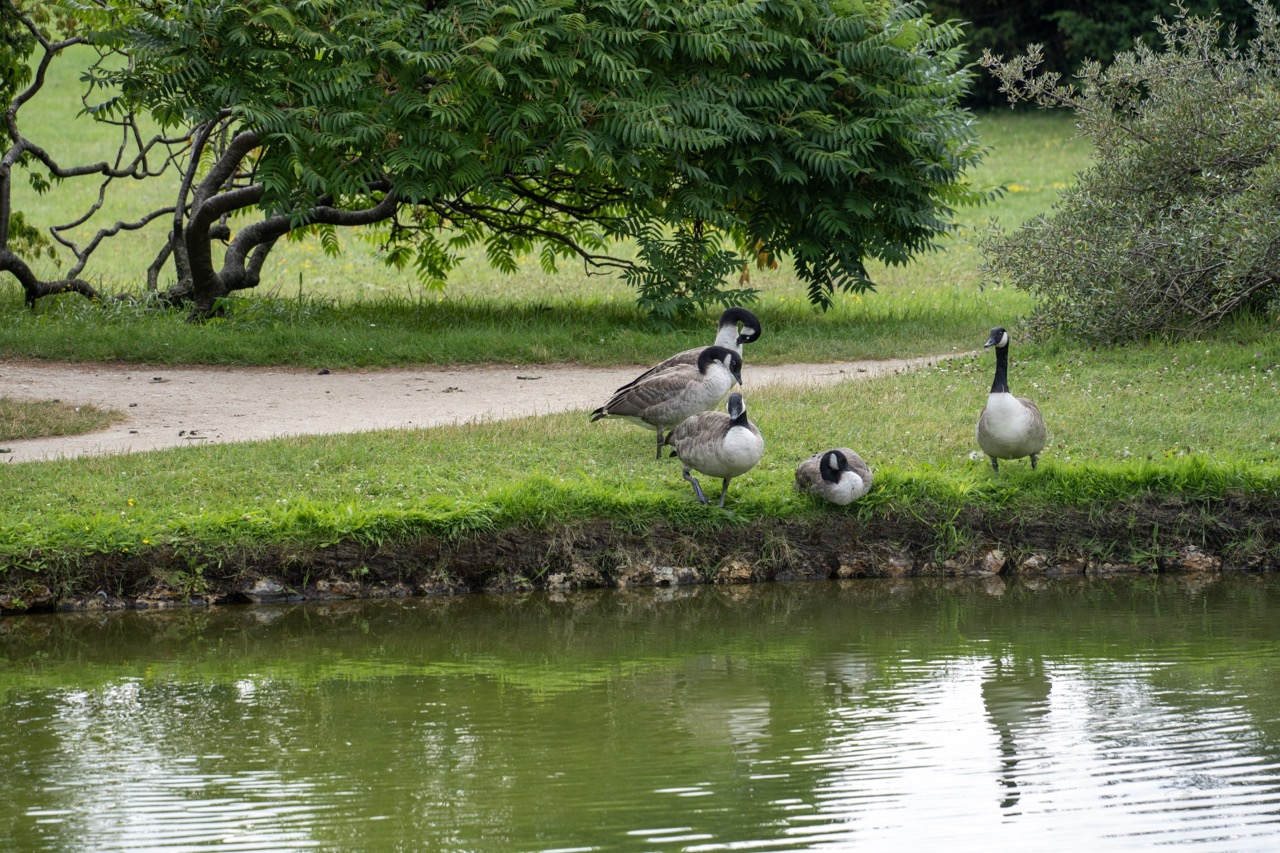

1. Overall Rating (0–10) — 7.0
This photograph captures a serene moment in a park, where a small group of geese rests along the edge of a calm pond, evoking a sense of quiet natural harmony. The lush greenery and soft light lend a tranquil mood, though the composition feels slightly unbalanced, with the main subjects clustered too closely to the right. While the image effectively conveys a peaceful outdoor scene, it lacks the visual dynamism to fully engage the viewer.
2. Composition (0–10) — 6.0
The geese are grouped on the right, creating an asymmetrical balance that draws the eye but leaves the left side underutilized. The diagonal path and tree branch add depth, but the framing feels slightly off-center and could benefit from tighter focus on the subjects.
3. Lighting (0–10) — 7.0
Soft, diffused daylight evenly illuminates the scene, enhancing the natural tones of the grass and water without harsh shadows. The gentle light contributes to the calm, contemplative atmosphere.
4. Color & Tone (0–10) — 7.0
The palette is dominated by rich greens and earthy browns, with the white and black markings of the geese providing subtle contrast. The water reflects the surrounding foliage, creating a cohesive and harmonious tonal range.
5. Creativity (0–10) — 6.0
The image is a straightforward documentation of wildlife in a park setting, capturing a moment of stillness rather than a bold artistic statement. While the natural setting is engaging, the approach is more observational than interpretive.
6. Technical Quality (0–10) — 8.0
The focus is sharp on the geese and the immediate foreground, with good clarity throughout the frame. The exposure is well-balanced, and there are no noticeable technical flaws.
7. Emotional Impact (0–10) — 6.5
The photograph evokes a sense of peace and quiet contemplation, inviting the viewer to pause and reflect on a simple moment in nature. The emotional resonance is gentle and understated, making it pleasant but not deeply stirring.


1. Overall Rating (0–10) — 8.0
This image captures the delicate yet defiant beauty of a thistle in full bloom, where nature’s resilience is rendered with striking clarity. The soft focus background and sharp subject placement create a serene, almost painterly quality, emphasizing the flower’s intricate textures. While the composition is strong and emotionally resonant, the simplicity of the palette slightly limits its visual dynamism.
2. Composition (0–10) — 8.5
The thistle is positioned along the left third of the frame, creating a balanced and visually engaging asymmetry. The negative space on the right enhances the sense of stillness and allows the viewer’s eye to rest on the subject’s detailed form.
3. Lighting (0–10) — 8.0
Natural, diffused light softly illuminates the thistle, highlighting the fine hairs and spines without harsh shadows. The gentle glow enhances the flower’s purple hues and gives the image a calm, organic feel.
4. Color & Tone (0–10) — 7.5
The vibrant purple of the thistle contrasts beautifully with the lush green background, creating a harmonious and natural palette. While the colors are true to life, a touch more saturation could heighten the emotional impact.
5. Creativity (0–10) — 8.0
The choice to focus on a thistle—a symbol of both beauty and defiance—adds narrative depth. The macro perspective transforms an ordinary plant into a subject of quiet elegance, demonstrating thoughtful artistic intent.
6. Technical Quality (0–10) — 9.0
Exceptional sharpness on the thistle, with precise focus and clean depth of field. The image is technically flawless, with no visible noise or blur.
7. Emotional Impact (0–10) — 7.5
The image evokes a sense of quiet strength and natural grace, inviting reflection on the beauty found in overlooked elements of the wild. It feels intimate and meditative, though not overtly dramatic.
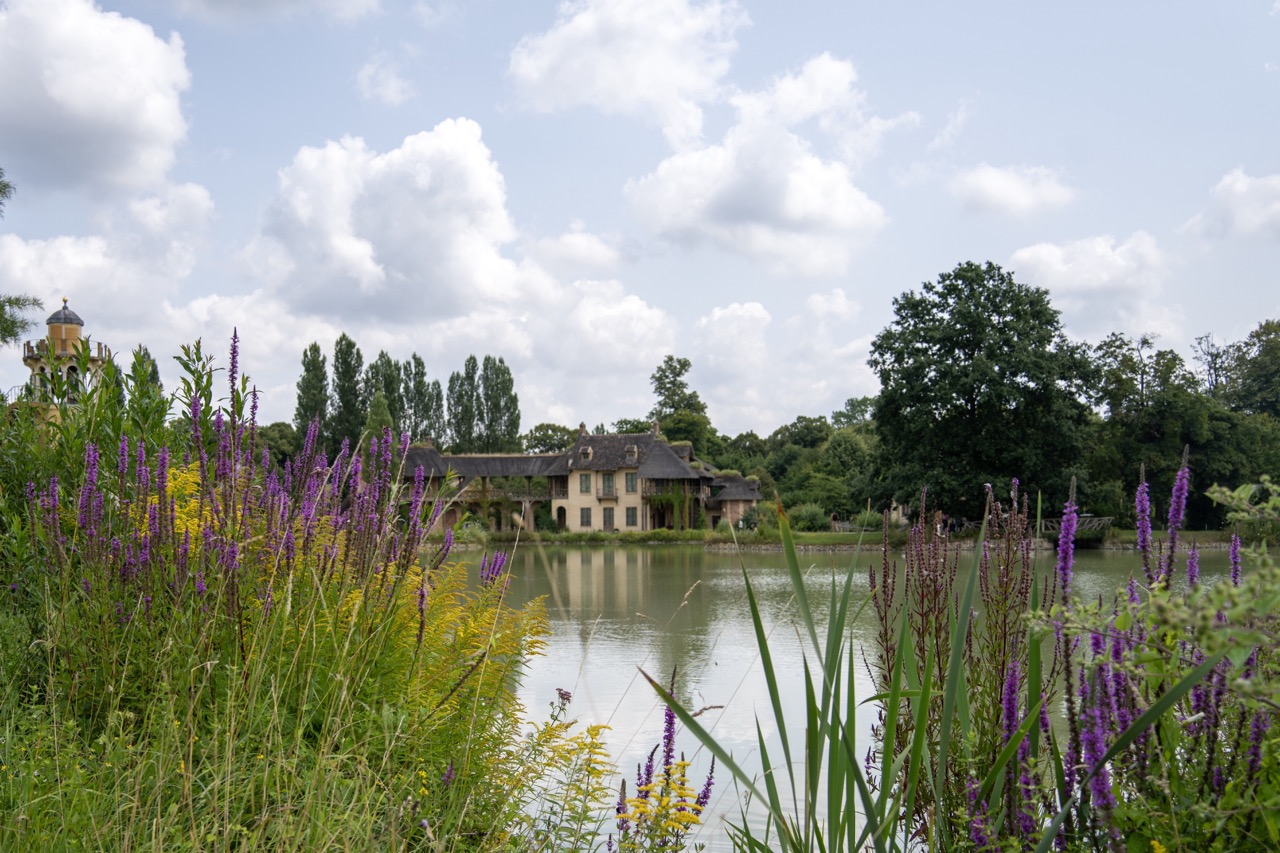

1. Overall Rating (0–10) — 7.5
This photograph captures a serene, pastoral landscape where nature and architecture exist in quiet harmony. The vibrant purple and yellow wildflowers in the foreground create a striking contrast with the calm, reflective water and the stately building beyond, evoking a sense of timeless beauty. While the composition is strong and the scene inviting, the image lacks a compelling focal point, leaving the viewer’s gaze to wander without a clear narrative anchor.
2. Composition (0–10) — 7.0
The framing uses the wildflowers as a natural foreground, adding depth and guiding the eye toward the building across the pond. However, the central subject is slightly off-center and partially obscured by foliage, which weakens the visual balance and diminishes the impact of the architectural focal point.
3. Lighting (0–10) — 7.5
Soft, diffused daylight enhances the scene’s tranquil mood, with gentle shadows and even exposure across the landscape. The clouds scatter the light effectively, minimizing harsh contrasts and allowing subtle textures in the water and foliage to emerge.
4. Color & Tone (0–10) — 8.0
The palette is rich and harmonious, with the vivid purples and yellows of the wildflowers complementing the earthy tones of the building and the soft blues of the sky. The natural color balance enhances the scene’s authenticity and visual appeal.
5. Creativity (0–10) — 7.0
The image is a strong example of landscape photography that emphasizes natural beauty and serenity. While it is not particularly inventive in its approach, it effectively captures the mood of the setting and uses foreground elements to add visual interest.
6. Technical Quality (0–10) — 8.0
The image is sharp and well-focused, with fine detail visible in both the foreground flora and the distant architecture. The exposure is balanced, and there is minimal noise, indicating a high level of technical control.
7. Emotional Impact (0–10) — 8.0
The photograph evokes a sense of peace and contemplation, inviting the viewer to imagine a quiet afternoon by the water. The lush, untamed vegetation and distant elegance of the building combine to create a feeling of escape and tranquility.
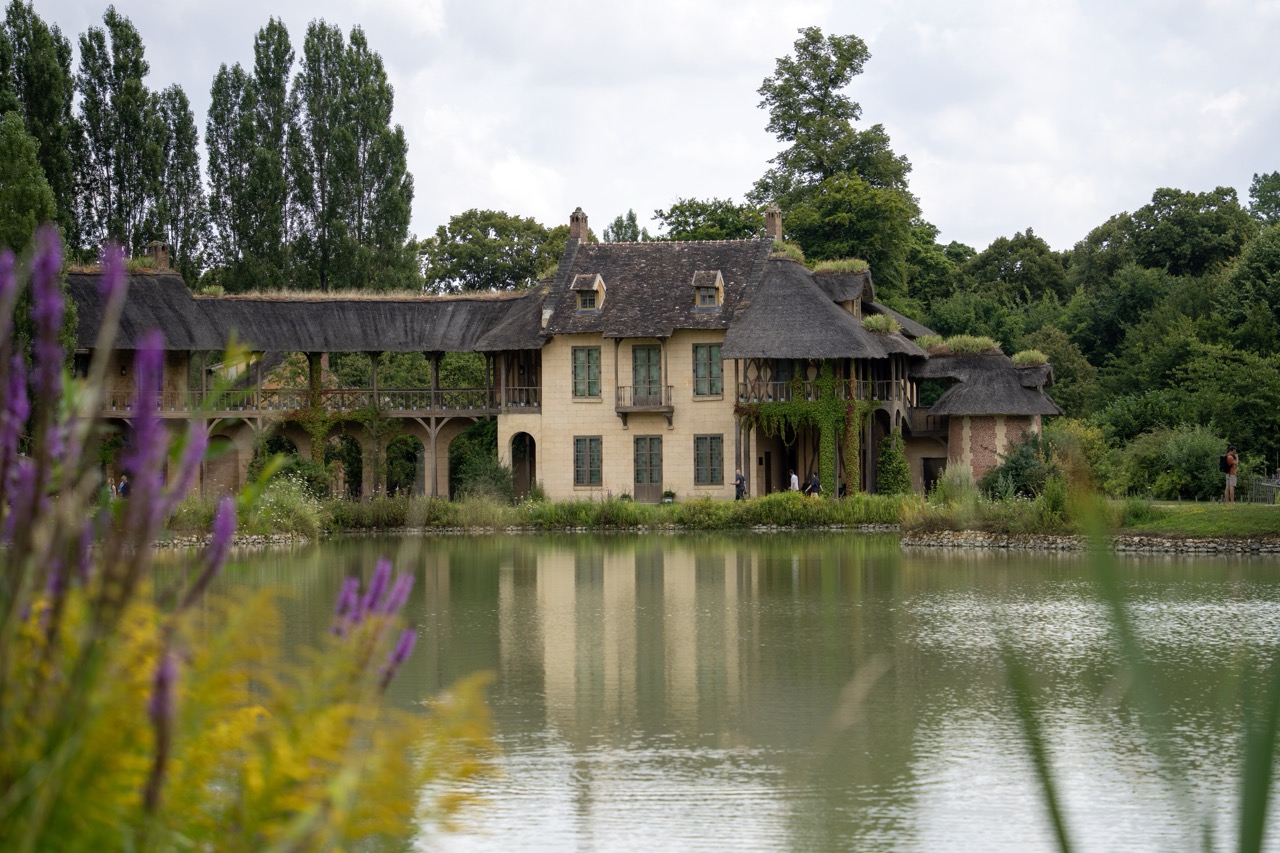

1. Overall Rating (0–10) — 7.0
This photograph captures a serene and picturesque estate nestled within a lush, natural landscape, where architecture harmonizes with its environment. The composition balances architectural detail with the softness of nature, creating a tranquil and inviting atmosphere. While the image is visually rich and evocative, the slightly overcast lighting and soft focus in the foreground prevent it from achieving a more striking presence.
2. Composition (0–10) — 7.5
The structure is centered and framed by the surrounding foliage and water, creating a balanced and immersive scene. The use of foreground flowers adds depth and draws the eye into the image, though their soft focus slightly dilutes the overall sharpness.
3. Lighting (0–10) — 6.0
Diffused daylight under an overcast sky softens the scene, minimizing harsh shadows and allowing for even exposure across the frame. While this creates a calm mood, it also reduces contrast and visual drama.
4. Color & Tone (0–10) — 6.5
The palette is dominated by earthy greens and muted beiges, with pops of purple from the foreground flora adding a touch of vibrancy. The tonal range is subdued, lending a naturalistic but somewhat flat appearance.
5. Creativity (0–10) — 7.0
The interplay between architecture and nature is thoughtfully captured, emphasizing the harmony between human design and the organic world. The choice of foreground framing adds a painterly quality, enhancing the scene’s narrative depth.
6. Technical Quality (0–10) — 7.5
The image is sharp in the mid-ground, with good detail in the building’s structure and textures. Focus is appropriately selective, but the foreground elements are slightly soft, which is intentional but limits overall clarity.
7. Emotional Impact (0–10) — 7.0
The photograph evokes a sense of peace and timelessness, inviting the viewer to imagine a quiet retreat. The reflection in the water and the gentle presence of greenery contribute to a meditative and contemplative mood.
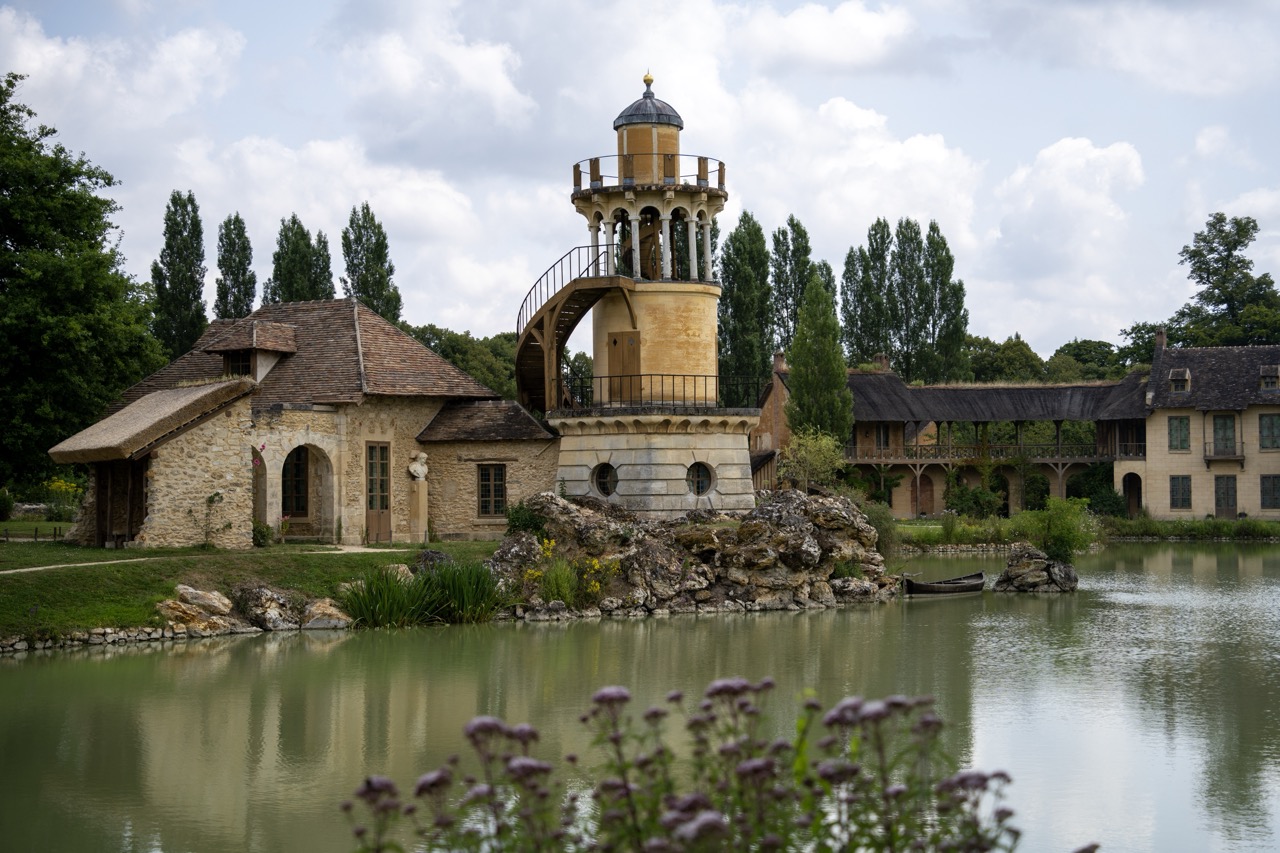

1. Overall Rating (0–10) — 7.5
This photograph captures a serene and historically rich landscape, where architecture and nature harmonize in quiet elegance. The central lighthouse-like tower rises with a sense of purpose against a soft, cloud-dappled sky, while the surrounding water and lush greenery lend a timeless tranquility. The image’s strength lies in its atmospheric balance, though the slightly muted color palette tempers its visual punch.
2. Composition (0–10) — 8.0
The frame is well-balanced, with the tower anchoring the center and the foreground flowers adding depth. The placement of the buildings and trees creates a layered, immersive perspective that draws the eye into the scene.
3. Lighting (0–10) — 7.0
Diffused daylight softens the scene, reducing harsh shadows and enhancing the tranquil mood. The overcast sky lends even illumination, though it slightly flattens the textures of the stone and water.
4. Color & Tone (0–10) — 6.5
The palette is natural and restrained, dominated by earthy tones and muted greens. While harmonious, the lack of vibrant contrast limits the image’s visual energy.
5. Creativity (0–10) — 7.0
The composition evokes a sense of romanticism and historical contemplation, using the juxtaposition of man-made structures and natural elements to suggest a narrative of quiet permanence.
6. Technical Quality (0–10) — 8.0
The image is sharp and detailed, with a clear focus on the central tower and foreground elements. The depth of field is well-managed, keeping both the foreground and background in readable focus.
7. Emotional Impact (0–10) — 7.5
The photograph conveys a sense of peace and timelessness, inviting quiet reflection. The stillness of the water and the weathered architecture evoke nostalgia and a subtle melancholy, resonating with viewers on an introspective level.
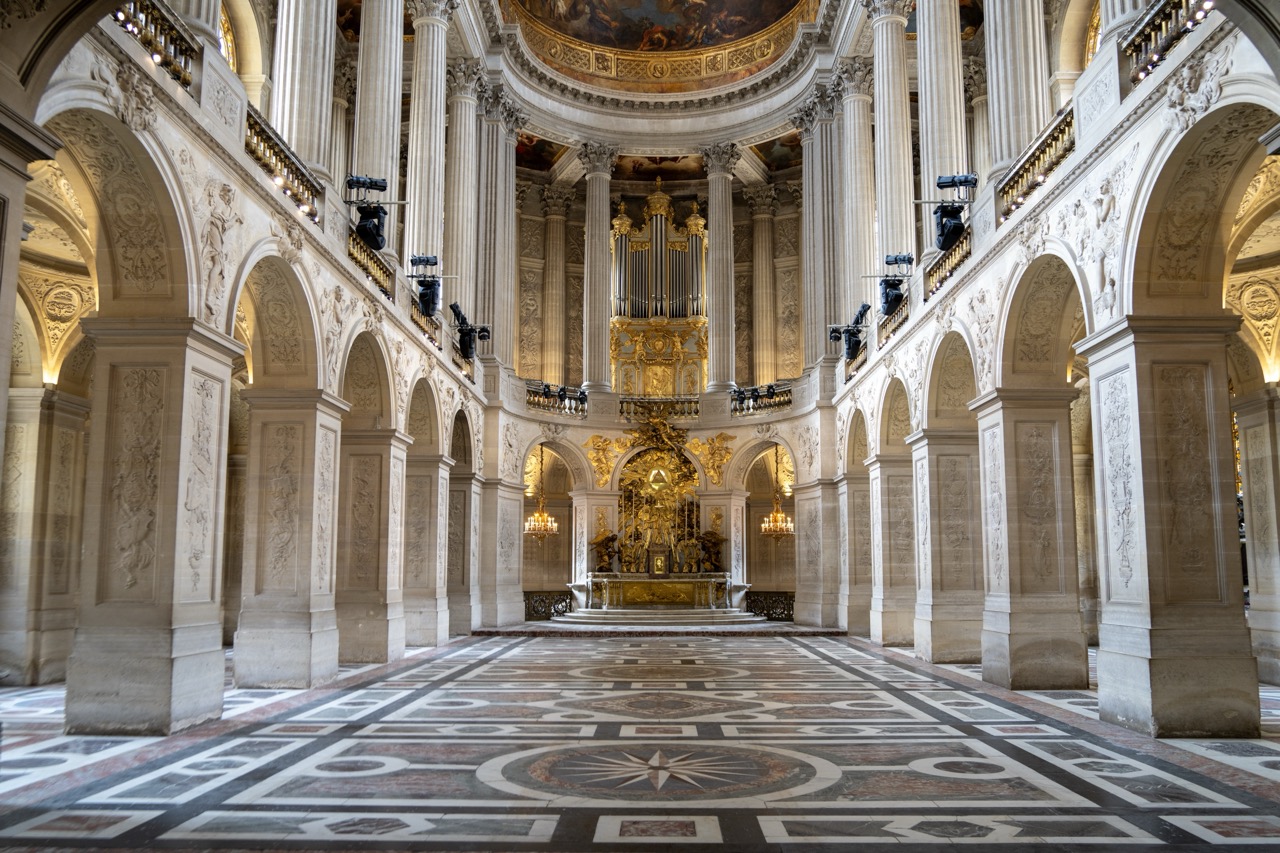

1. Overall Rating (0–10) — 8.5
This photograph captures the grandeur of a Baroque cathedral interior with striking clarity and reverence, where architectural opulence meets spiritual solemnity. The symmetrical composition and warm lighting amplify the sense of awe, while the intricate details of the marble floor and gilded altar invite contemplation. Though the modern lighting fixtures subtly disrupt the historical ambiance, the image remains a powerful testament to both artistic craftsmanship and architectural majesty.
2. Composition (0–10) — 9.0
The strong central symmetry guides the eye directly to the altar, creating a sense of balance and order. The repeating arches and columns frame the space beautifully, enhancing depth and perspective.
3. Lighting (0–10) — 8.0
Warm, ambient lighting highlights the golden elements and sculptural details, while the soft glow from chandeliers adds depth and atmosphere. The use of artificial fixtures is practical but slightly intrusive.
4. Color & Tone (0–10) — 8.5
The palette of cream, gold, and deep marble tones conveys richness and solemnity. The contrast between the light stone and dark flooring enhances visual texture and rhythm.
5. Creativity (0–10) — 8.0
The image successfully merges architectural documentation with artistic storytelling, emphasizing both scale and sacred detail. The choice to include modern lighting subtly comments on the intersection of past and present.
6. Technical Quality (0–10) — 9.0
Exceptionally sharp focus, precise exposure, and accurate detail capture across the frame reflect high technical proficiency and careful composition.
7. Emotional Impact (0–10) — 9.0
The photograph evokes a profound sense of reverence and timelessness, inviting viewers to feel the weight of history and devotion embedded in the space.
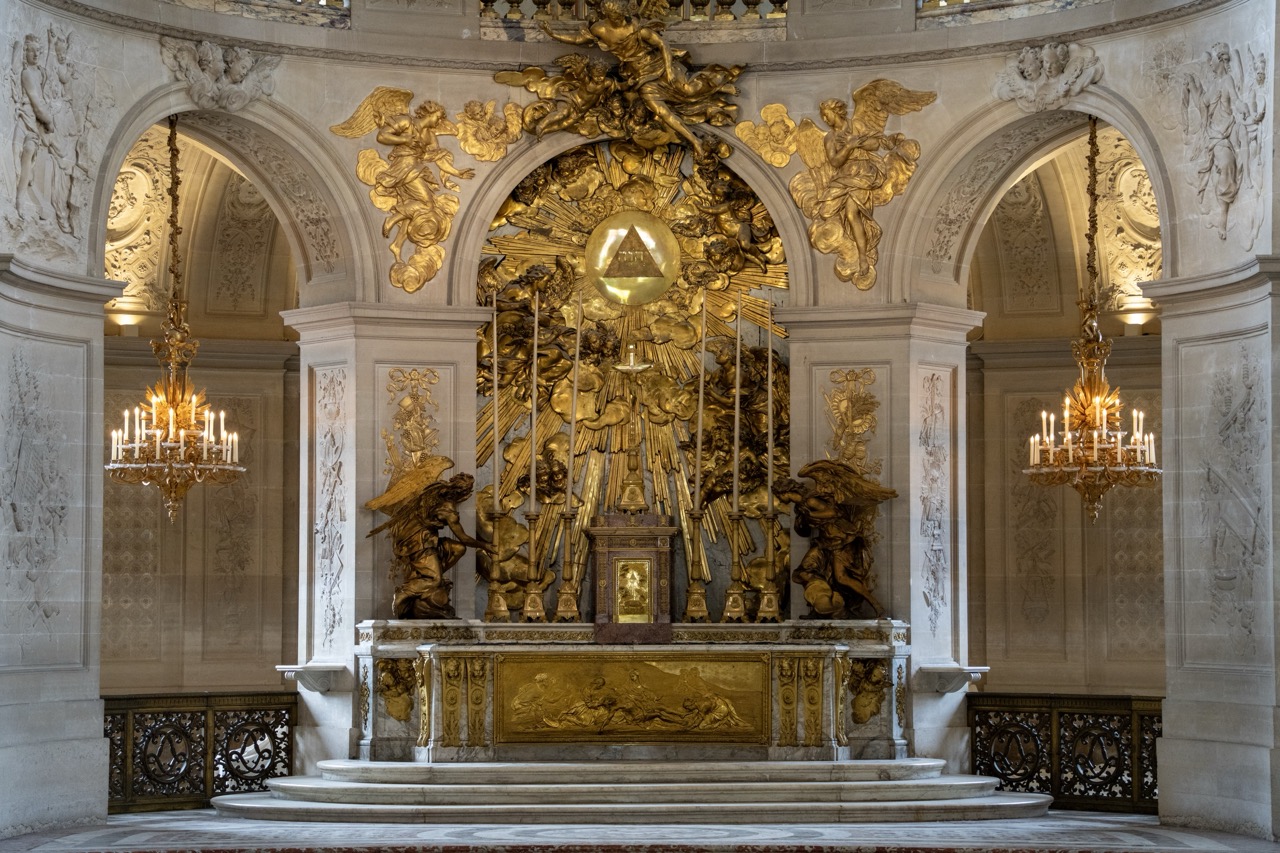

1. Overall Rating (0–10) — 9.0
This photograph captures the opulent grandeur of a Baroque chapel with striking clarity, where light and gold converge to evoke a sense of divine transcendence. The composition is rich in detail and symbolism, with the central altar radiating a celestial glow that draws the eye upward, while the symmetry and ornate craftsmanship lend a timeless majesty. The only slight limitation is the absence of human presence, which keeps the scene from feeling fully alive, though its stillness is also part of its solemn power.
2. Composition (0–10) — 9.5
The symmetrical framing centers the altar with precision, creating a balanced and harmonious structure. The arches and flanking chandeliers act as visual guides, drawing attention toward the central golden motif. The layered depth, from the foreground steps to the intricate ceiling details, enhances the sense of space and reverence.
3. Lighting (0–10) — 9.0
The warm, directional lighting accentuates the gilded surfaces, creating a luminous glow that highlights the three-dimensional textures of the carvings. The interplay between light and shadow adds depth and drama, while the chandeliers provide a soft, ambient glow that enhances the sacred atmosphere.
4. Color & Tone (0–10) — 9.0
The palette of gold, cream, and soft stone tones creates a regal and harmonious visual experience. The golden hues dominate with richness and consistency, while the neutral background allows the ornate details to stand out. The tonal contrast is subtle yet effective, enhancing the image’s luxurious and reverent mood.
5. Creativity (0–10) — 8.5
The image succeeds in capturing not just a space, but a feeling—the spiritual intensity of a sacred environment. The photographer’s choice to emphasize symmetry and light elevates the scene beyond mere documentation, transforming it into a contemplative and almost theatrical portrayal of religious artistry.
6. Technical Quality (0–10) — 9.5
The image is exceptionally sharp, with crisp detail throughout the intricate carvings and gilded elements. The focus is precise, and the exposure is well-balanced, preserving both highlights and shadows without clipping. The high resolution allows for appreciation of fine textures, from the marble to the metallic finishes.
7. Emotional Impact (0–10) — 9.0
The photograph conveys a profound sense of awe and reverence, inviting the viewer into a space of spiritual contemplation. The grandeur and stillness evoke a quiet reverence, making the image feel both intimate and monumental—a powerful testament to the enduring beauty of religious architecture.


1. Overall Rating (0–10) — 8.5
This photograph captures the grandeur and opulence of a Baroque chapel with striking clarity, where architectural symmetry and golden ornamentation converge to evoke a sense of divine majesty. The composition draws the eye toward the altar and organ, emphasizing the space’s spiritual and artistic significance, while the clean, balanced framing allows the intricate details to resonate without distraction. A slight coolness in the lighting tempers the warmth of the gold, but the image remains powerfully evocative of historical reverence and artistic mastery.
2. Composition (0–10) — 9.0
The centered, symmetrical framing emphasizes the architectural harmony, with the organ and altar serving as strong focal points. The repeating arches and columns guide the viewer’s gaze upward and inward, enhancing the sense of depth and reverence.
3. Lighting (0–10) — 7.5
The lighting is even and well-distributed, highlighting the textures of the marble and gold without harsh shadows. While the cool tone slightly dampens the warmth of the gilded elements, the strategic use of artificial lights from above and below accentuates the sculptural details.
4. Color & Tone (0–10) — 8.0
The palette of cream, gold, and muted stone tones creates a regal and cohesive visual language. The contrast between the warm gold and the cool marble enhances the sense of luxury, while the patterned floor adds rhythmic complexity to the lower third.
5. Creativity (0–10) — 8.5
The photographer captures the space not merely as a record, but as a celebration of Baroque artistry. The choice to emphasize symmetry and verticality transforms the interior into a visual hymn, with the interplay of light, texture, and architecture conveying a narrative of faith and power.
6. Technical Quality (0–10) — 9.0
The image is sharp, with excellent detail in the carvings, pipes, and chandeliers. The focus is consistent across the frame, and the exposure is well-balanced, preserving detail in both the highlights and shadows.
7. Emotional Impact (0–10) — 9.0
The photograph inspires awe and reverence, evoking the solemnity and grandeur of a sacred space. The viewer is drawn into the stillness and magnificence of the chapel, feeling the weight of history and devotion in every ornate detail.
Loading map...